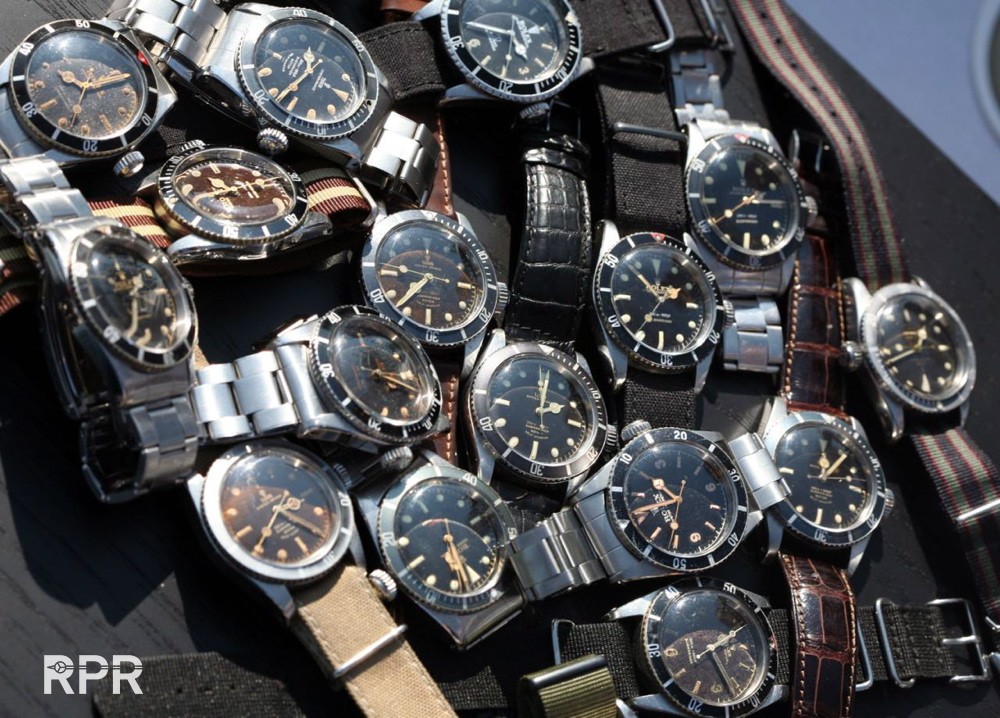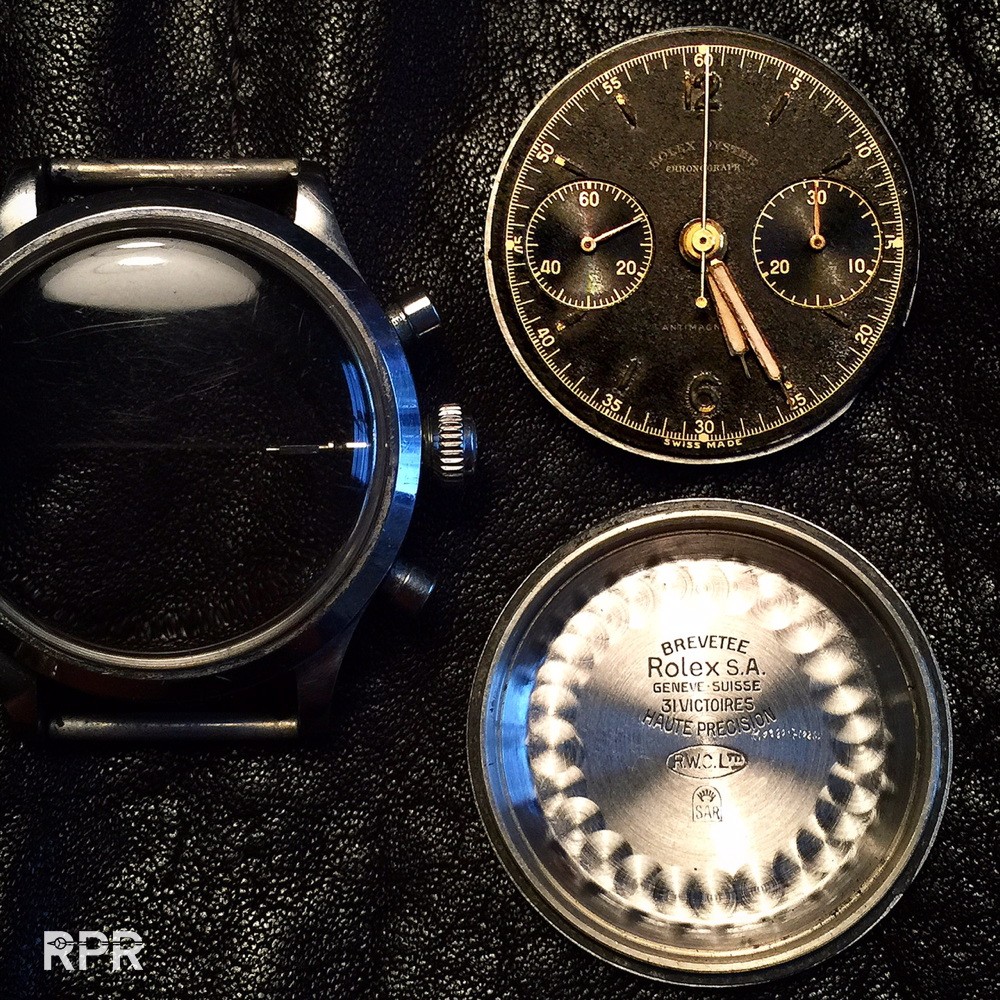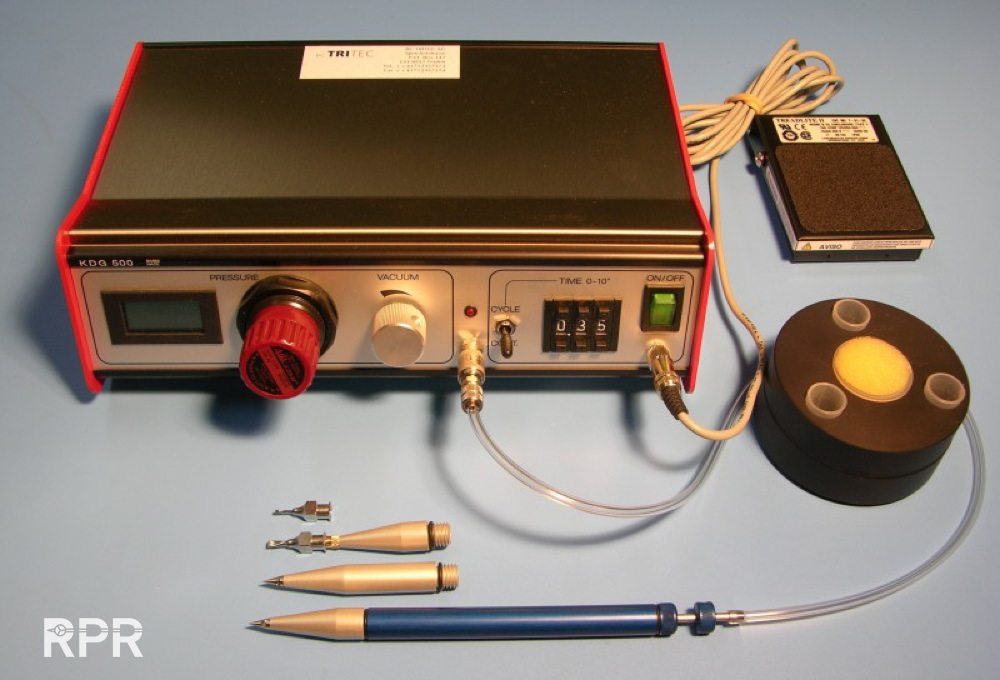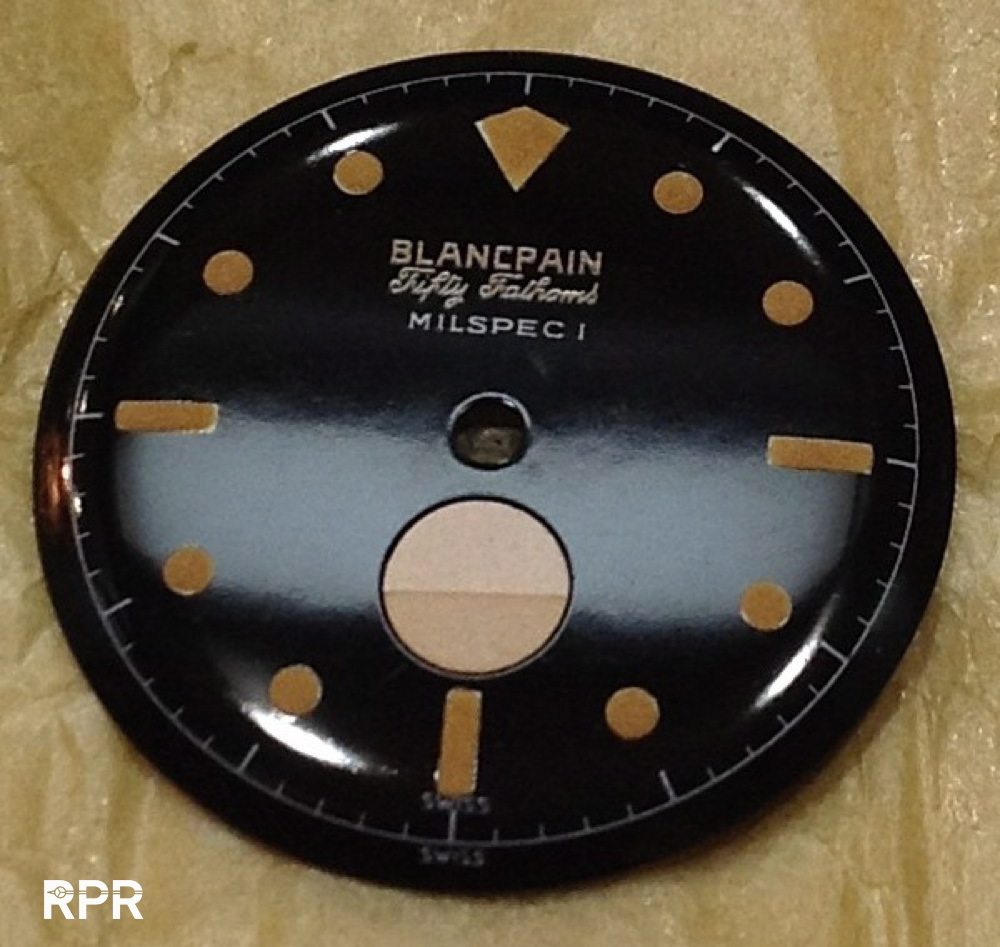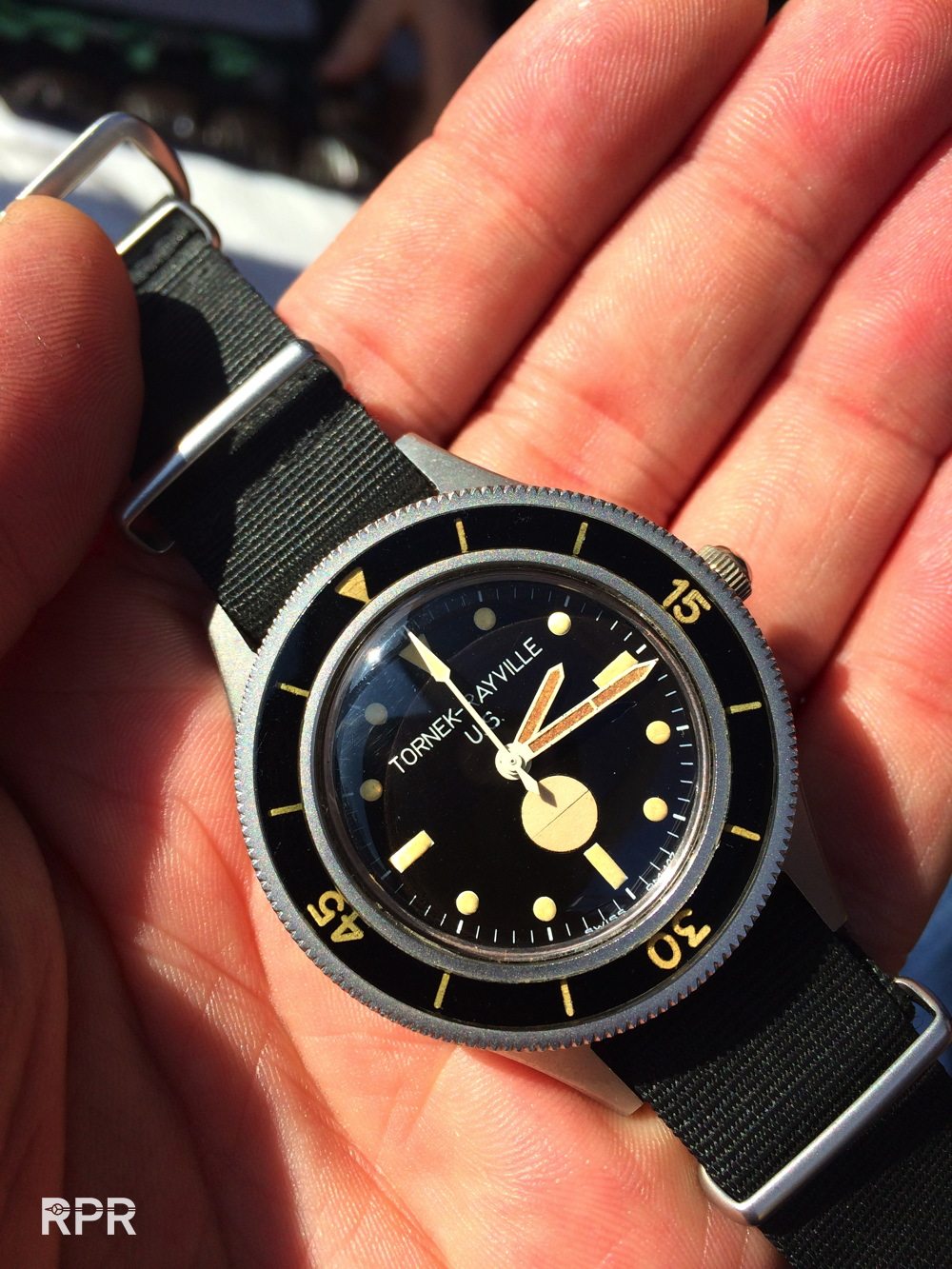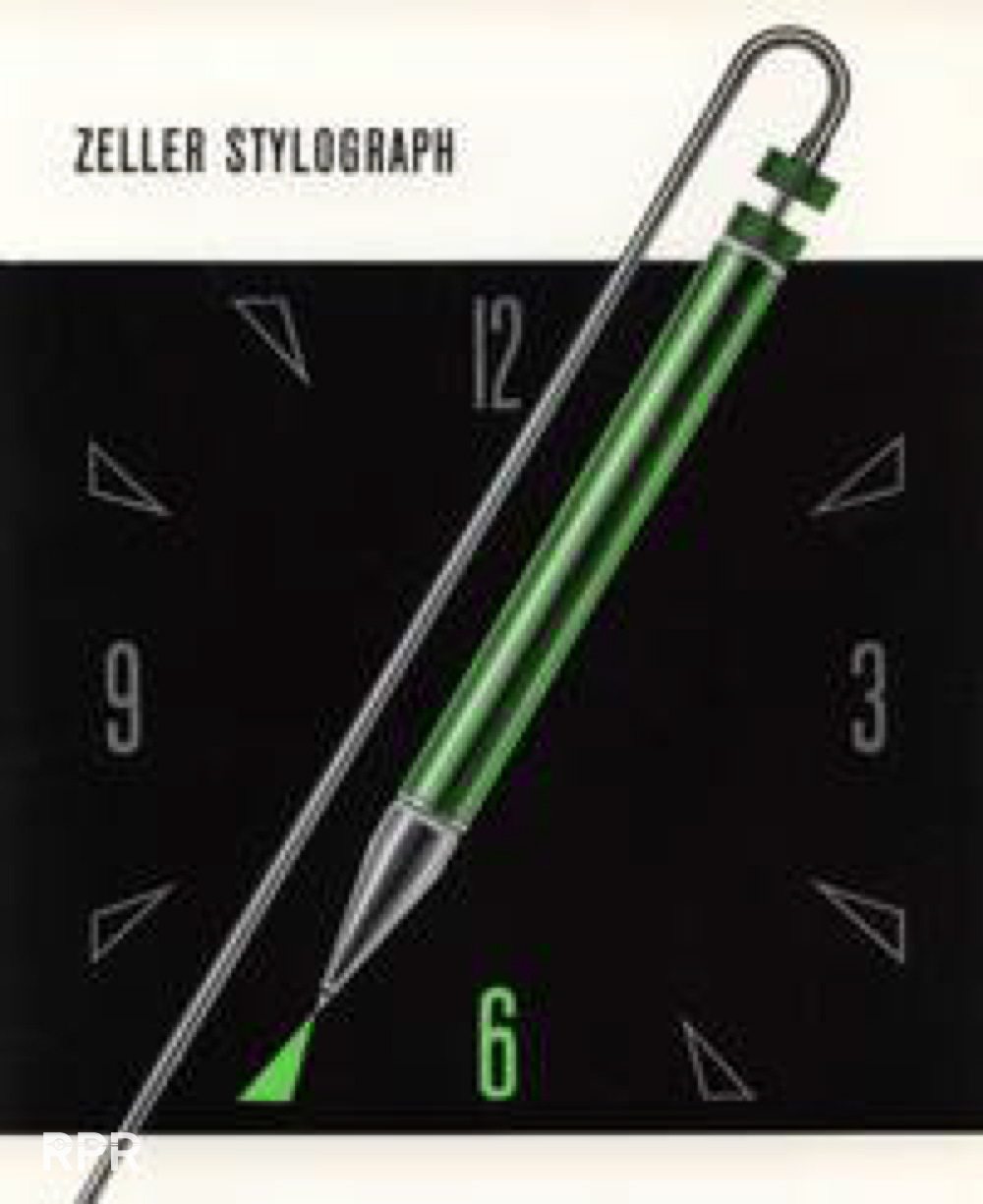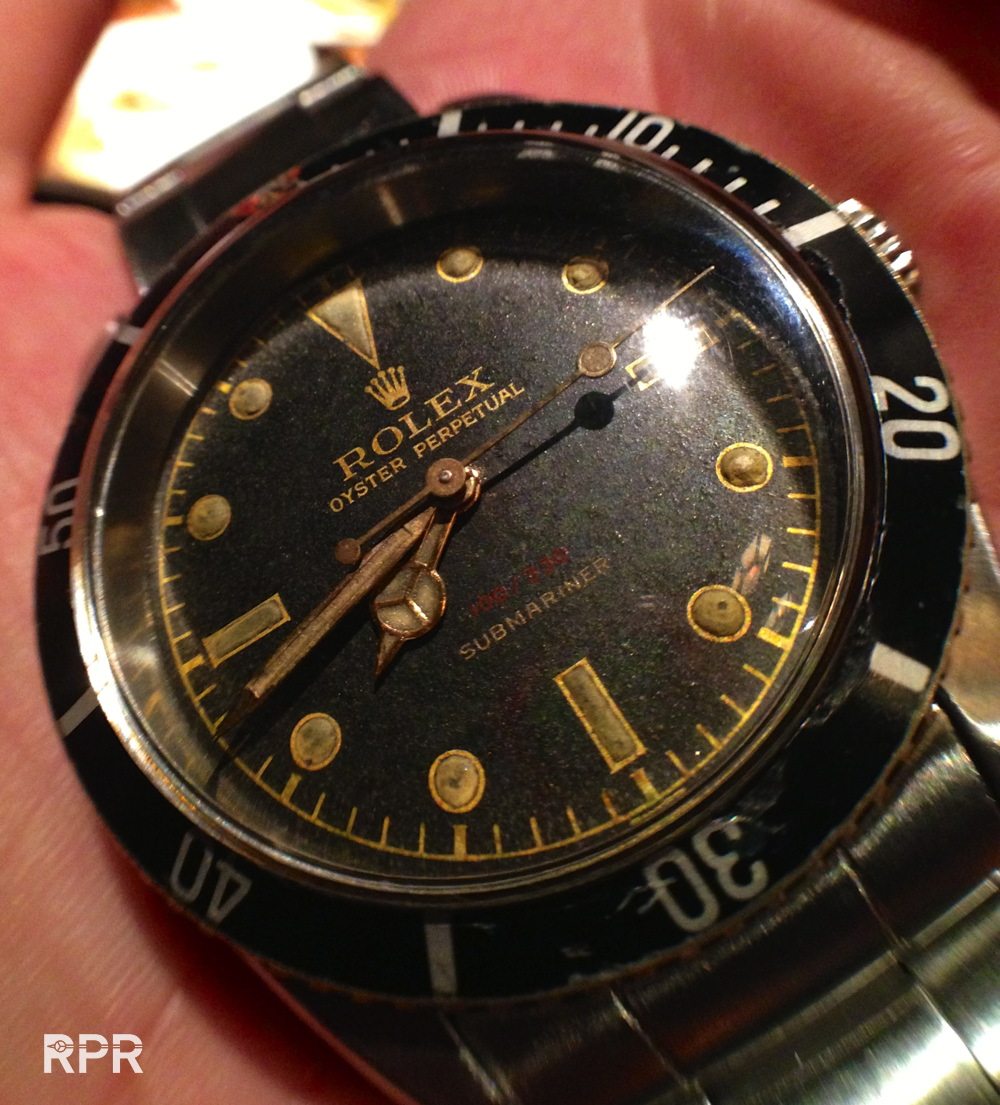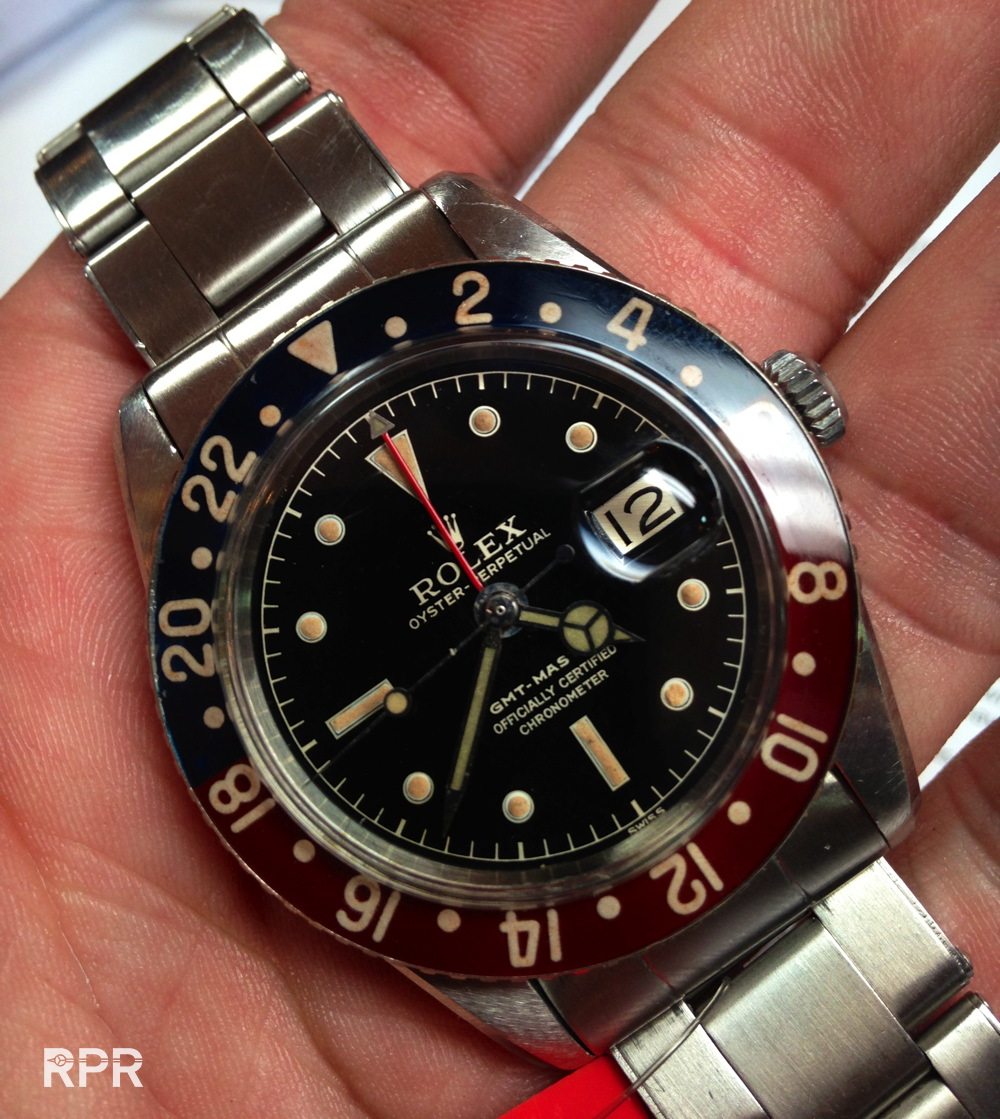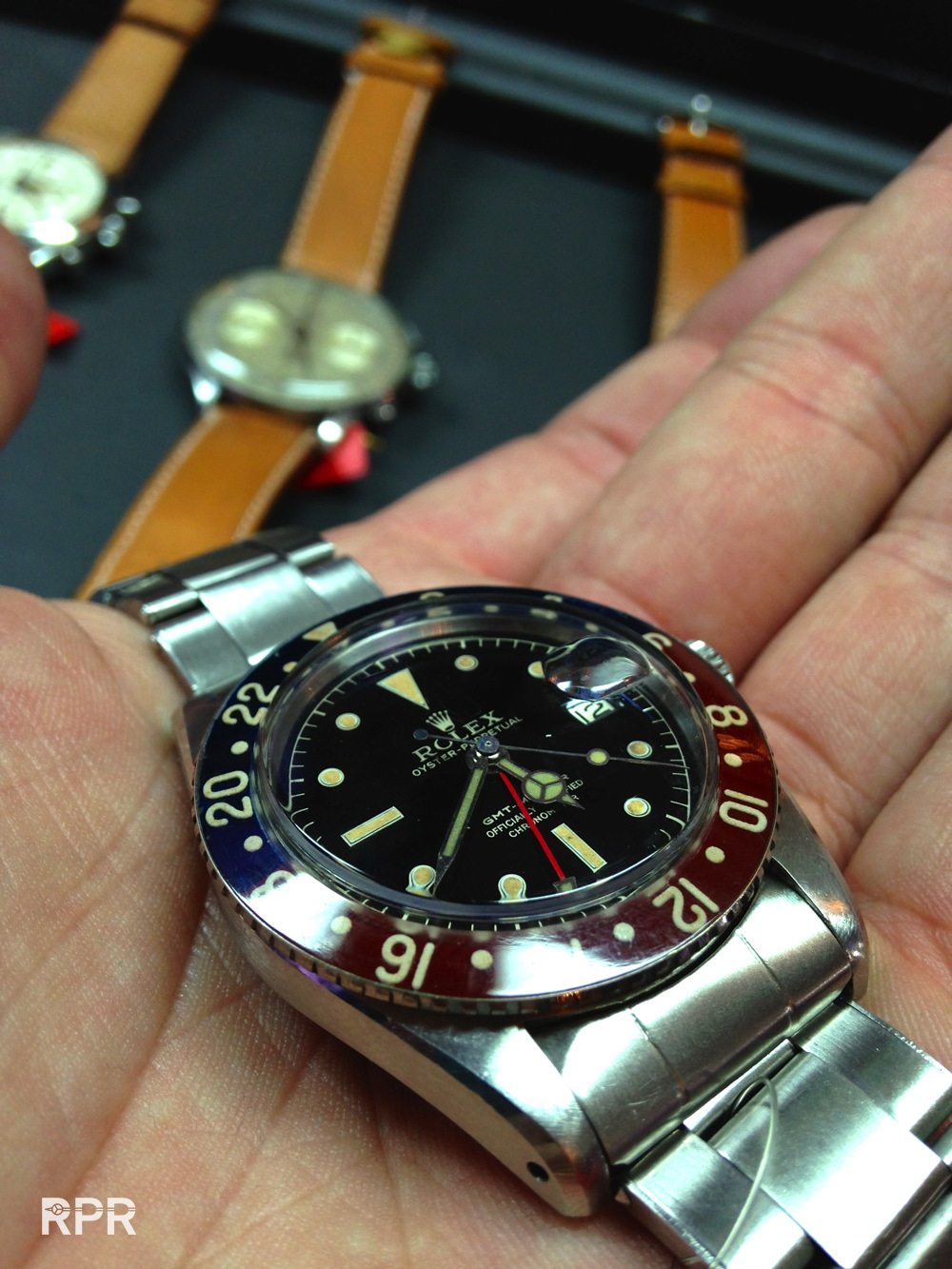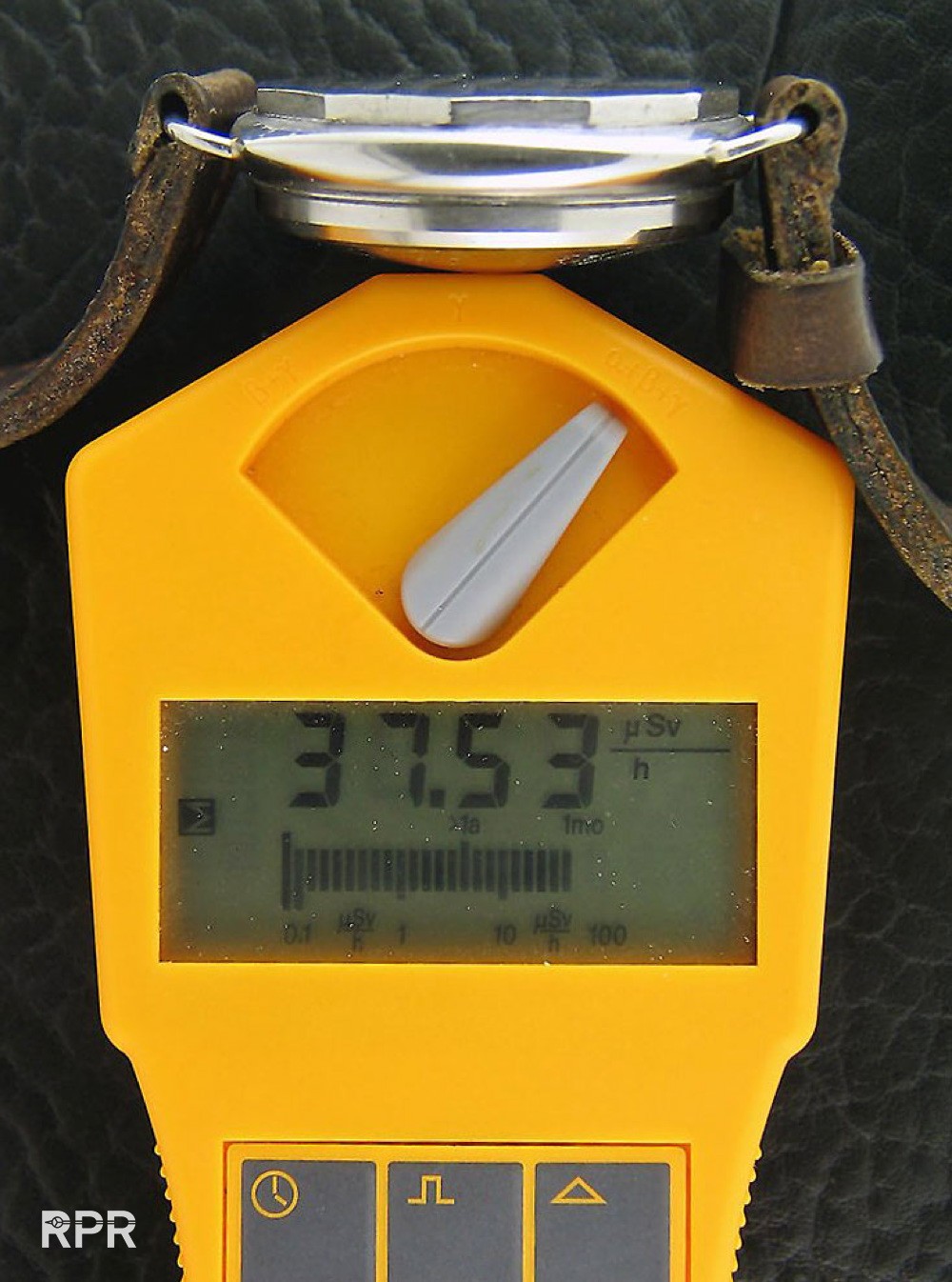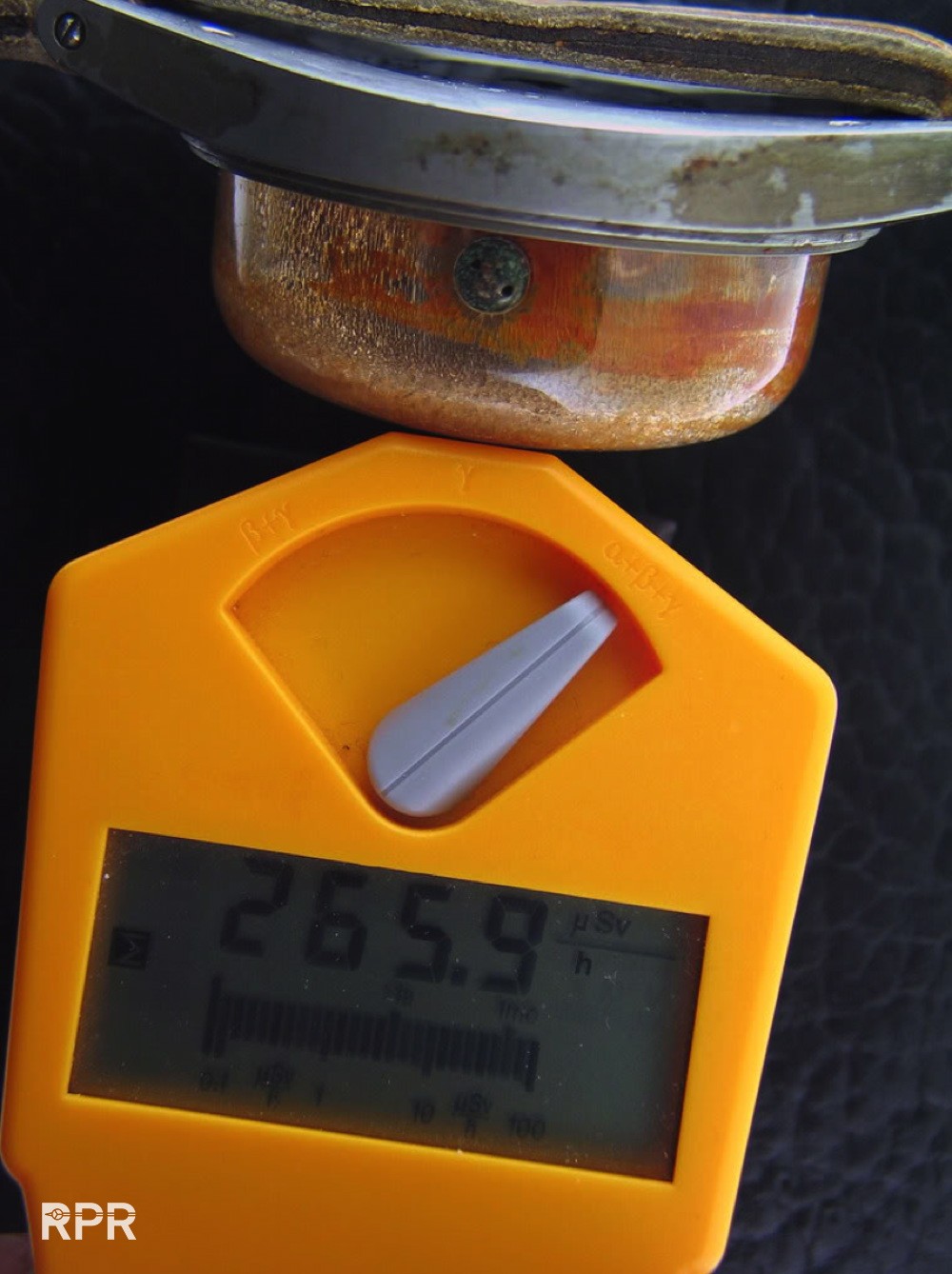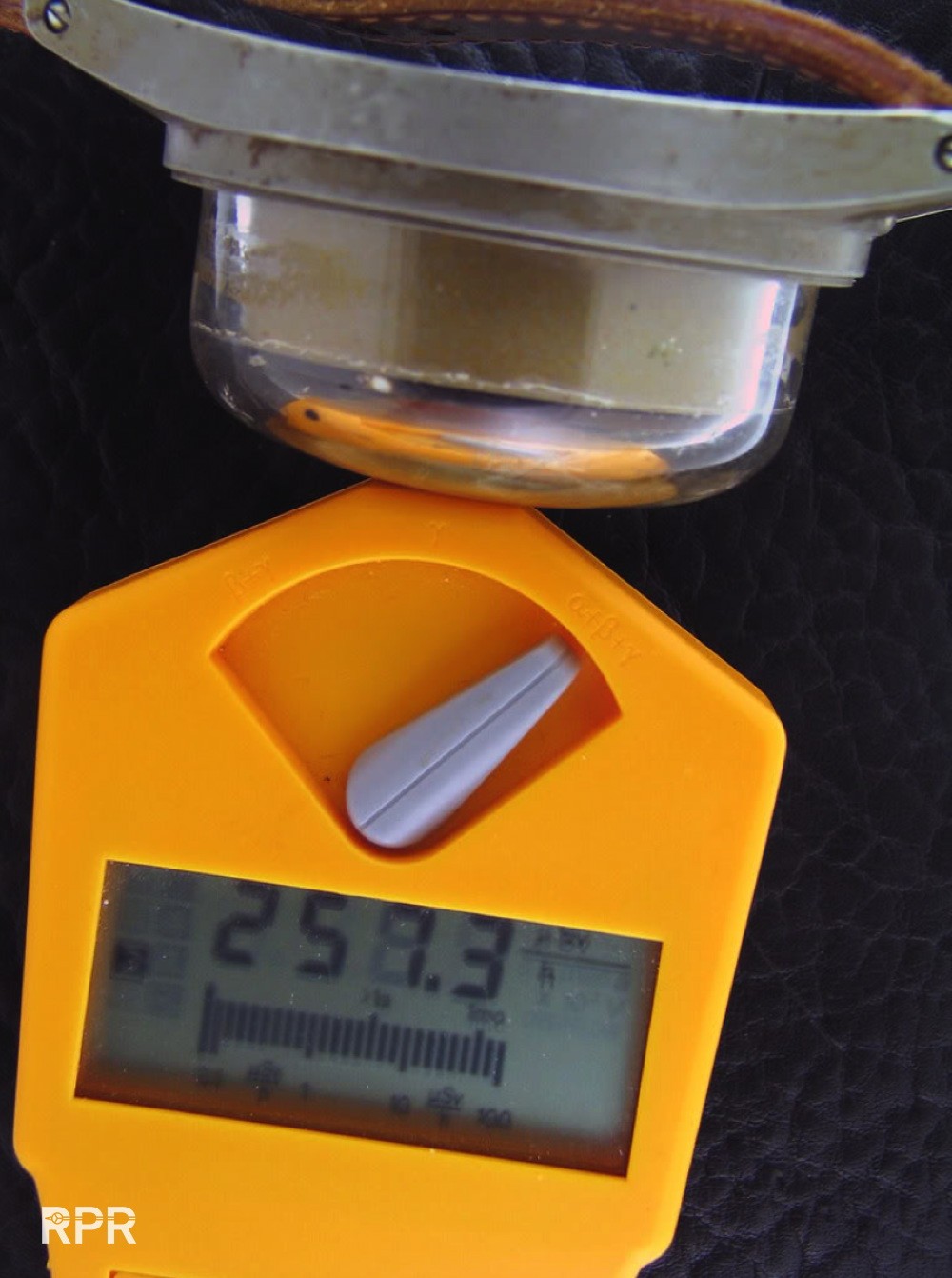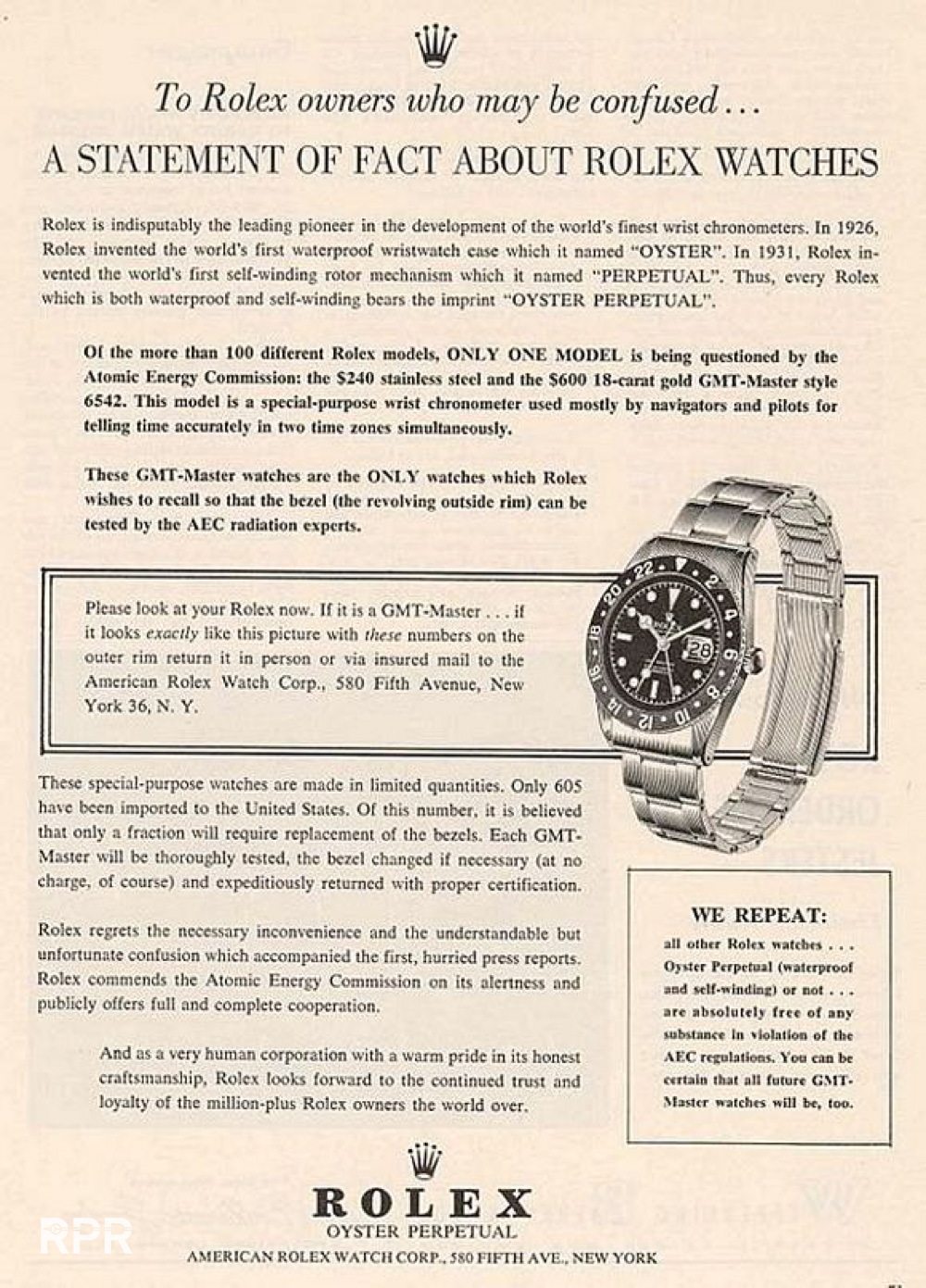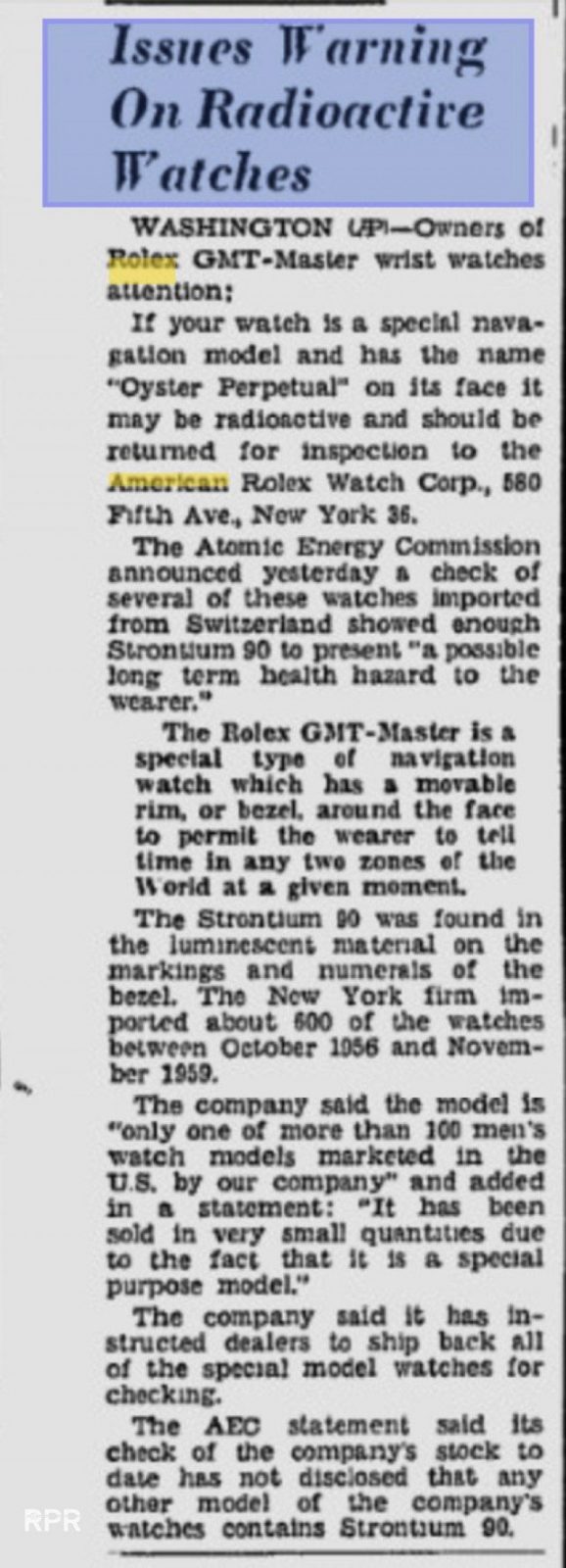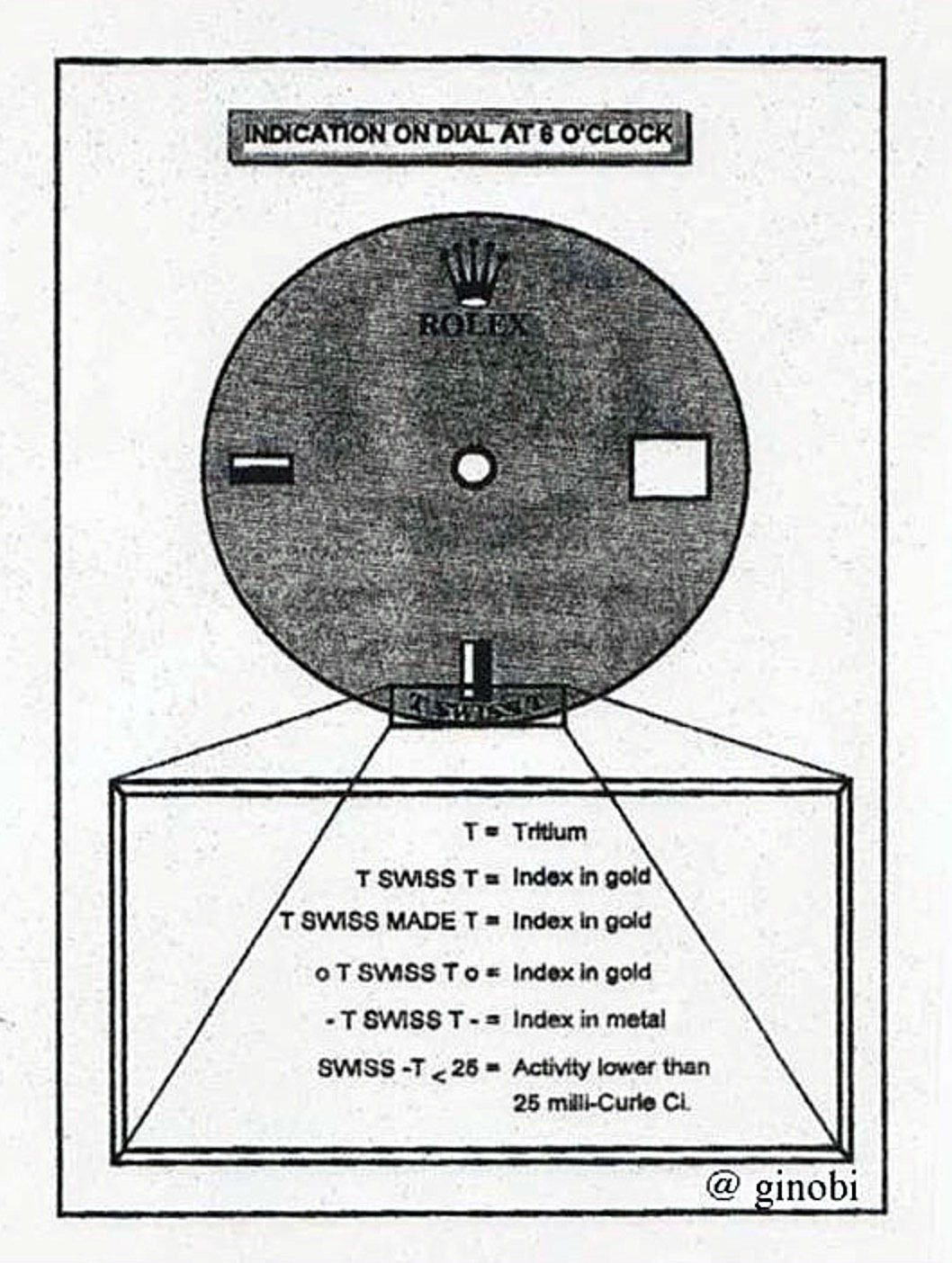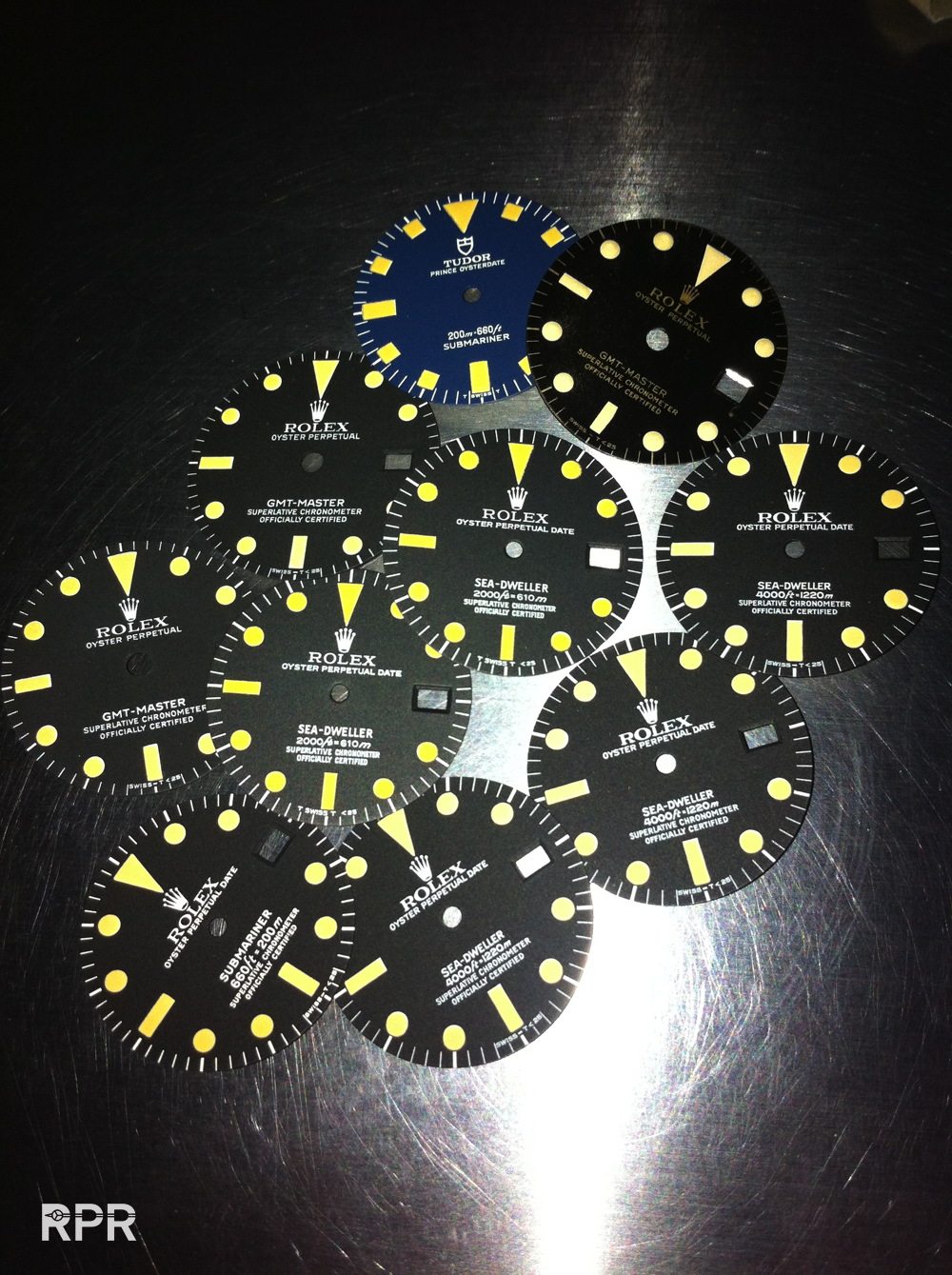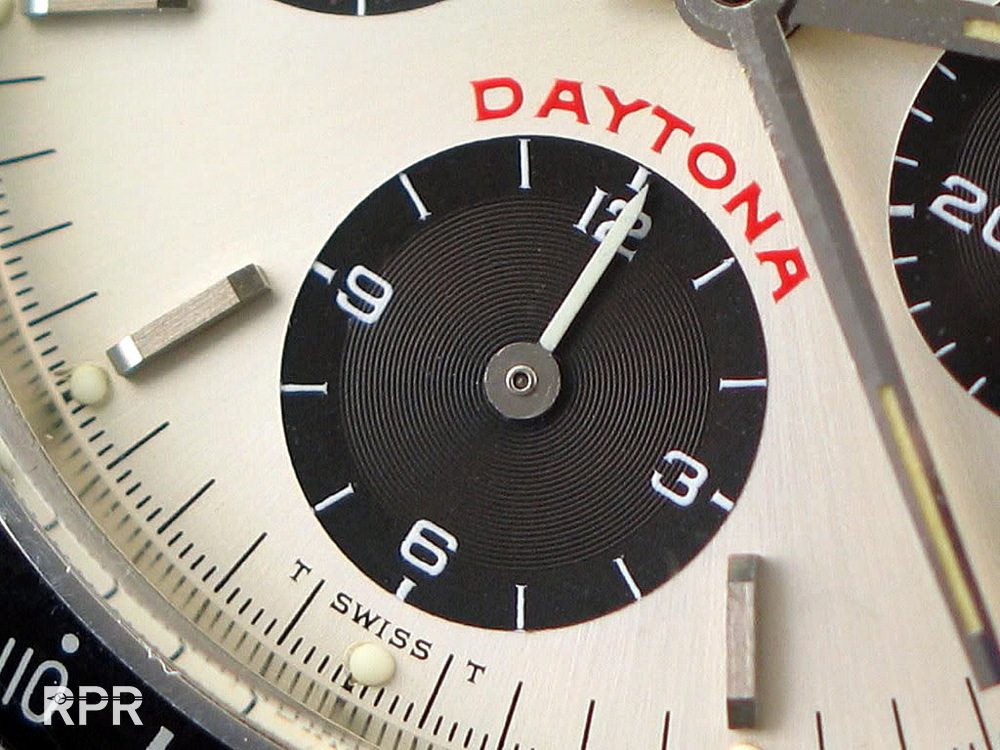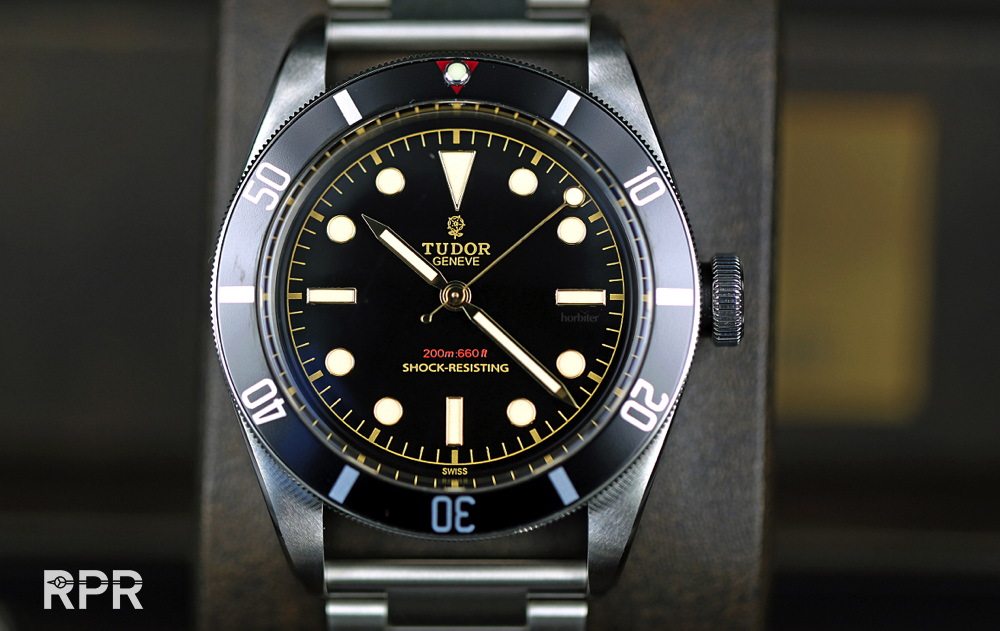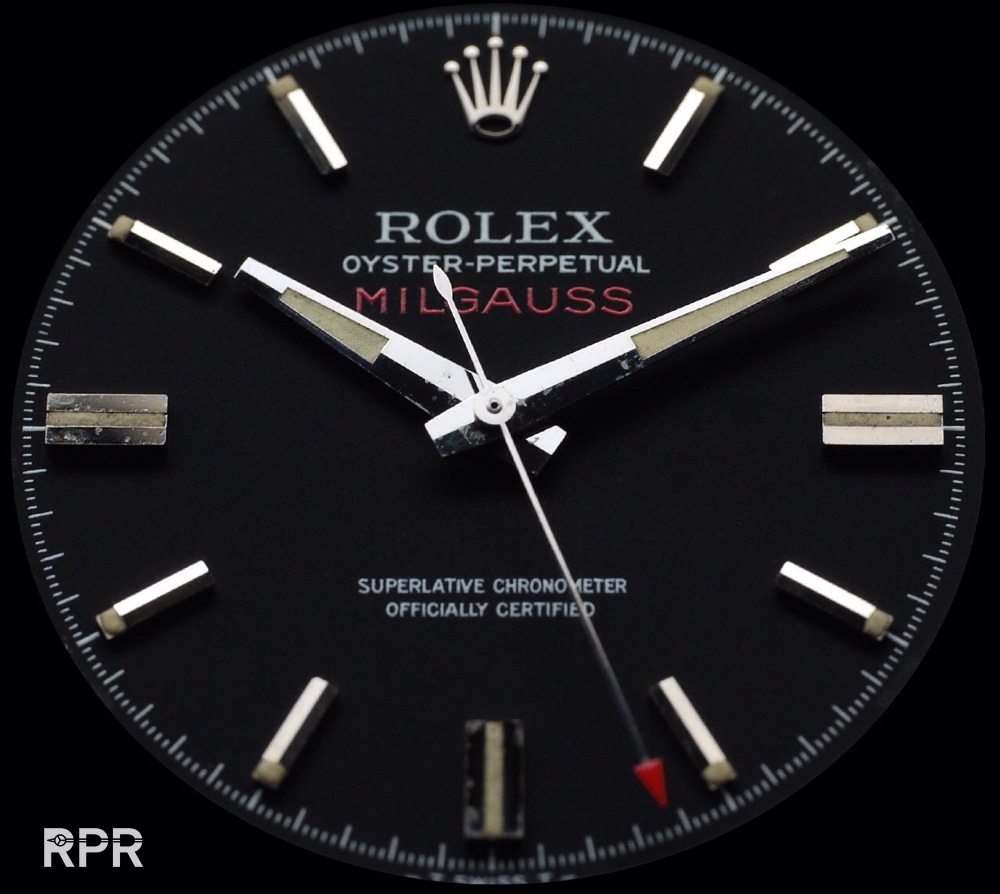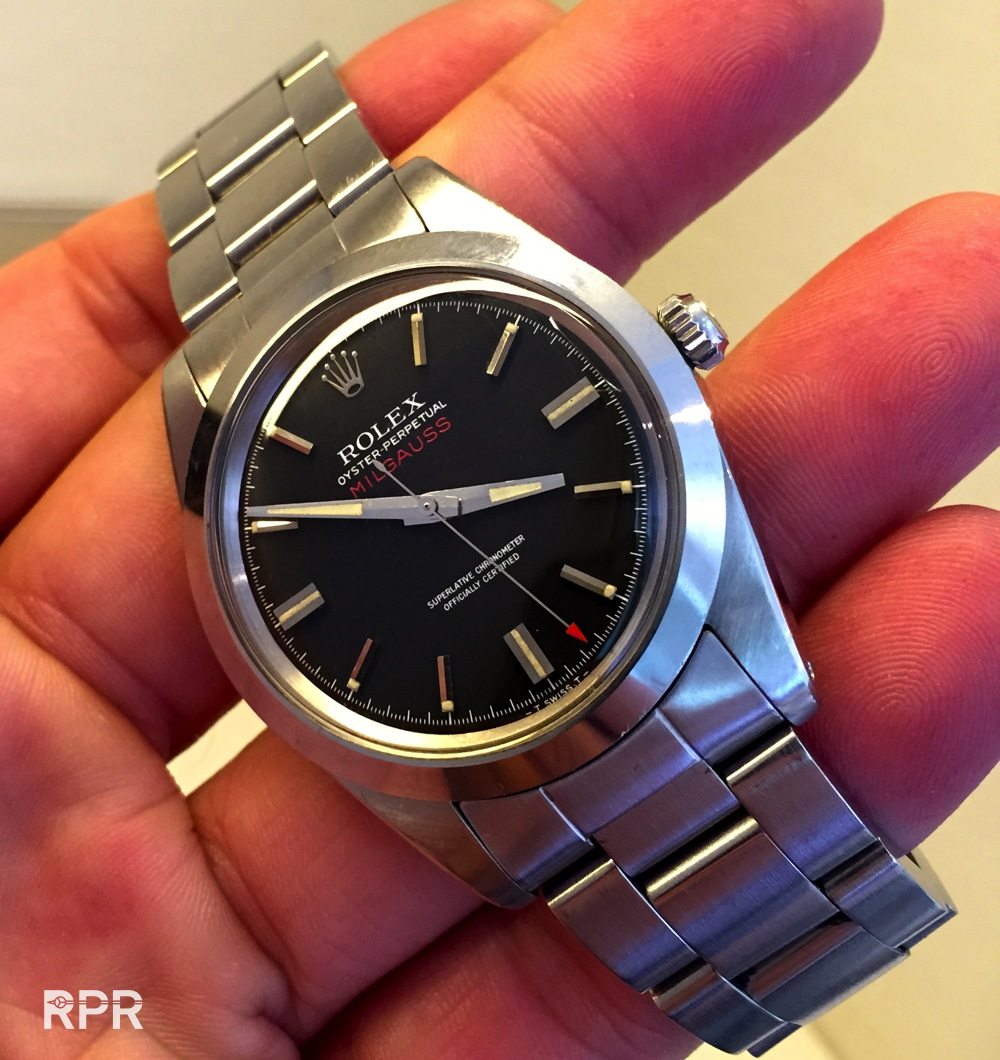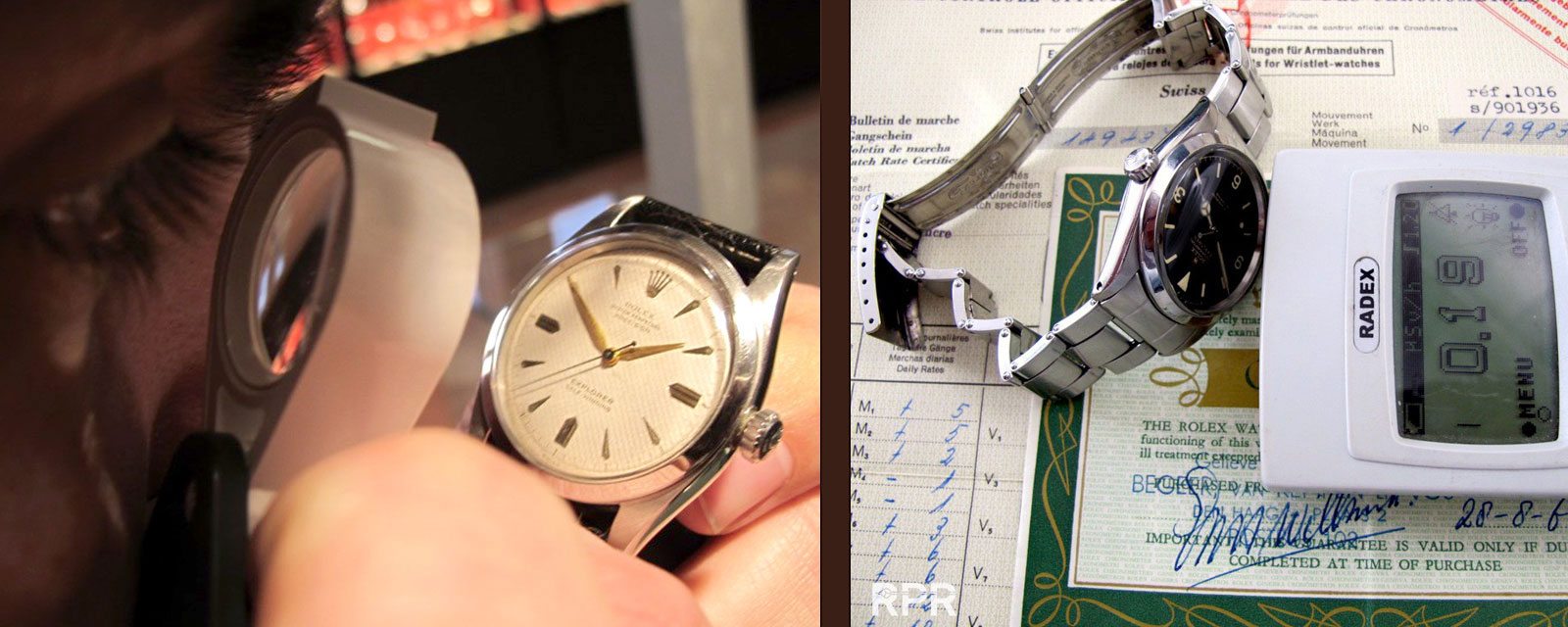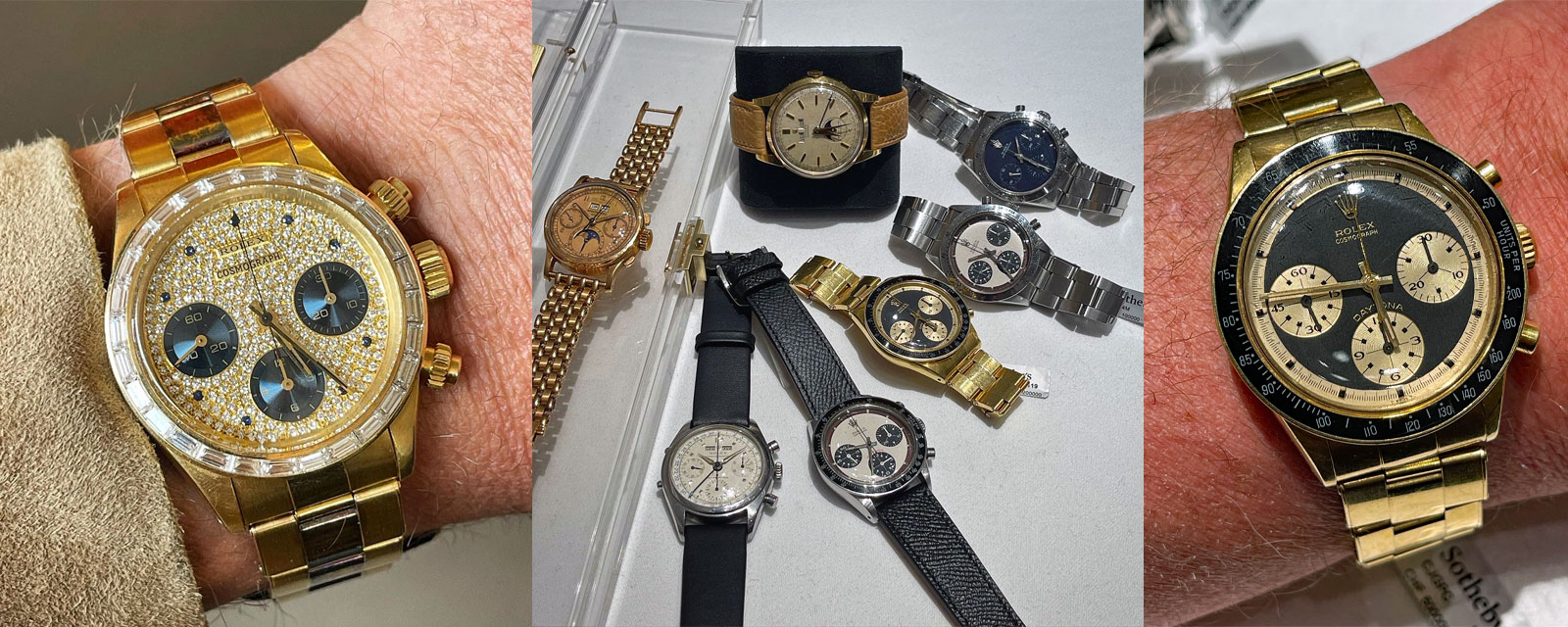 A lot has already been written about the impact of the luminous used in wristwatches. In specific the turn from using radium to tritium has been discussed in length on vintage Rolex Forums. Today I don’t want to debate the dangers of early radium nor the legal impact radiation had for the swiss watch companies. I merely want to make a general overview that’s useful for Rolex collectors to understand the differences of luminous, their used time period, the influence it had on the condition of the dial and what typical details one has to look for when analyzing a vintage Rolex.
A lot has already been written about the impact of the luminous used in wristwatches. In specific the turn from using radium to tritium has been discussed in length on vintage Rolex Forums. Today I don’t want to debate the dangers of early radium nor the legal impact radiation had for the swiss watch companies. I merely want to make a general overview that’s useful for Rolex collectors to understand the differences of luminous, their used time period, the influence it had on the condition of the dial and what typical details one has to look for when analyzing a vintage Rolex.
As you could have read earlier in my vintage Rolex Buyers Guide, the luminous in general I see as a “Moisture Meter” or more specific, a “Condition Meter” of which you can determine what has happened inside a Rolex during it’s life. As long as you don’t inhale early radium pre 1953, there’s no need to panic, you can wear your vintage Rolex as often as you want, even James Bond knows…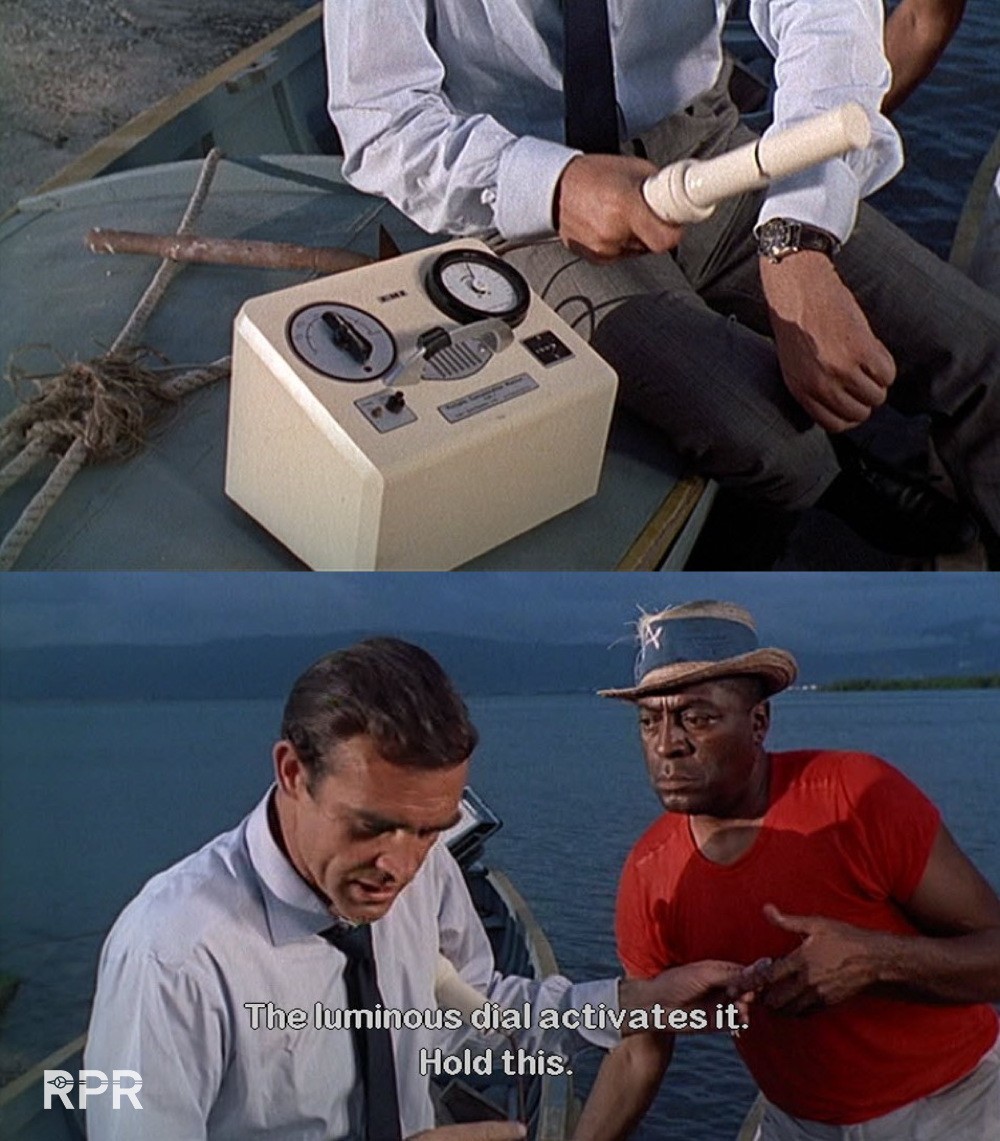 At first I like to start with the overview of the approximate date of luminous used by the Rolex Company:
At first I like to start with the overview of the approximate date of luminous used by the Rolex Company:
- Prior – 1953, The early age of Rolex luminous, used on their pocket watches, early oyster cases, bubble backs and radiomir Panerai’s.
- 1953 – 1956, When Rolex introduced the world their sports / utility / tool watch concept with radium Submariner, TOG, Explorer & GMT Master.
- 1957 – 1960, When Rolex lowered radiation and chanced dial printing from 1 to 2 colored print and enhanced the lacquer to a more glossy variant.
- 1960 – 1963, The pre ‘Transitional” period with “Exclamation” mark and due to the starting international regulation, again less radioactive luminous.
- 1963 – 1964, “Transitional” underline of which Rolex switched from Radium to Trtium, delivered dials are “swiss” signed but laminated with tritium.
- 1964 – 1967, The new generation tritium luminous got added on glossy dials, signing chanced from “Swiss” to “Swiss – T<25” & “T-Swiss-T”.
- 1967 – 1983, The matte dial with tritium luminous got introduced by Rolex. We see tritium signings variations like T Swiss T<25 or σ T-Swiss-T σ.
- 1983 – 1997, The last era of the tritium dials when the glossy dial surface came back, now the luminous was added in a added white gold surround.
- 1998- 2000, LumiNova was invented in 1993 and patented in 1995; Nemoto & Co. Ltd. was contracted in 1998 to provide LumiNova to Switzerland.
- 2000 – 2008, Super Luminova, a improved version of Luminova, a material that has the same properties as tritium but is not radioactive.
- 2008 – now, Chroma Light, the new blue-ish colored Super Luminova thats been in use since Rolex patented it.
The early aged radium dials from the 20-ies and 30-ies where merely fitted on a emaille surface, using strong first generation Radium that by then not known that it could be dangerous. In contraire, radium drinks where sold to cure health issues but soon this chanced after the tragic story about the Radium Girls.
Monobloc Ref 3525 from mid 1930’ies…
But for most Rolex collectors under us, the period that started at collecting Rolex is from 1953, the most interesting time phrases for aficionado’s. The Turn O Graph Ref. 6202, Submariner Ref. 6204 & 6205 and later the Big Crown Ref. 6200 are the beginning of the since then ever lasting legendary tool – sports watch concept.. 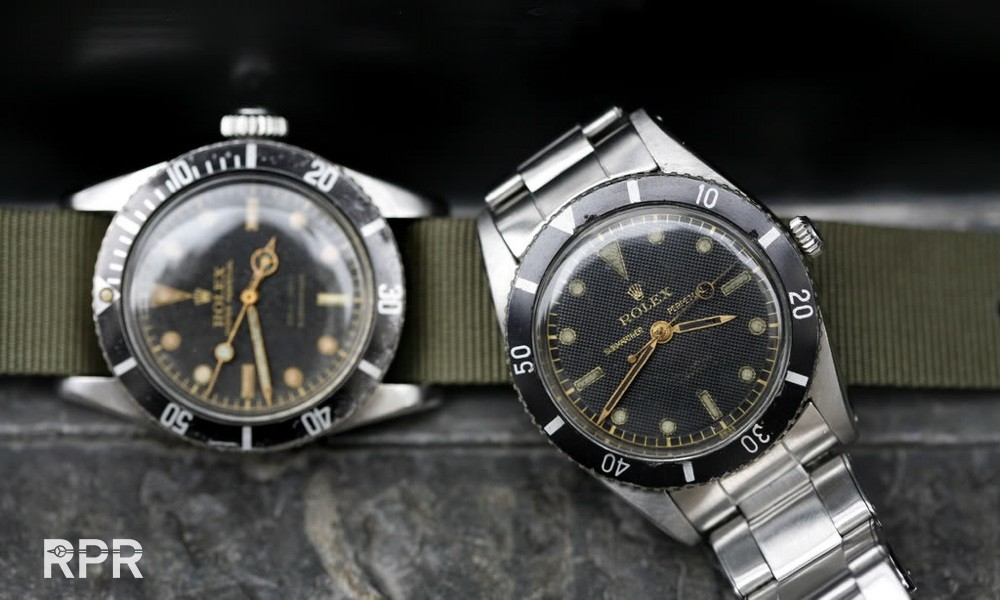 What we see in above and in below pictures are first generation Rolex Sports models. In many cases the radium luminous has turned greenish when moisture – condense came into the case as you can see above. In below Submariner ref 6200 you can clearly see that the radium dust is covered over the dial, mostly around the radium plots. One of the characteristics of these early sport dials is the fact the they have a 1 color print and a lacquer finish thats not as shinny as we see in later examples. The radium dust, one never must inhale, leave small stains on the surface of the dial. In below picture you can also clearly see the transparant paste in the hands that was added before the radium luminous came on top.
What we see in above and in below pictures are first generation Rolex Sports models. In many cases the radium luminous has turned greenish when moisture – condense came into the case as you can see above. In below Submariner ref 6200 you can clearly see that the radium dust is covered over the dial, mostly around the radium plots. One of the characteristics of these early sport dials is the fact the they have a 1 color print and a lacquer finish thats not as shinny as we see in later examples. The radium dust, one never must inhale, leave small stains on the surface of the dial. In below picture you can also clearly see the transparant paste in the hands that was added before the radium luminous came on top. 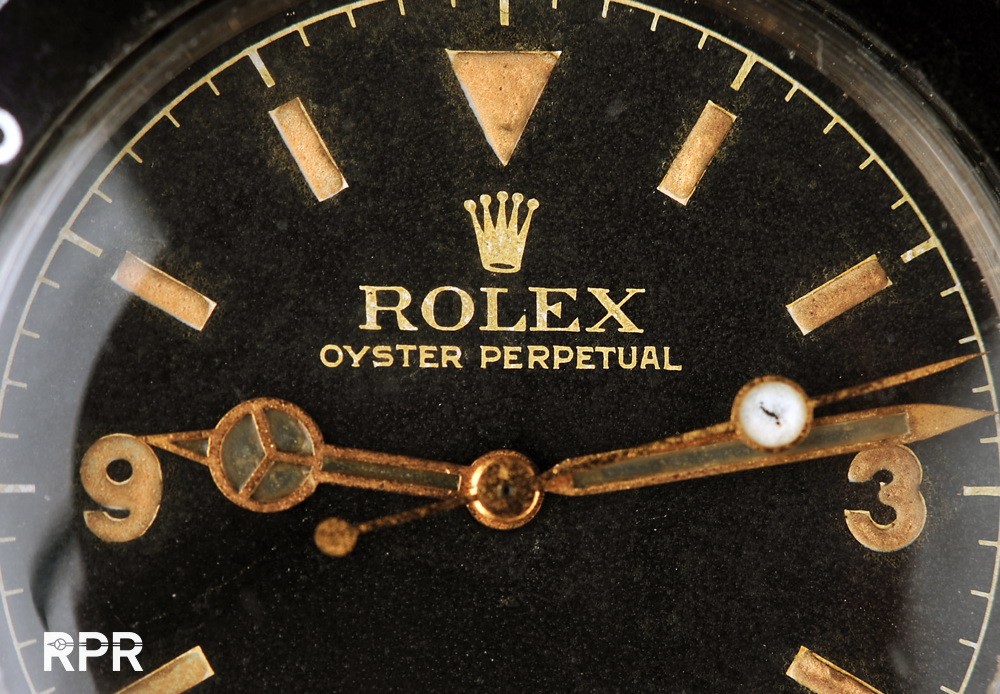 2 x Submariner Big Crown but both very different in detail. First is a 1954 Ref 6200 with later added “Submariner” at 6 O’clock, secondly we see a 1958 Ref 6538 with 4 line dial, besides the depth rate and Submariner, this version has a OCC ( Official Certified Chronometer ) movement.
2 x Submariner Big Crown but both very different in detail. First is a 1954 Ref 6200 with later added “Submariner” at 6 O’clock, secondly we see a 1958 Ref 6538 with 4 line dial, besides the depth rate and Submariner, this version has a OCC ( Official Certified Chronometer ) movement. 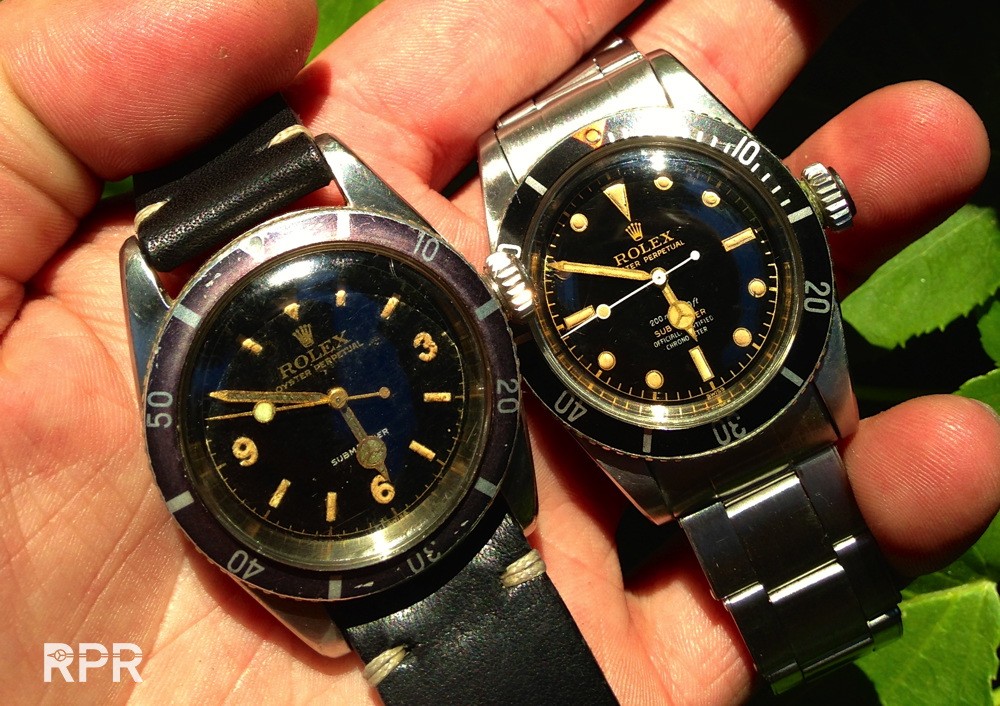 Up close a early Ref 6204 with black “Honeycomb” dial, split logo ( Submariner & Perpetual) pencil hands and slightly visible, the OCC sign at 6 o’clock. The radium dust has slightly eaten the dial surface. The missing luminous in the second hand has been spread around the dial. Moisture made the pencil hands inside turned dark as well as the plots on the dial greenish.
Up close a early Ref 6204 with black “Honeycomb” dial, split logo ( Submariner & Perpetual) pencil hands and slightly visible, the OCC sign at 6 o’clock. The radium dust has slightly eaten the dial surface. The missing luminous in the second hand has been spread around the dial. Moisture made the pencil hands inside turned dark as well as the plots on the dial greenish. 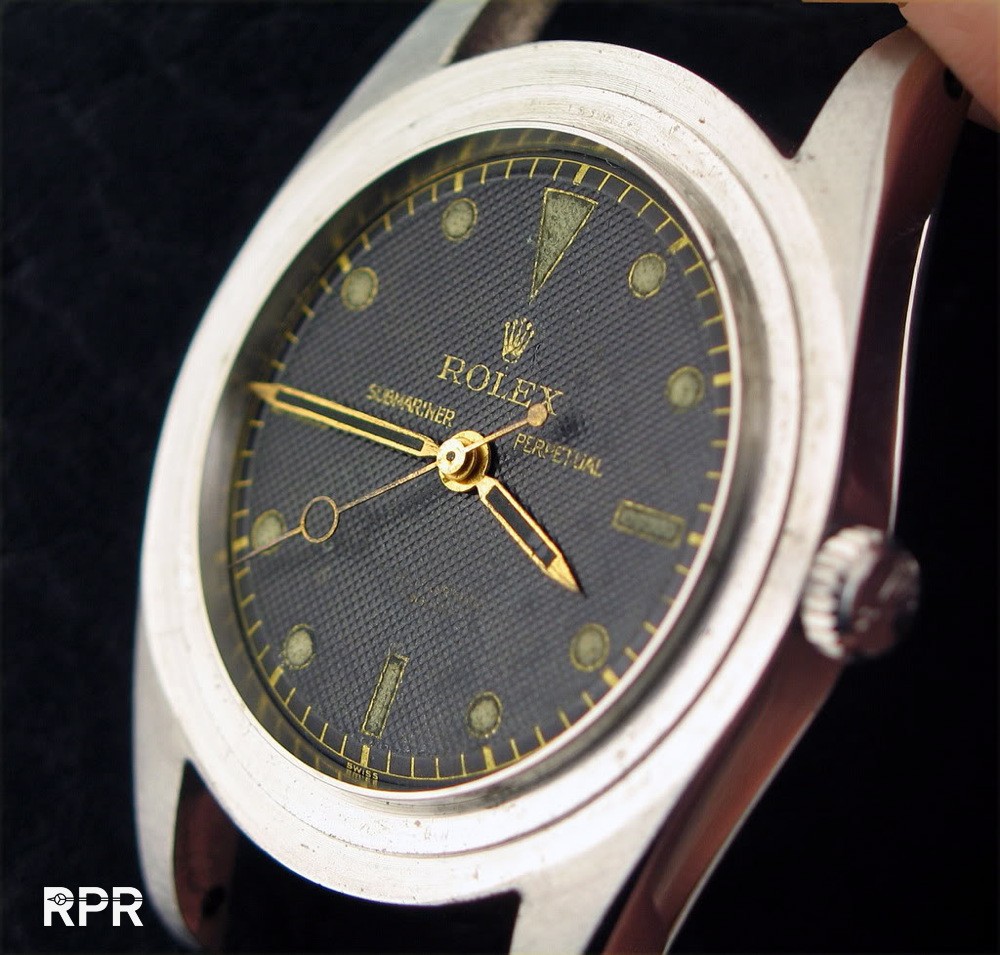 Next we see a first generation Big Crown Ref. 6538. You notice that the depth rate ( 200M = 660Ft ) and the Submariner print are both in 1 color! Another typical detail we see is the 6 o’clock marker being more bright then the rest of the radium plots. Most probably this marker is a special mix of radium for easier underwater readability.
Next we see a first generation Big Crown Ref. 6538. You notice that the depth rate ( 200M = 660Ft ) and the Submariner print are both in 1 color! Another typical detail we see is the 6 o’clock marker being more bright then the rest of the radium plots. Most probably this marker is a special mix of radium for easier underwater readability. 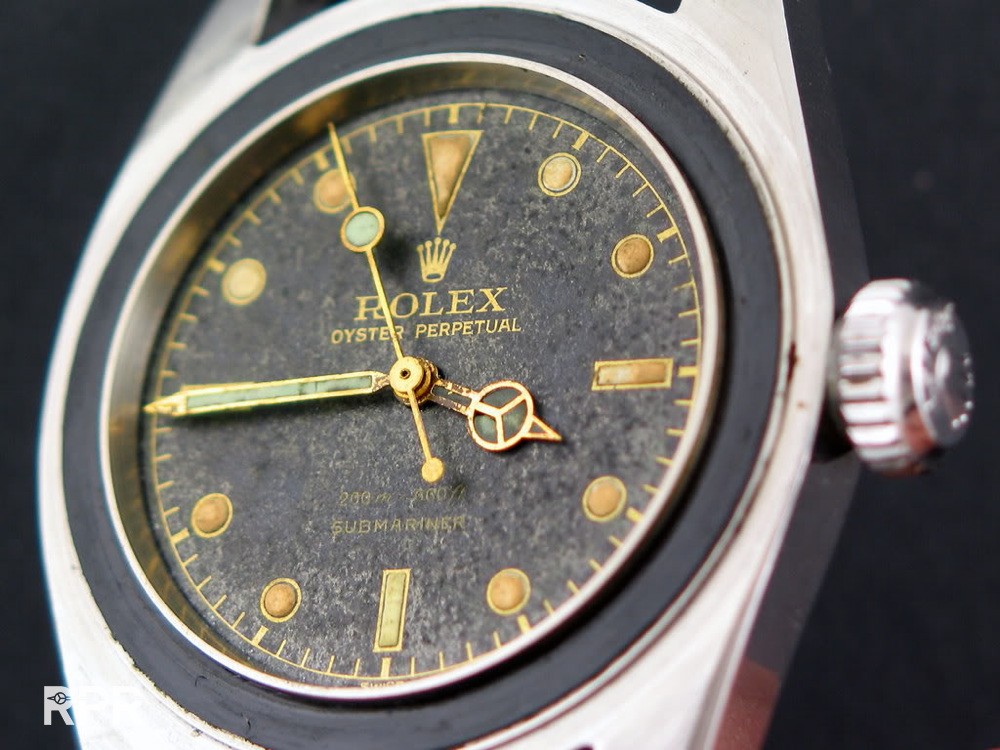 Detail comparison: Left and middle version are both early 6538’s with 1 color print, there where the right one is having a 2 color print ( for depth rate & OCC)
Detail comparison: Left and middle version are both early 6538’s with 1 color print, there where the right one is having a 2 color print ( for depth rate & OCC) 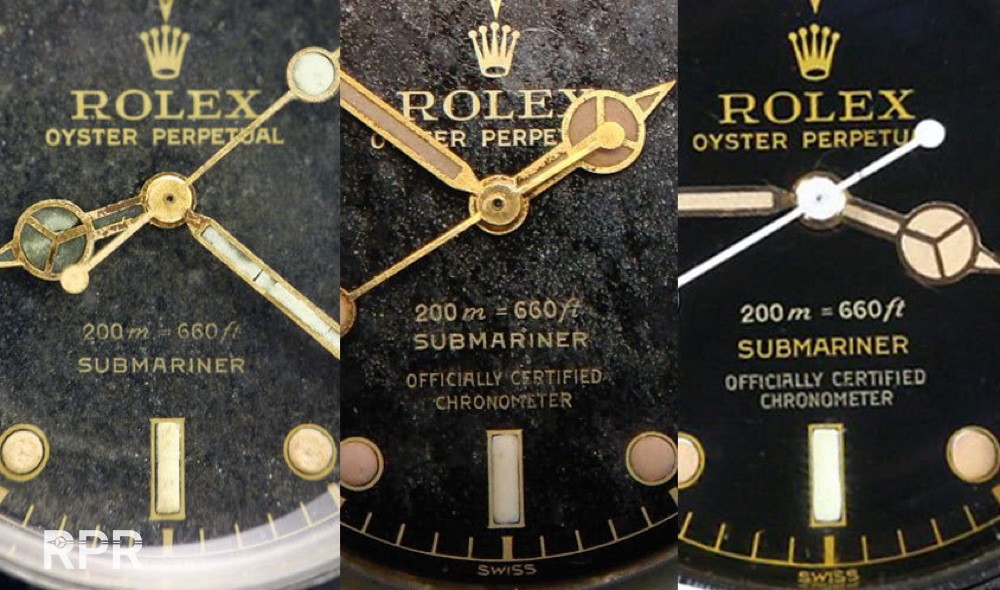 Next to each other, second and first generation Rolex Big Crown’s. Clearly visible is the different finish that covers the dials, there where the later left one is all shinny and glossy is the right one of first generation. A lot of research I’ve done on these Submariner Big Crown’s and my standard procedure was to measure the dial with a geiger meter. From the results I can inform you that the radiation between first & second generation 6538’s is significant, depending on the condition of the luminous of as well the dial and hands, the later glossy versions where at least 5 times less radio active, hence the better condition you find them now.
Next to each other, second and first generation Rolex Big Crown’s. Clearly visible is the different finish that covers the dials, there where the later left one is all shinny and glossy is the right one of first generation. A lot of research I’ve done on these Submariner Big Crown’s and my standard procedure was to measure the dial with a geiger meter. From the results I can inform you that the radiation between first & second generation 6538’s is significant, depending on the condition of the luminous of as well the dial and hands, the later glossy versions where at least 5 times less radio active, hence the better condition you find them now.  Close up of a fully in tact radium 6 o’clock Explorer ref 6350 marker from 1953…
Close up of a fully in tact radium 6 o’clock Explorer ref 6350 marker from 1953… 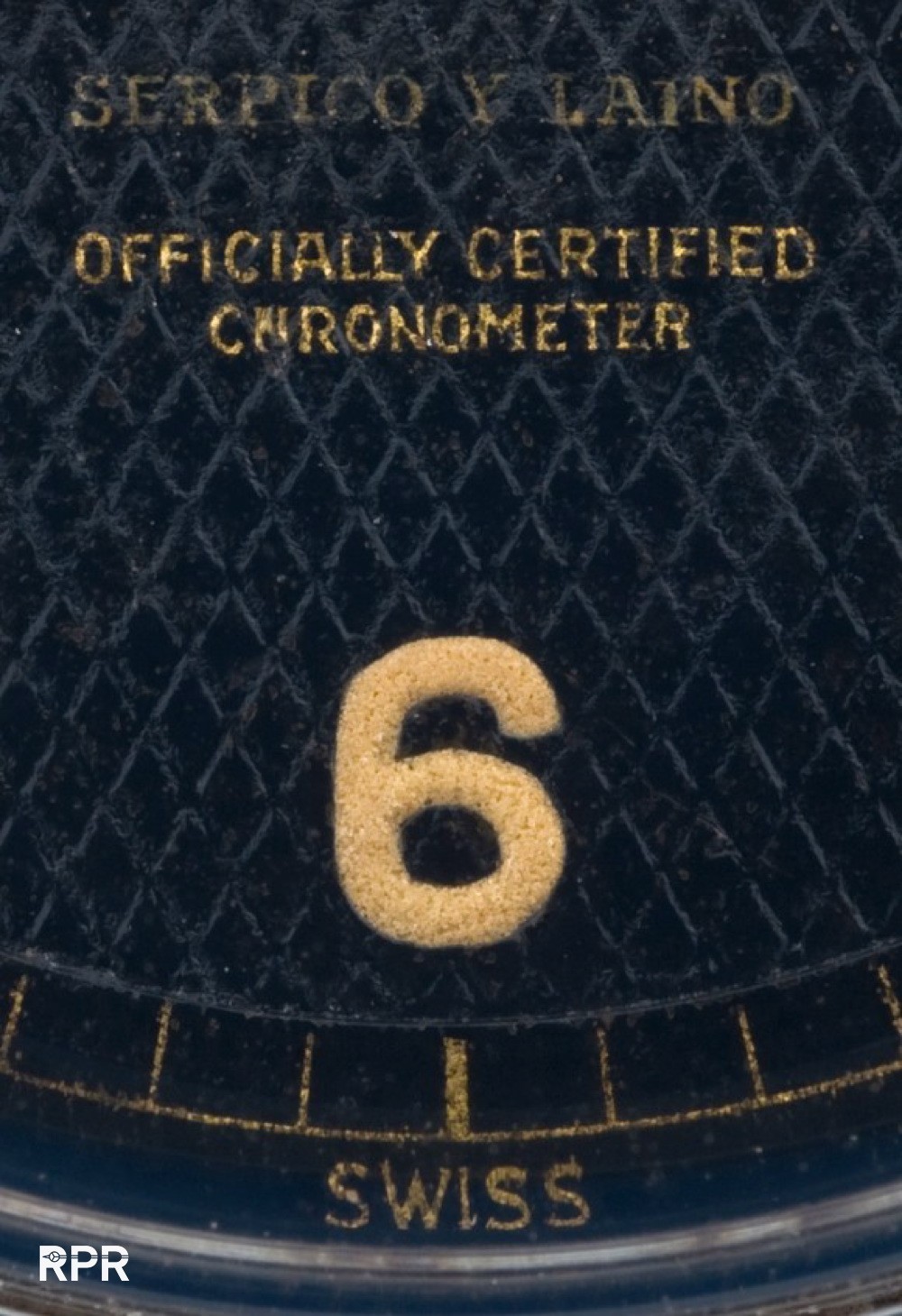 Comparison: You will notice that the graphic chanced over the years with the later version we see on the right. The Submariner text has become more modern.
Comparison: You will notice that the graphic chanced over the years with the later version we see on the right. The Submariner text has become more modern.  A typical detail you hardly see at any pictures on the internet is the unique patina of the glossy dial surface. The to each glossy Rolex dial unique tiny cracks are only visible when you play with the light. Furthermore we see that the top part of the Rolex print is punched in the dial and as well the ‘submariner print. The depth rating and OCC are added later, on top of the finished lacquer, making it possible for Rolex to print 1 dial and later modify it for their needs.
A typical detail you hardly see at any pictures on the internet is the unique patina of the glossy dial surface. The to each glossy Rolex dial unique tiny cracks are only visible when you play with the light. Furthermore we see that the top part of the Rolex print is punched in the dial and as well the ‘submariner print. The depth rating and OCC are added later, on top of the finished lacquer, making it possible for Rolex to print 1 dial and later modify it for their needs. 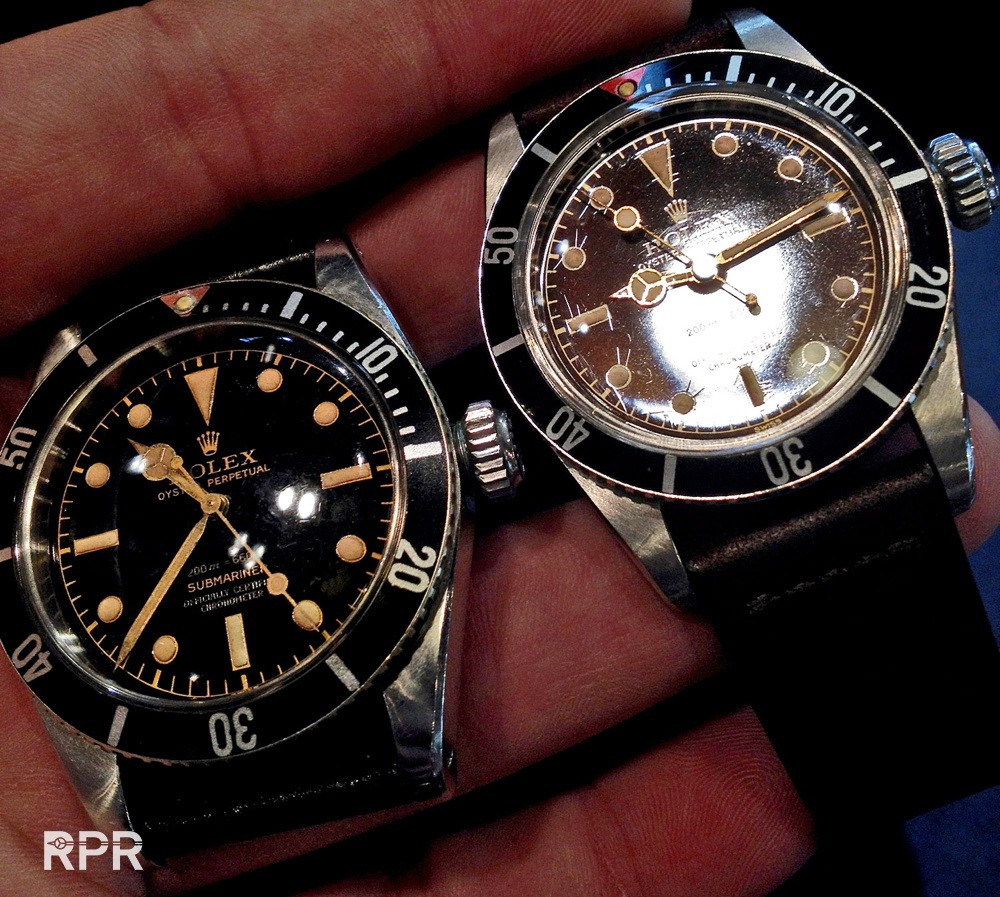 Not many Rolex collectors are aware about the fact that the Big Crown & Small Crown versions are having the same graphics. Below you see that at this pre stamped the depth rating for small crown was used and added over the already finished lac. First Rolex service dial? (follow the link to more vintage Rolex study).
Not many Rolex collectors are aware about the fact that the Big Crown & Small Crown versions are having the same graphics. Below you see that at this pre stamped the depth rating for small crown was used and added over the already finished lac. First Rolex service dial? (follow the link to more vintage Rolex study).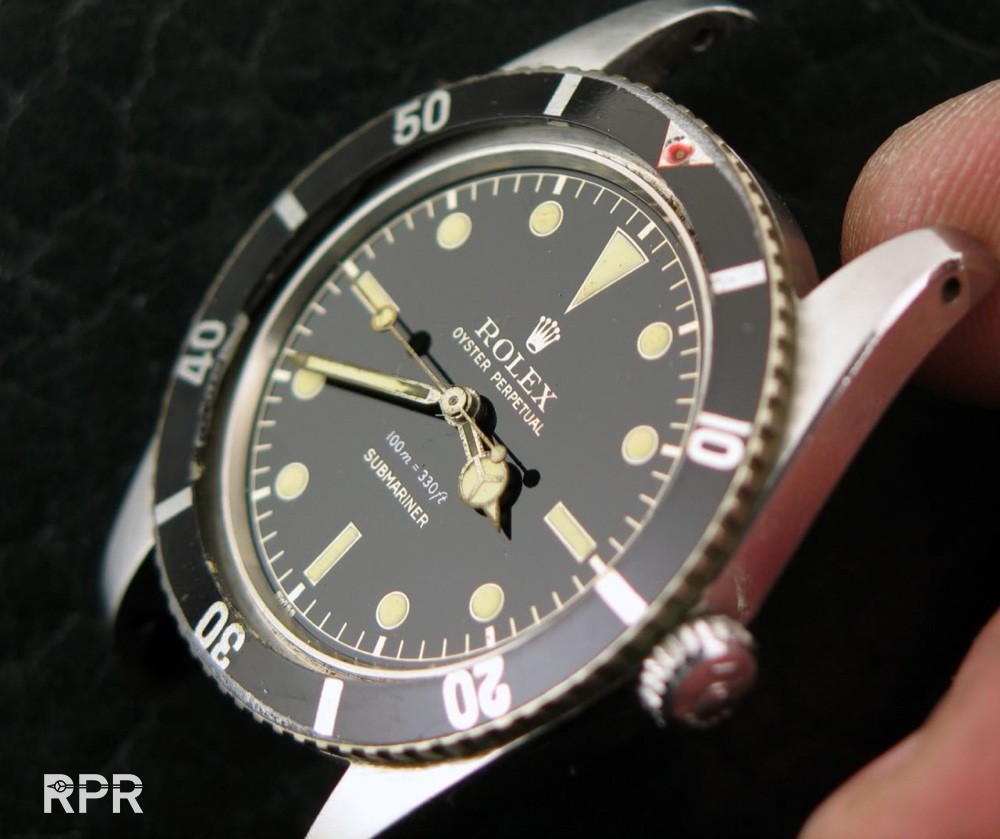 Another interesting detail is the white surface underneath the radium plots that was added to the dial so the luminous could stick on easily. Rolex luminous is always between the gold surroundings and hardly ever will go over it, something you see with later resumed dials a lot, the luminous material is often bigger then the white plot.
Another interesting detail is the white surface underneath the radium plots that was added to the dial so the luminous could stick on easily. Rolex luminous is always between the gold surroundings and hardly ever will go over it, something you see with later resumed dials a lot, the luminous material is often bigger then the white plot. 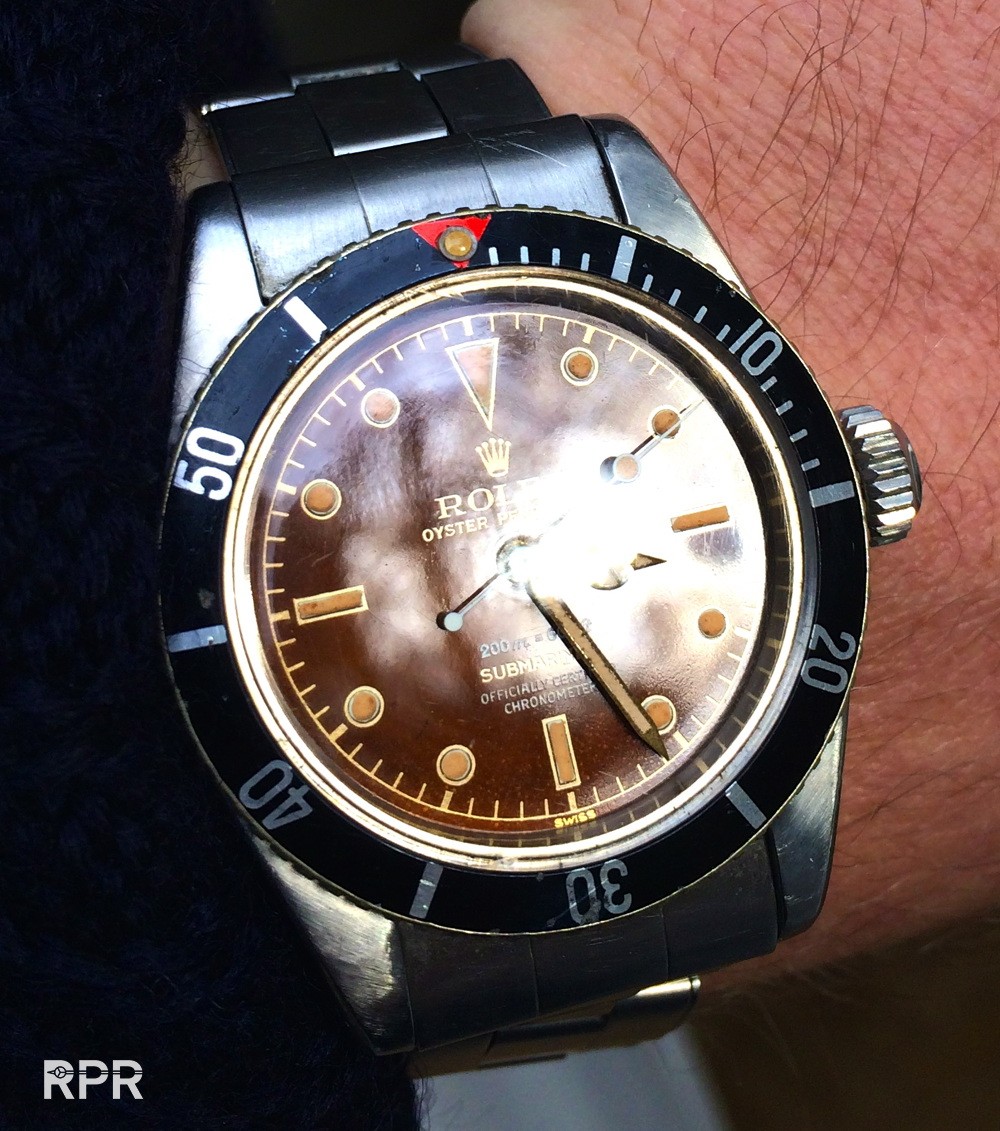
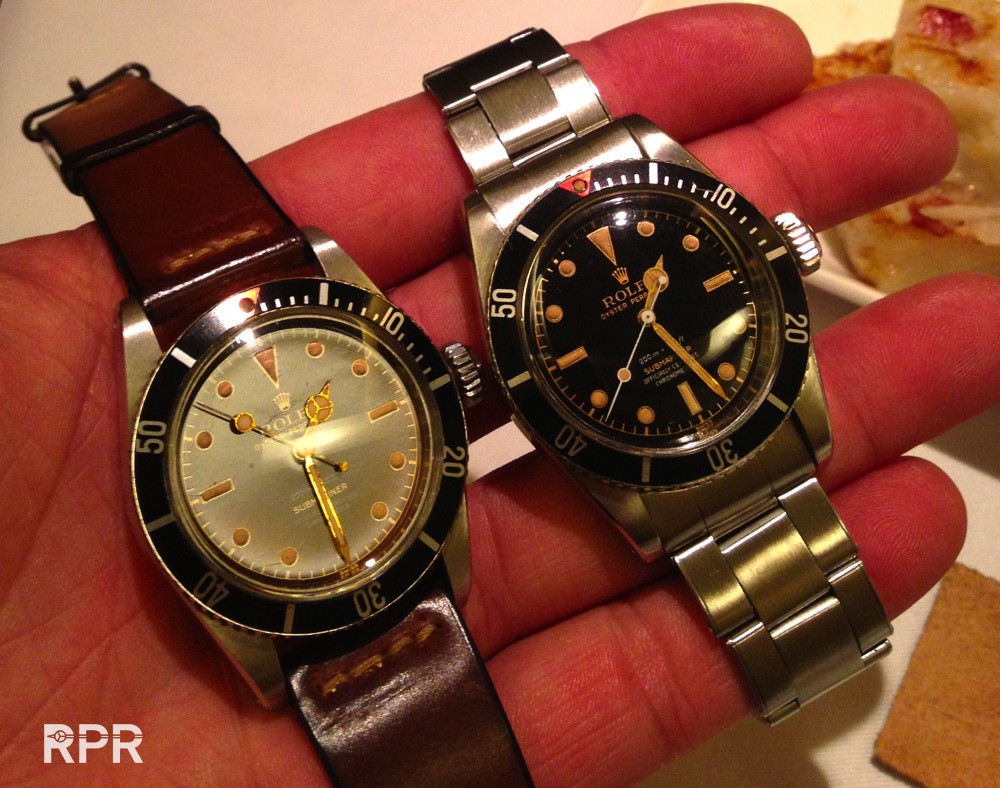
Find below the Zeller Stylograph from the luminous company RC Tritec used for applying the luminous on the dial and hands.
Here’s a very interesting article ( sorry only in German) about the history of luminous, following the link below…
—> revue-watch-around-herbst-2015-winter-2016-leuchten-in-der-nacht-apz
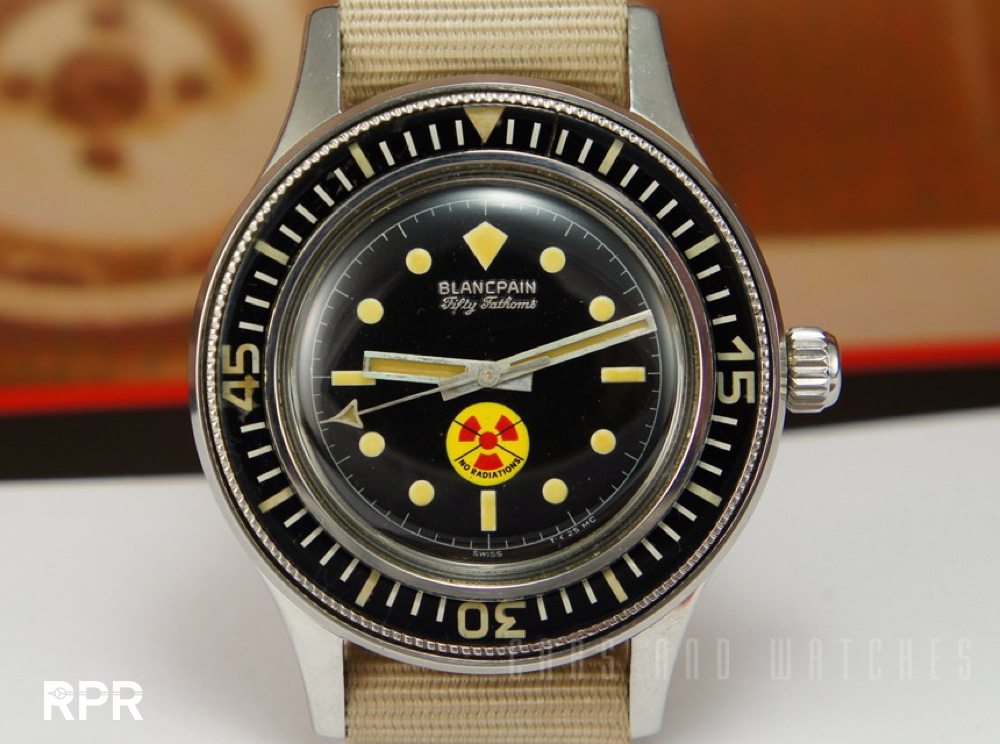
So if moisture enters the case, it will damage the surface and leave little black stains on the lume dots, as you can see below. Again, the luminous on the dial and hands, are the condition meter showing you what happened over the years with the watch. Moisture and condens will be sucked up by the luminous and make it chance color to dark and ugly, then it will destroy the top layer of the dial.
From the front hardly visible but once you turn the dial slightly you notice the infrastructure of cracks. My believe is that the dials have been stored for a long time at a dry place and that this has cracked the surface… 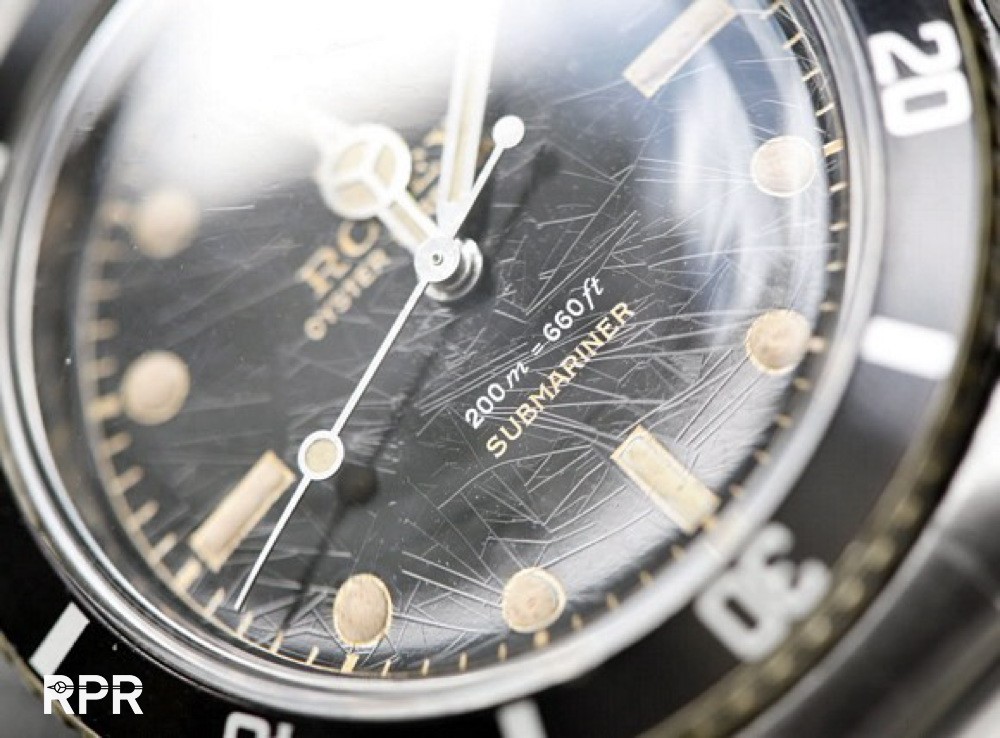 Yet another example of cracked surface. This particular SCOC small crown 5508 is almost all over damaged and the grooves have become very deep…
Yet another example of cracked surface. This particular SCOC small crown 5508 is almost all over damaged and the grooves have become very deep… 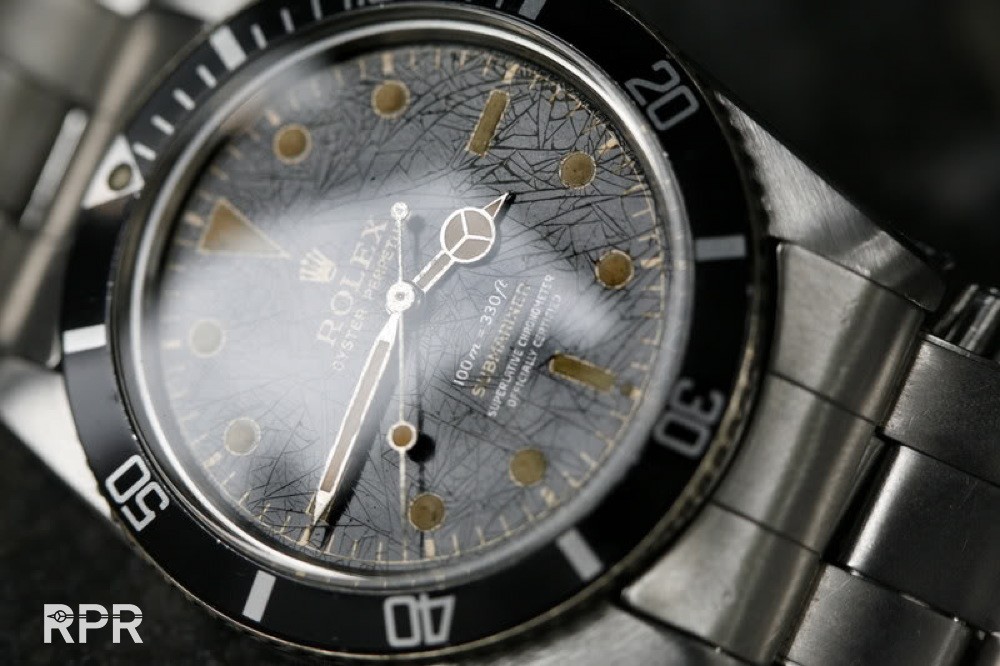 And another cracked one. In both 3 examples we see that the hands have also been chanced during a service by Rolex to later smaller ones, meaning that all 3 of them had a water problem back in the days and the original radium hands where chanced to later tritium ones, hence the different in color of the luminous.
And another cracked one. In both 3 examples we see that the hands have also been chanced during a service by Rolex to later smaller ones, meaning that all 3 of them had a water problem back in the days and the original radium hands where chanced to later tritium ones, hence the different in color of the luminous. 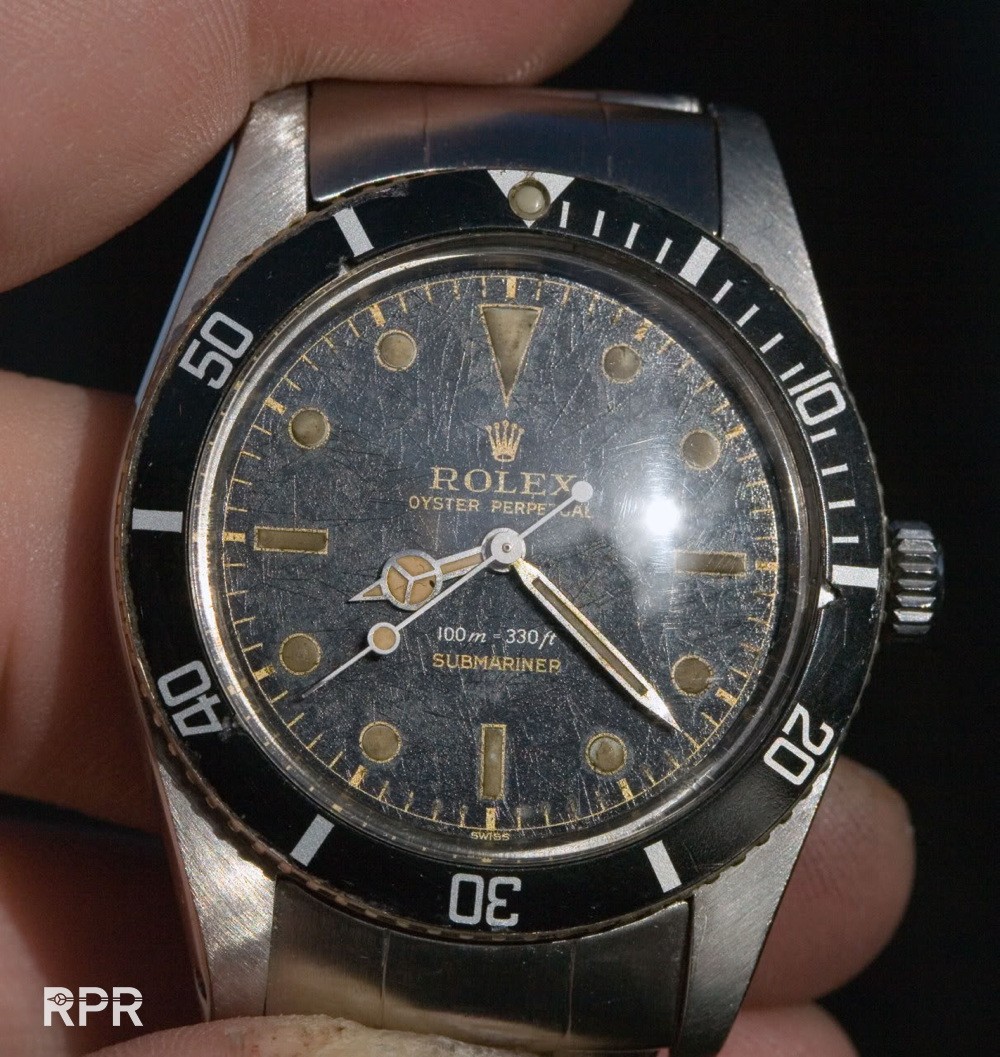
See below a broken finish that flakes…

While analyzing the below 2 photo’s now you notice that the hands do NOT match the rest of the color of the luminous, thus something has happened afterwards before sit went to auction. Are these the original hands and has the dial been swapped perhaps?
Below you can see pictures of the radium investigation I made on many different sport Rolex and other watches during the recent years. I specifically was always interested to see the rate of a untouched original owners Rolex as with them we knew nothing has been done to chance the look / originality. Below a early Panerai Radiomir ref 3646, below measurements from the back..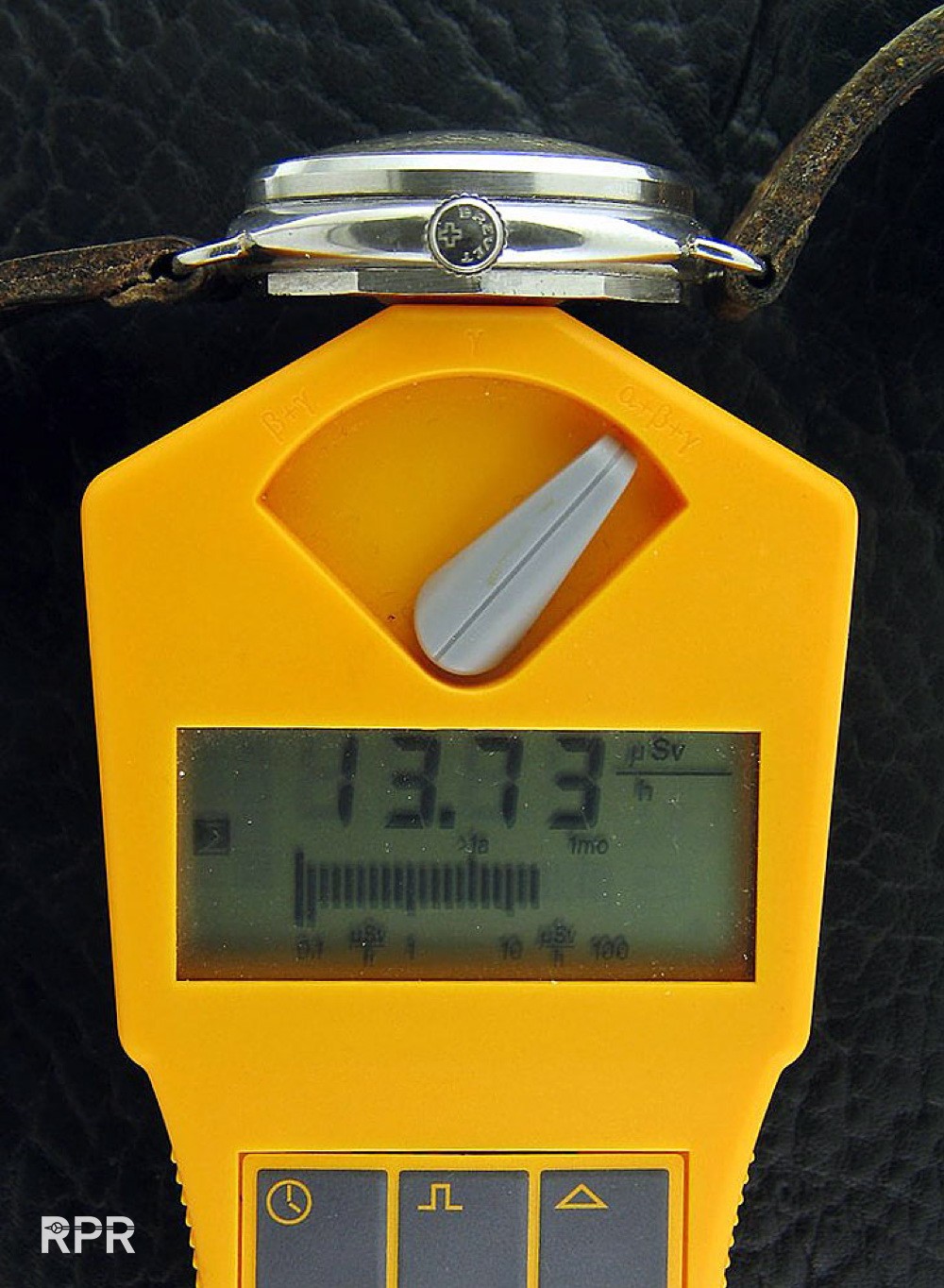
And up front it’s much higher. This ref 3646 is still in original untouched condition with it’s original crackle crystal..
A 1953 Rolex ref 6202 in untouched original condition showing us a high radium dial measurements…
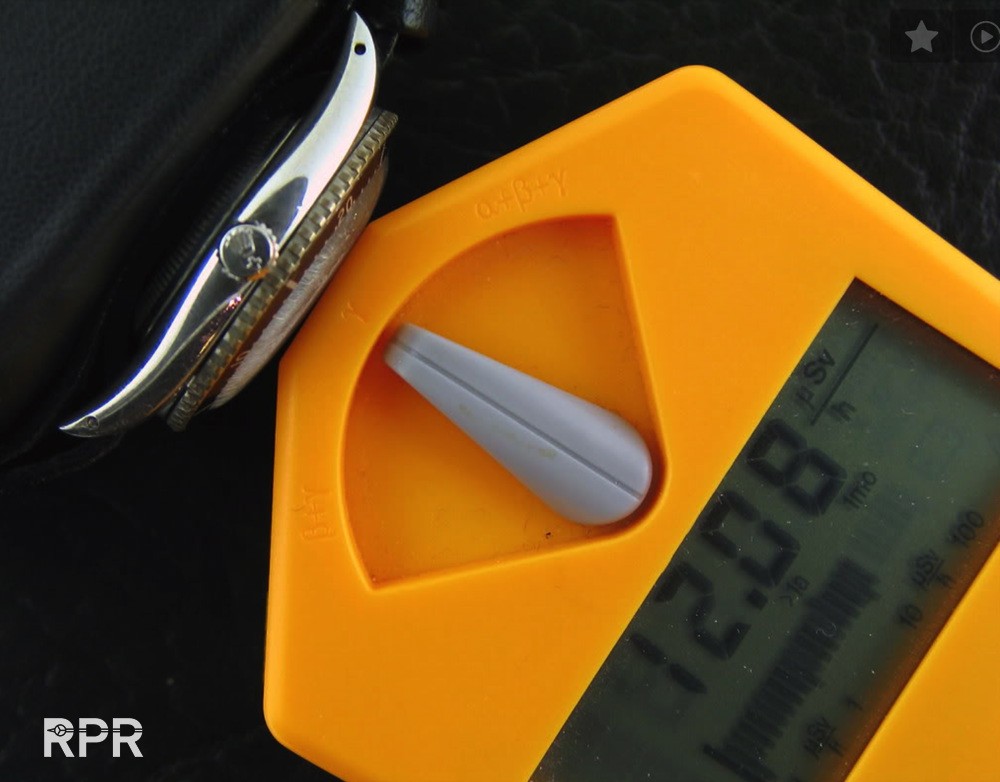
A Rolex ref 6542 up front, untouched 1958 example with bakelite radium bezel..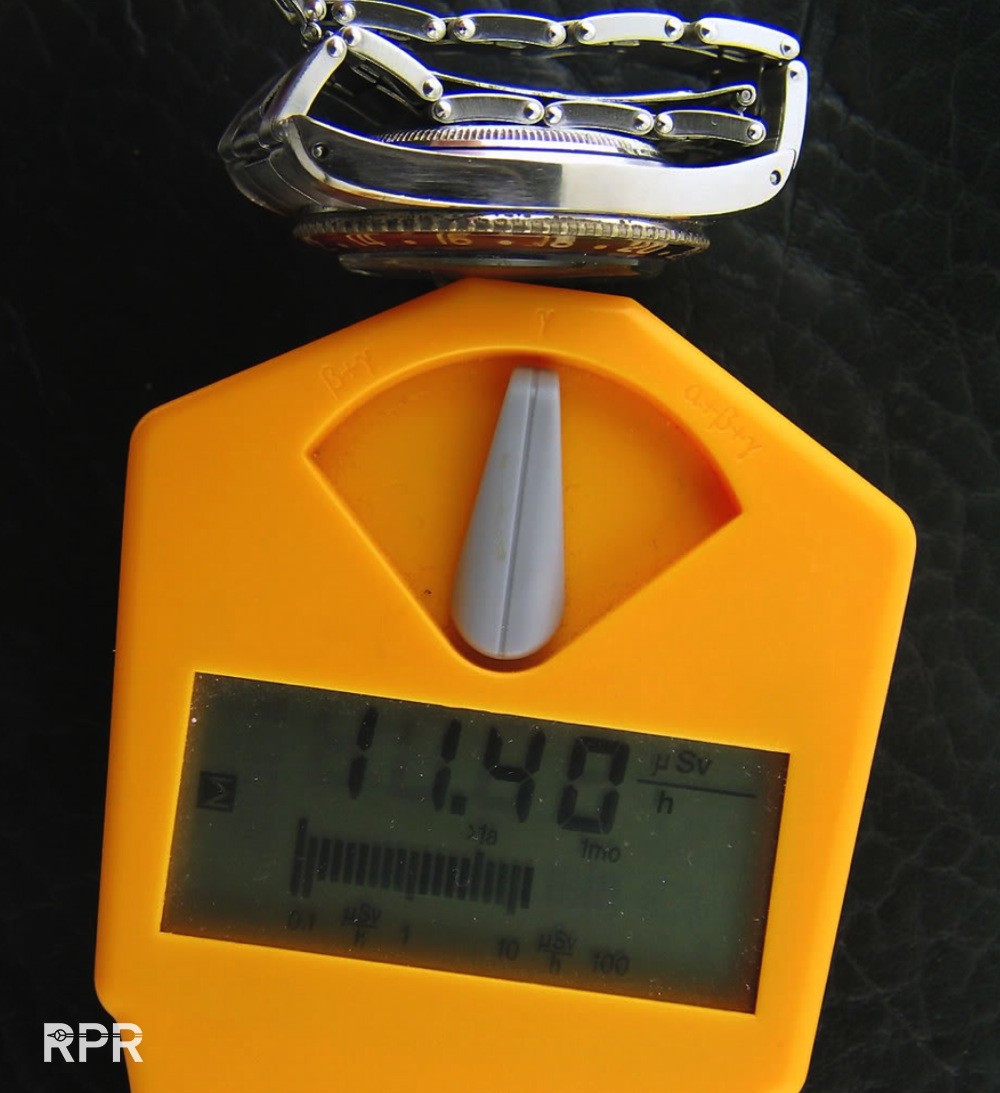
The geiger went really crazy on the early Panerai tools, below a high reading on a compass..
And on a original untouched Panerai depth meter…
From the Panerai book of Volker some more geiger results.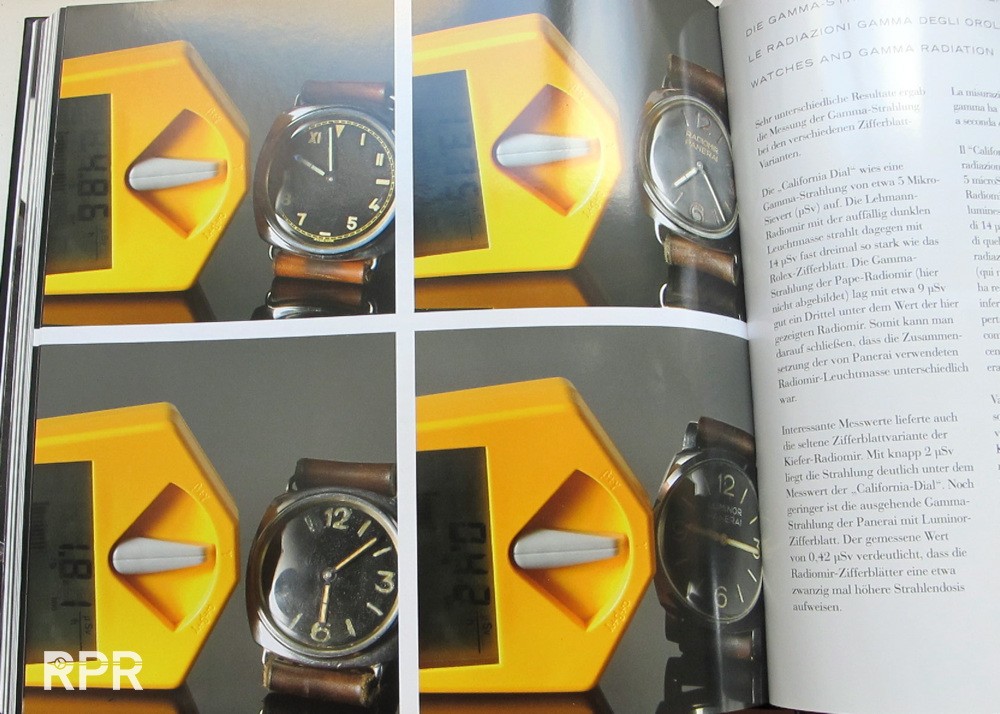 Another tip besides using a geiger meter is using ultra violet light to determine the presence of radium..
Another tip besides using a geiger meter is using ultra violet light to determine the presence of radium..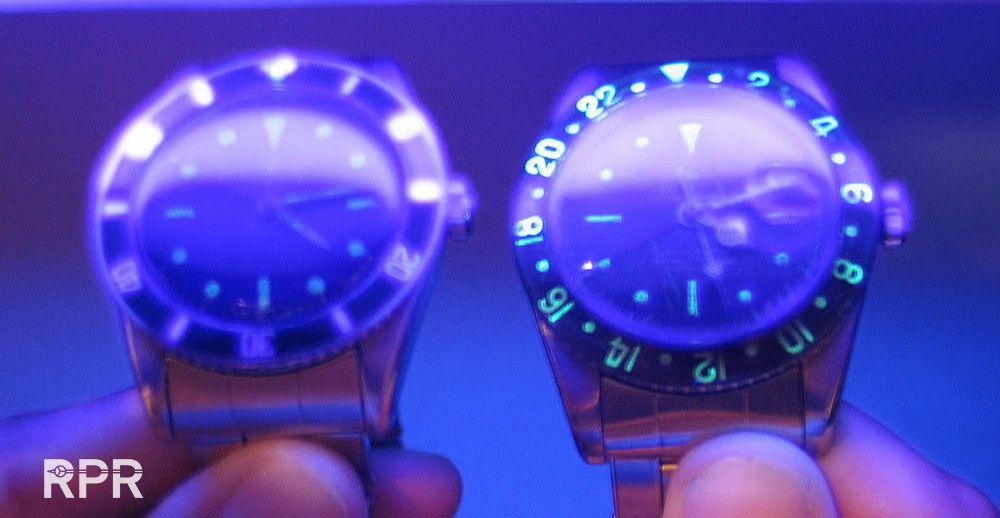 The bakelite bezel on the GMT Master ref 6542 was highly radio active. This has become a huge issue in Rolex past when a client bought his Rolex in the US and weaned to ship it out to Singapore, the government noticed the extreme radiation and started a investigation against Rolex in the US. All 600 plus examples that where sold in the US had to be tested on the presence of strontium 90.
The bakelite bezel on the GMT Master ref 6542 was highly radio active. This has become a huge issue in Rolex past when a client bought his Rolex in the US and weaned to ship it out to Singapore, the government noticed the extreme radiation and started a investigation against Rolex in the US. All 600 plus examples that where sold in the US had to be tested on the presence of strontium 90. 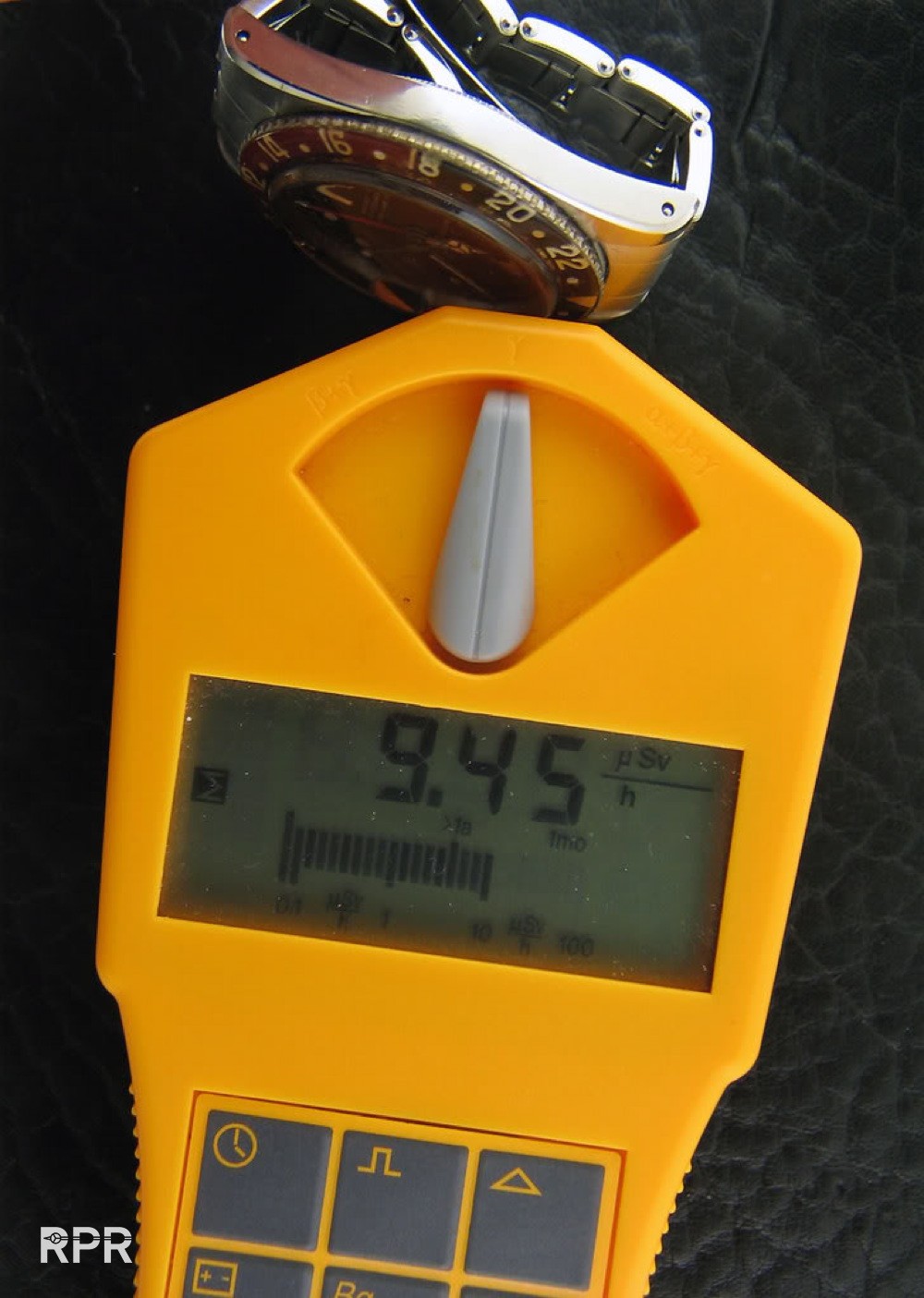 Below you see a official Rolex document that states that the 6542 GMT master has been tested and no violence of AEC regulations. (follow the link to more vintage Rolex study)
Below you see a official Rolex document that states that the 6542 GMT master has been tested and no violence of AEC regulations. (follow the link to more vintage Rolex study) 
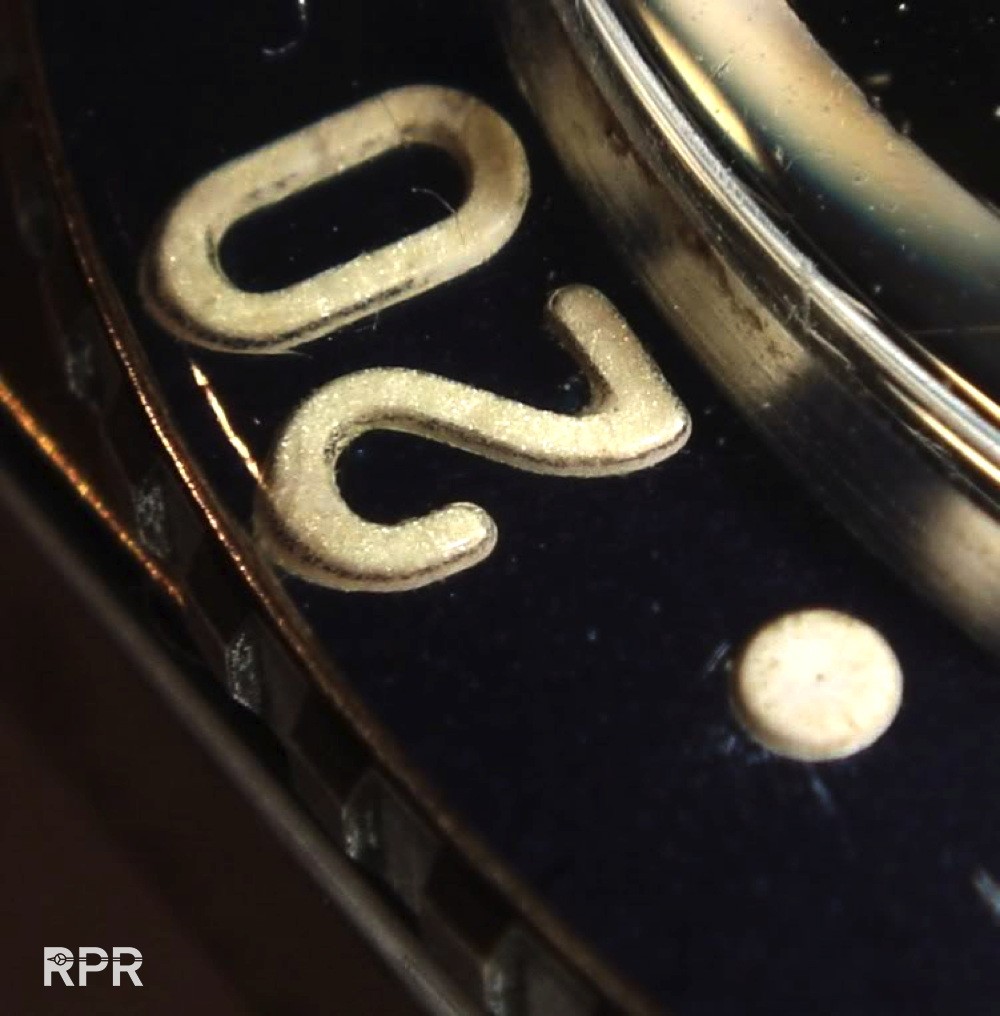
605 x Rolex GMT Masters Ref 6542’s where recalled in the US after regulation found out that the bezel was way to radioactive as you can read below….
Even more interesting is this old newspapers article saying that Rolex responded that the Atomic Energy Commission found “Only one 100 mens watch models”. Furthermore we can conclude that the 6542 wasn’t a commercial hit when Rolex said that the 605 GMT’s that had to be recalled where ” sold in a very small quantity due to the fact that it was a special purpose model”…
Above a close up of the bakelite GMT bezel and below the GMT Master 6542 of legendary explorer next to Jacques Piccard Deepest dive, Lt. Don Walsh.. 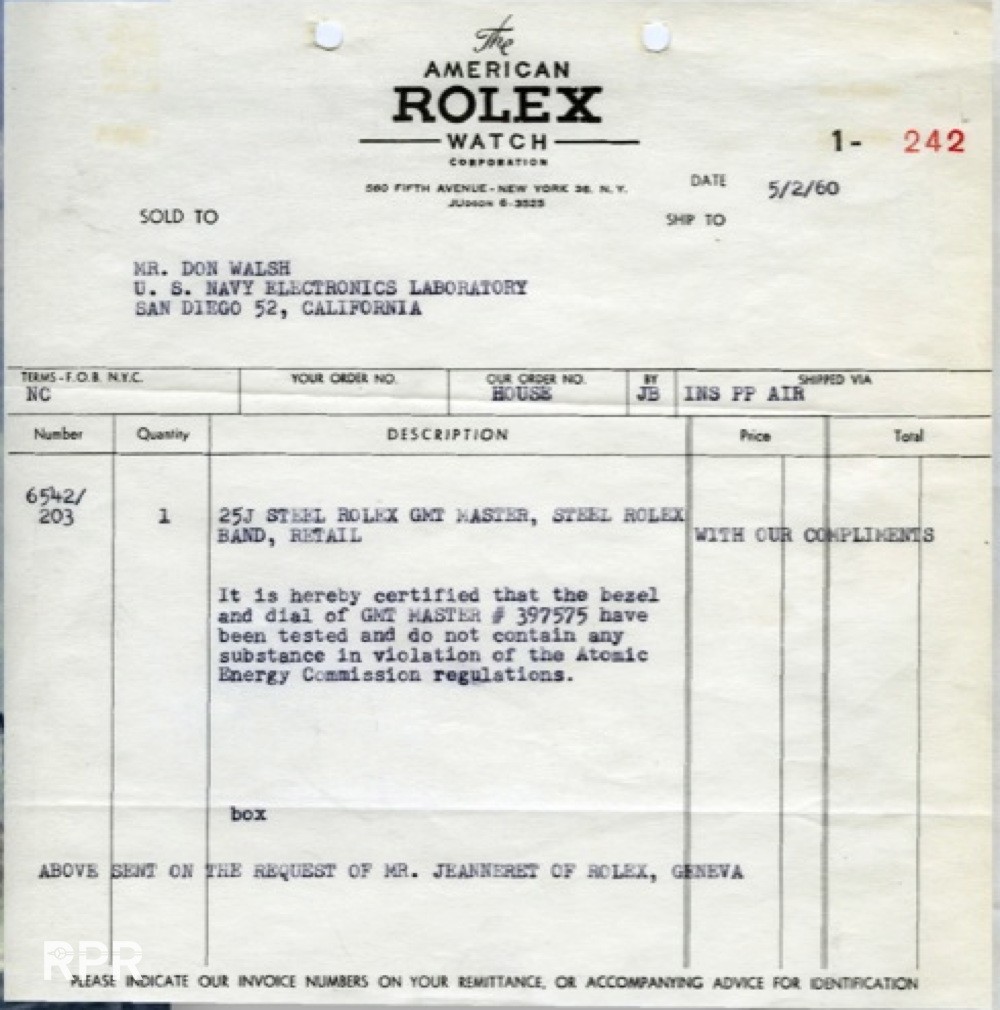
You see the bezel lights up, there where the dial is not reacting to the ultra violet light. Meaning the bezel is radium and the dial has been relumed with non radioactive material…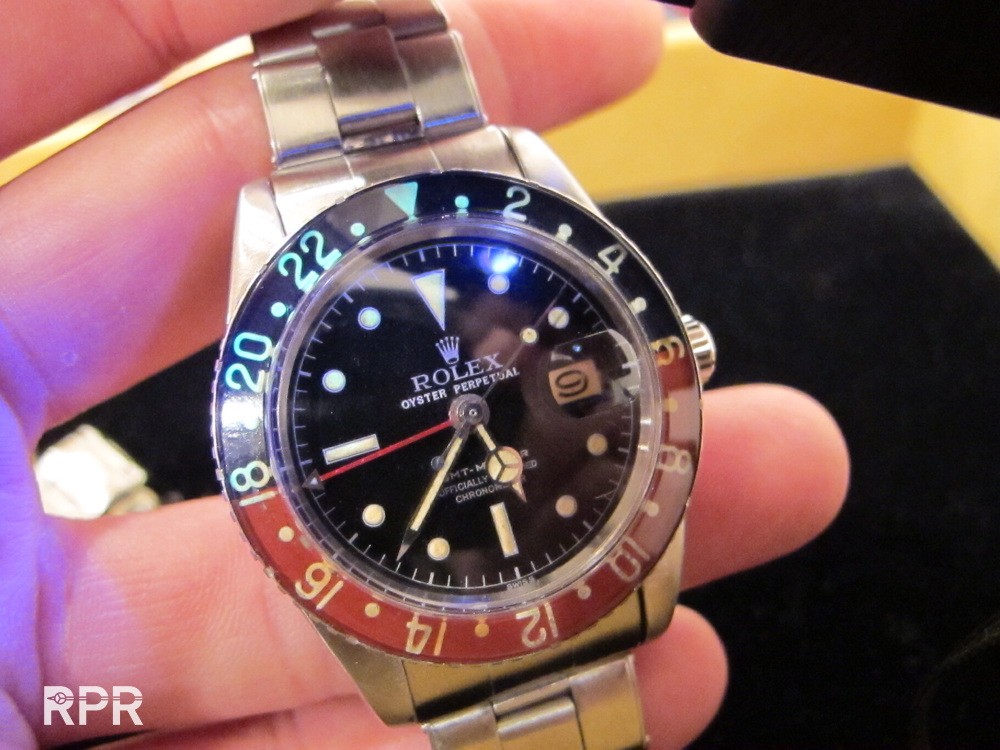
 Front radiation of a Big Crown 6538 and below the bright lightning 6 o’clock marker of a 5508 small crown under ultra violet light. The bright 6 o’clock marker was most probably done by Rolex designers to help divers read the dial in the dark quickly and clearly. The luminous dot that was added on the bezel and used for timing the dive is not logically always on the 12 o’clock spot so to help the visuality Rolex chanced the luminous of the 6 o’clock marker to a more greenish mixture is my consensus.
Front radiation of a Big Crown 6538 and below the bright lightning 6 o’clock marker of a 5508 small crown under ultra violet light. The bright 6 o’clock marker was most probably done by Rolex designers to help divers read the dial in the dark quickly and clearly. The luminous dot that was added on the bezel and used for timing the dive is not logically always on the 12 o’clock spot so to help the visuality Rolex chanced the luminous of the 6 o’clock marker to a more greenish mixture is my consensus. 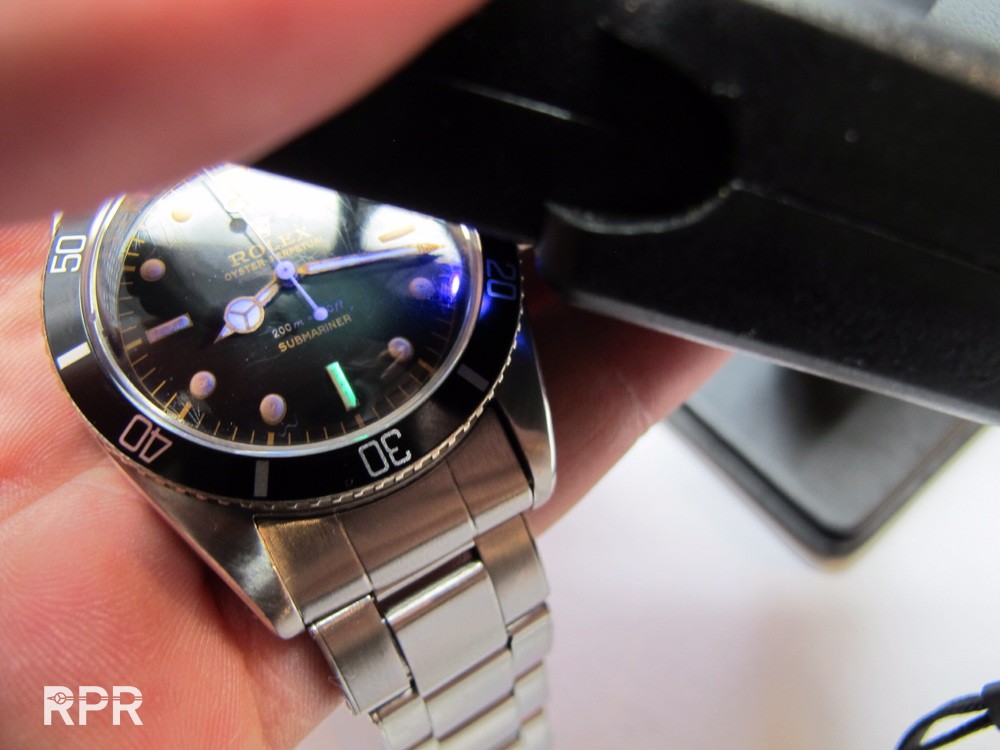 Below you see a early Submariner which has been resumed with luminous. Not always will the Geiger meter give you 100 % proof as nowadays specialist are using old radium to relume a dial. But if you look closely you will see that the luminous is not perfectly added within the round plots, clearly not a Rolex job.
Below you see a early Submariner which has been resumed with luminous. Not always will the Geiger meter give you 100 % proof as nowadays specialist are using old radium to relume a dial. But if you look closely you will see that the luminous is not perfectly added within the round plots, clearly not a Rolex job. 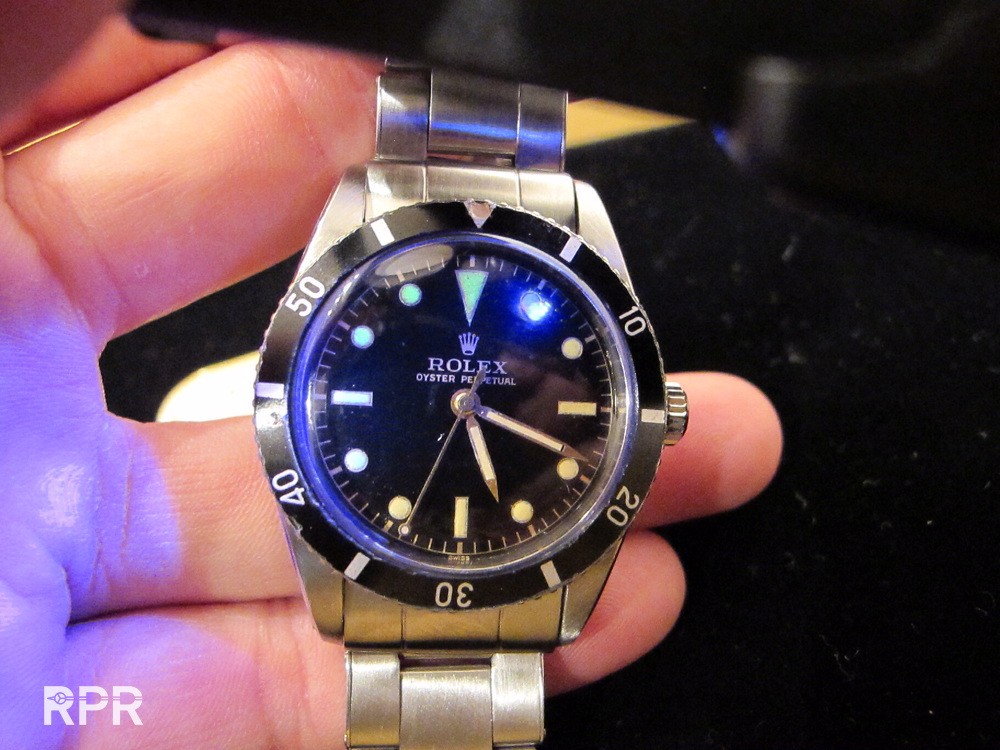 Geiger alert on first generation Submariner…
Geiger alert on first generation Submariner… 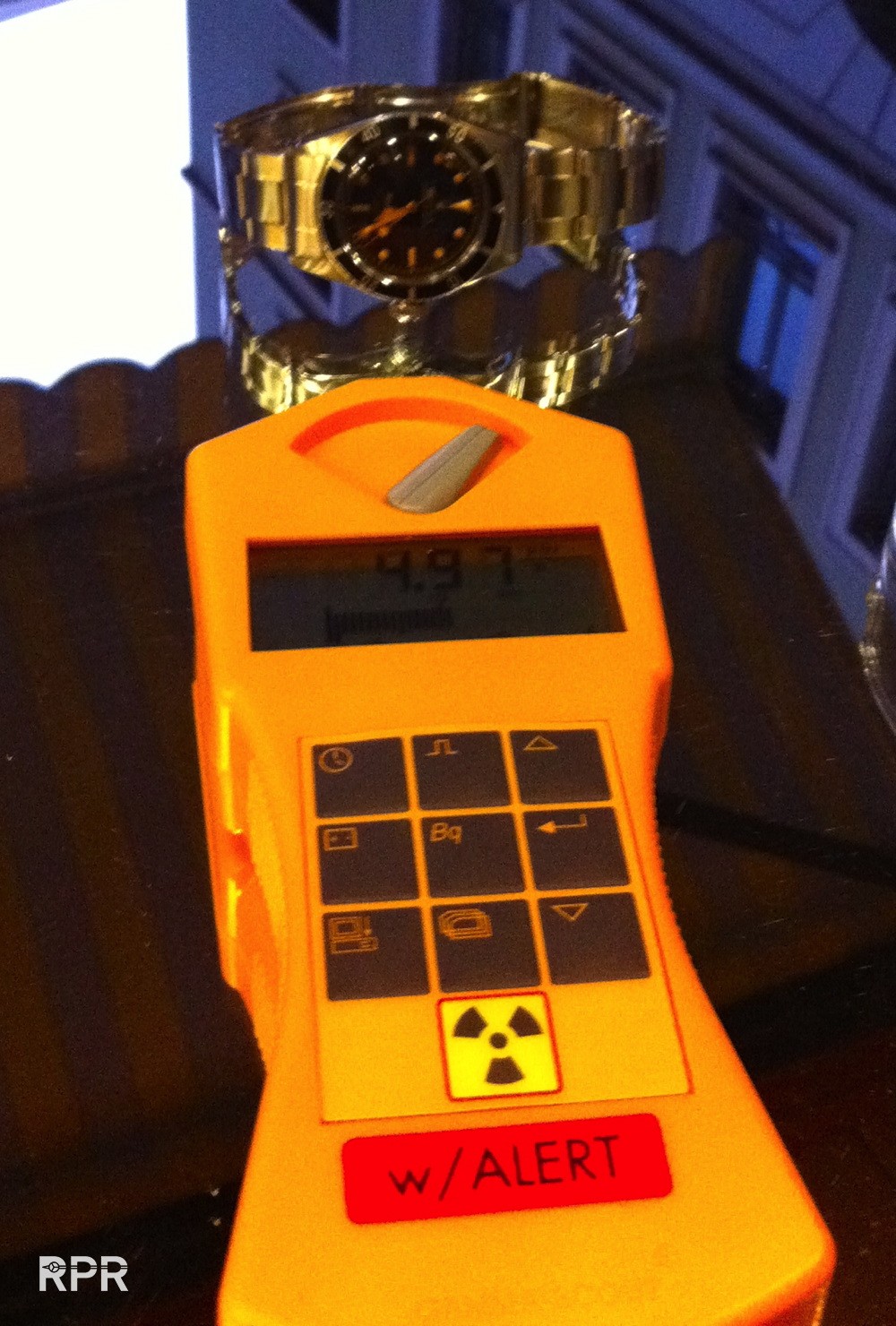 Big Crown 6538 forms second generation, produced in 1958 with glossy gilt dial and radium luminous…
Big Crown 6538 forms second generation, produced in 1958 with glossy gilt dial and radium luminous… 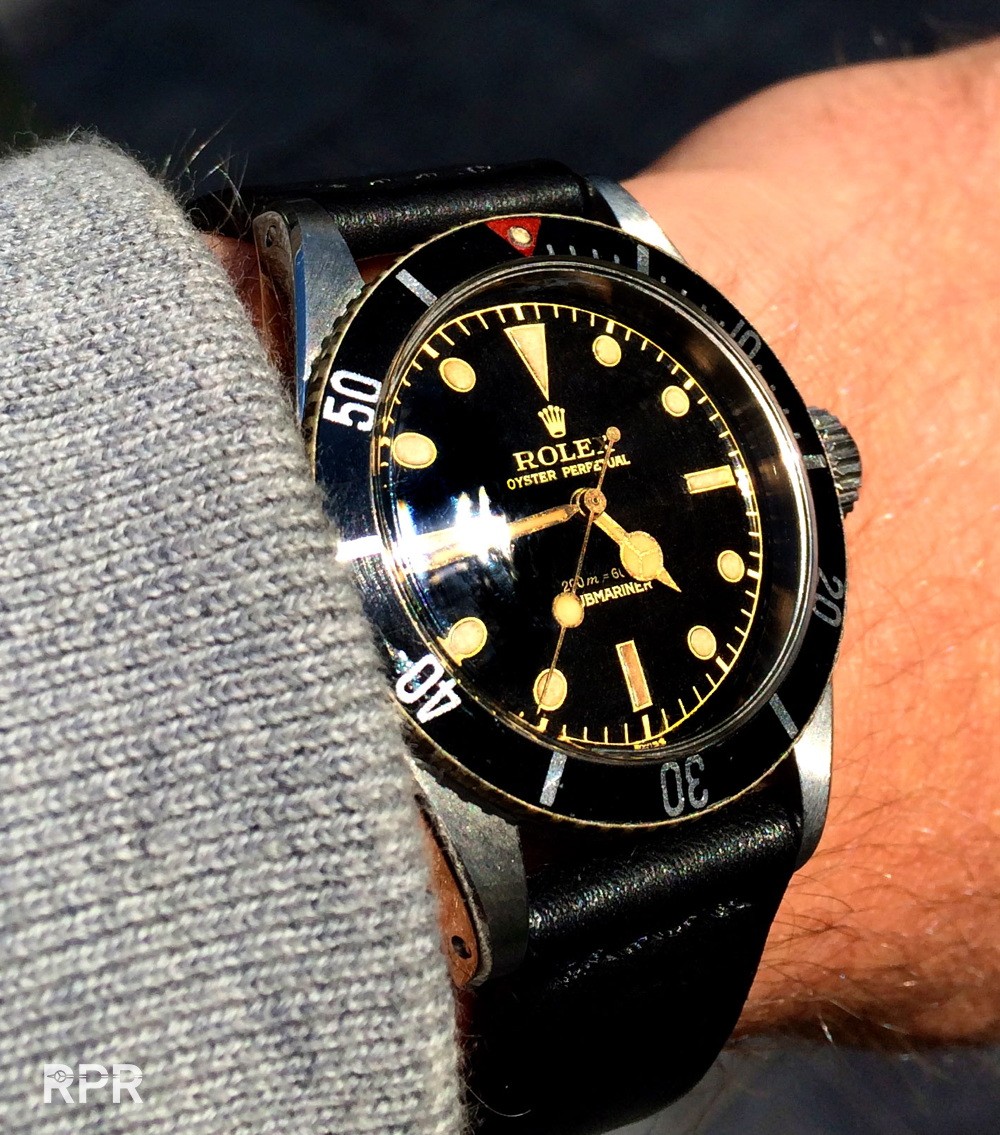 Original condition of a rare 369 Submariner version when it was discovered. You see the stains of oxidation on the surface, something that can easily be cleaned..
Original condition of a rare 369 Submariner version when it was discovered. You see the stains of oxidation on the surface, something that can easily be cleaned.. 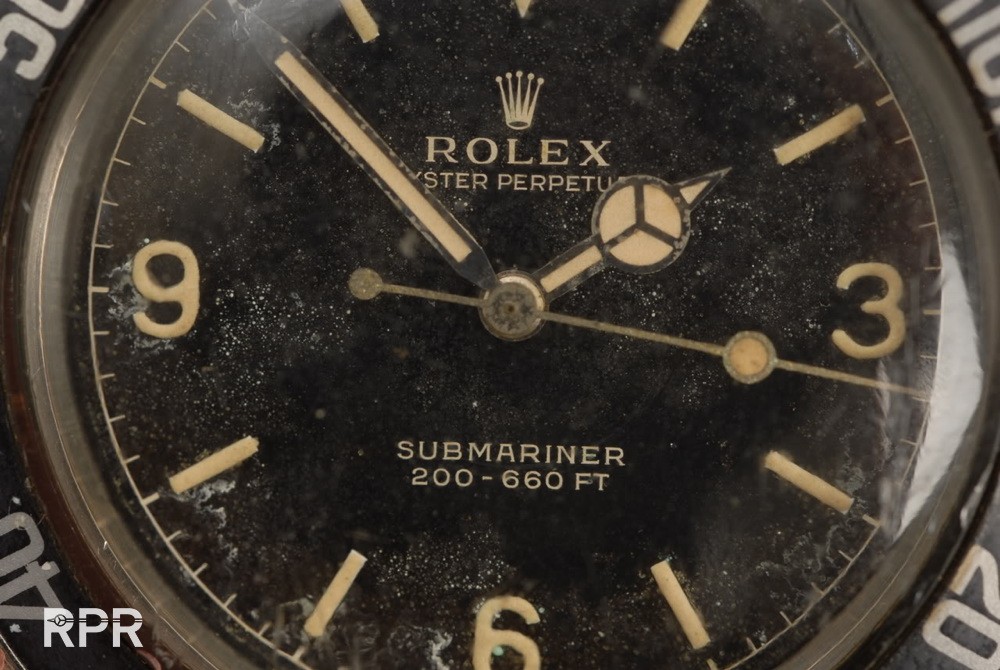 Radium swiss Rolex ref 6234 with original luminous. All plots are perfectly shaped and color on the dial is matching the luminous of the hands, first owner find..
Radium swiss Rolex ref 6234 with original luminous. All plots are perfectly shaped and color on the dial is matching the luminous of the hands, first owner find.. 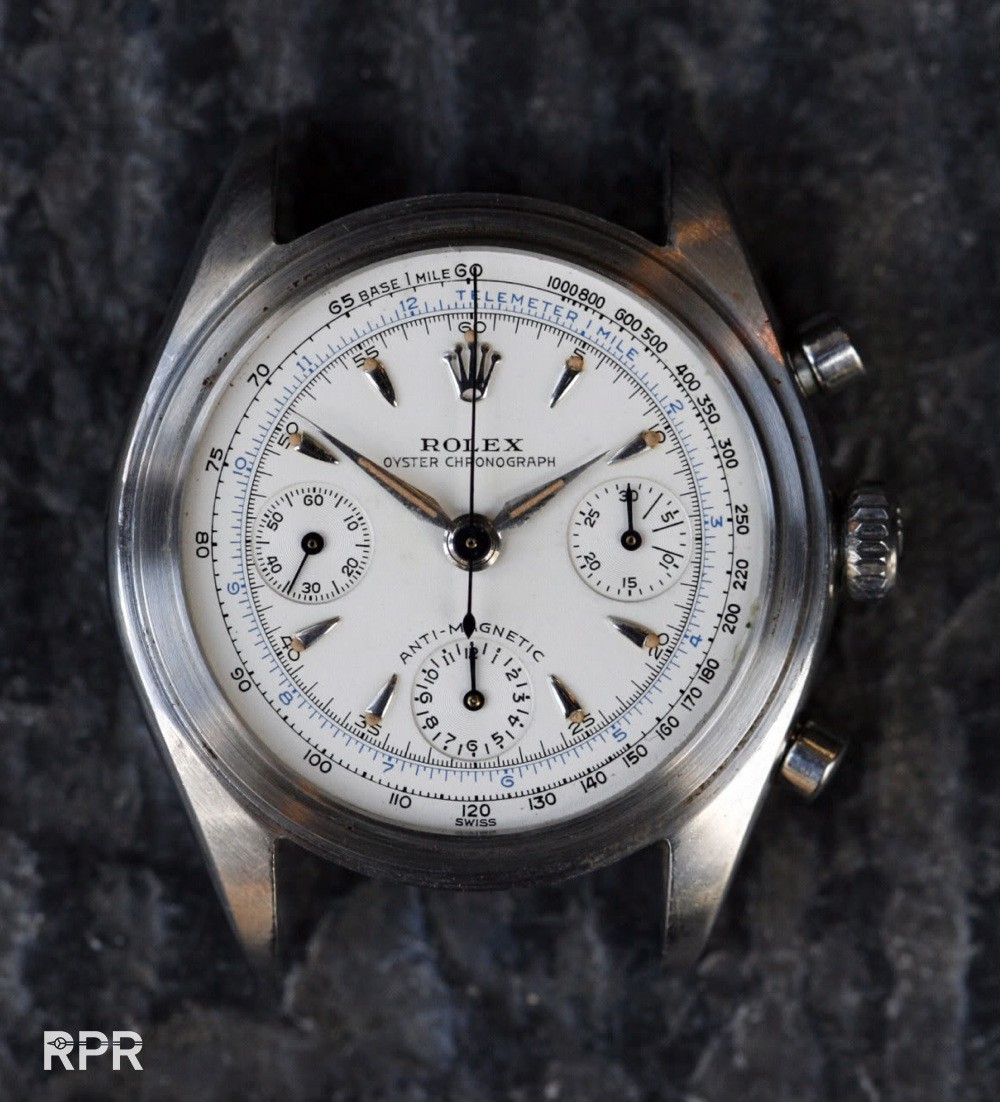 The same we see in following examples, a rare waffle diales Datejust with radium luminous on dial and hands…
The same we see in following examples, a rare waffle diales Datejust with radium luminous on dial and hands… 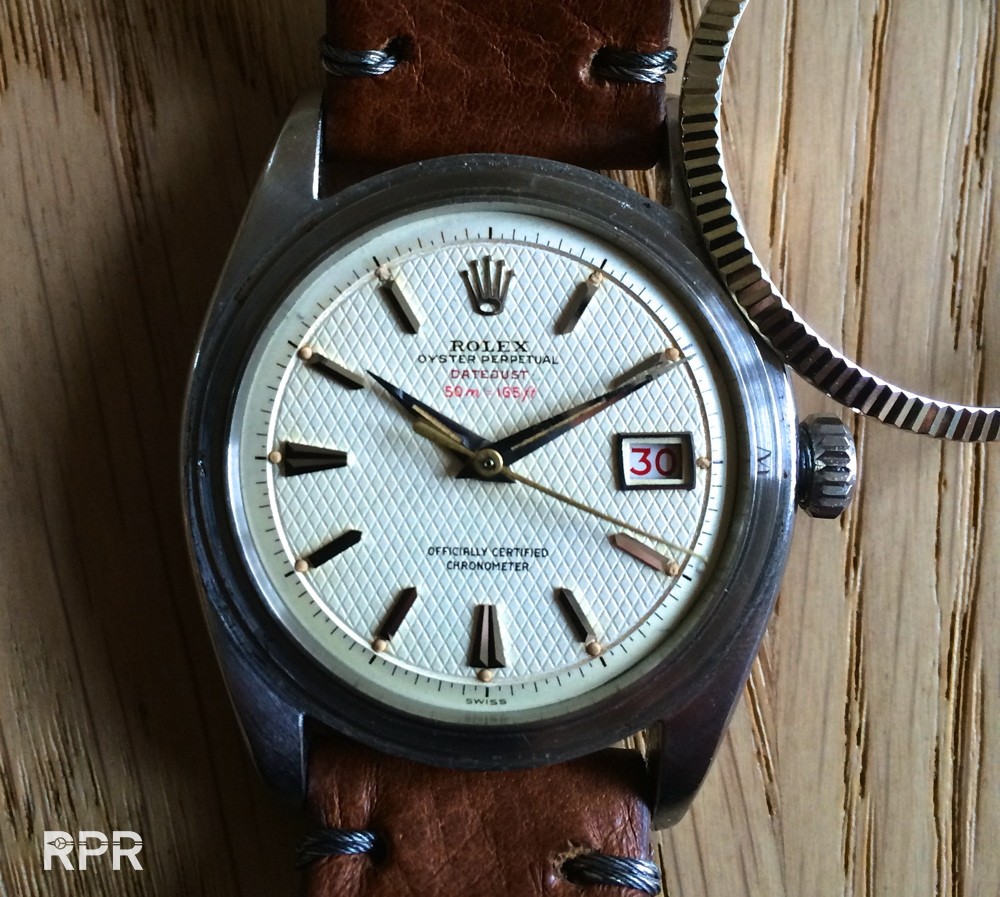 A second generation Rolex small crown what got serviced early 60-ies but except the bezel insert, still has it’s original dial and gilt hands…
A second generation Rolex small crown what got serviced early 60-ies but except the bezel insert, still has it’s original dial and gilt hands… 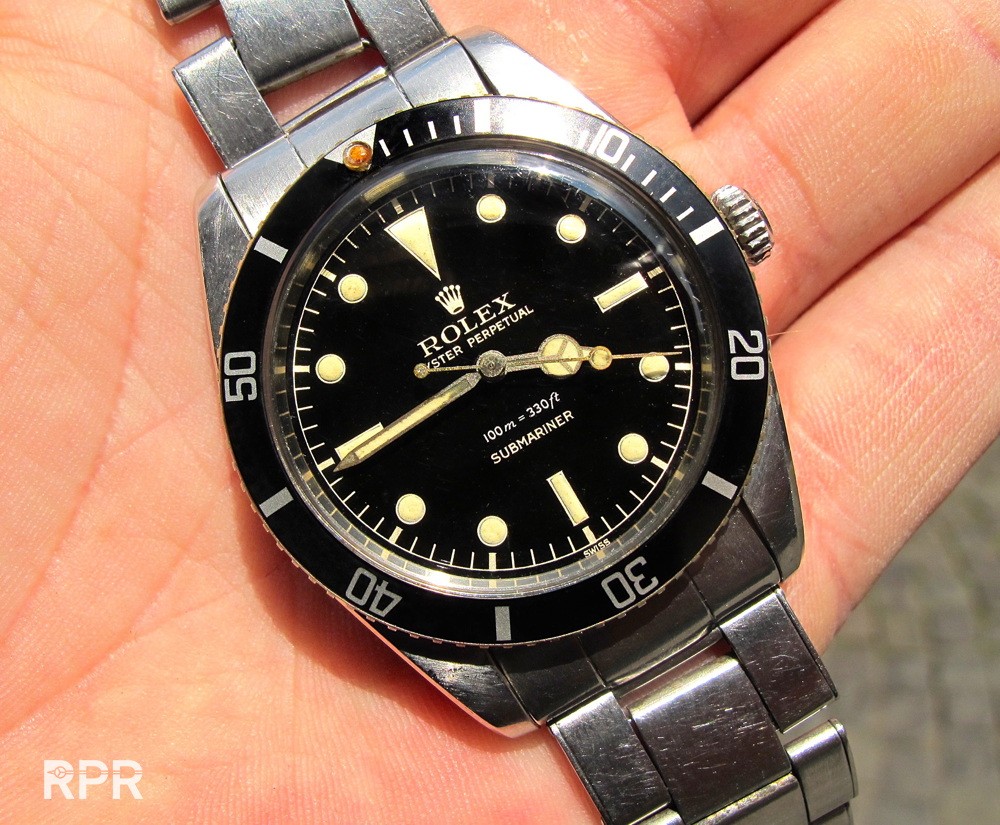 A early Big Crown ref 6538 minute track service dial with tritium ( Swiss – T<25 ) Different coronet and print technique..
A early Big Crown ref 6538 minute track service dial with tritium ( Swiss – T<25 ) Different coronet and print technique.. 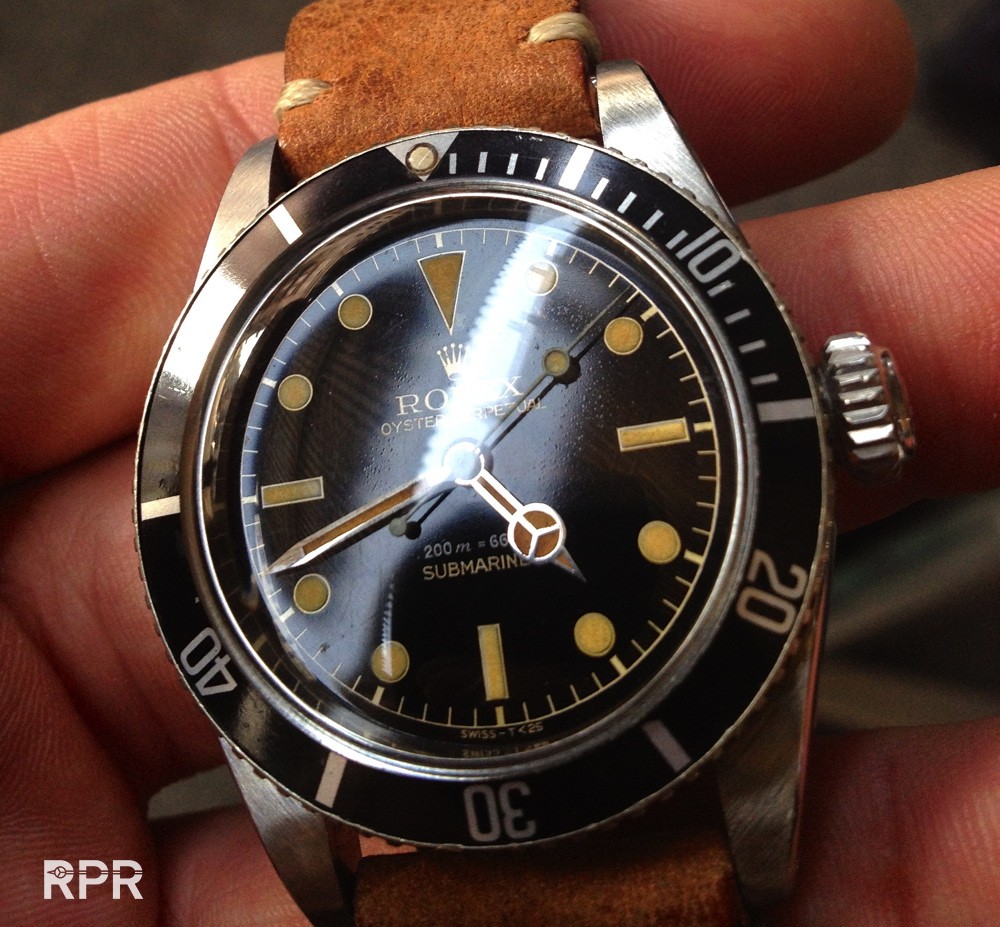 A 1958 Rolex Small Crown Submariner Ref 5508 with it’s original bezel and spidered tropical dial. We see the humidity in the hands turned a bit green.
A 1958 Rolex Small Crown Submariner Ref 5508 with it’s original bezel and spidered tropical dial. We see the humidity in the hands turned a bit green. 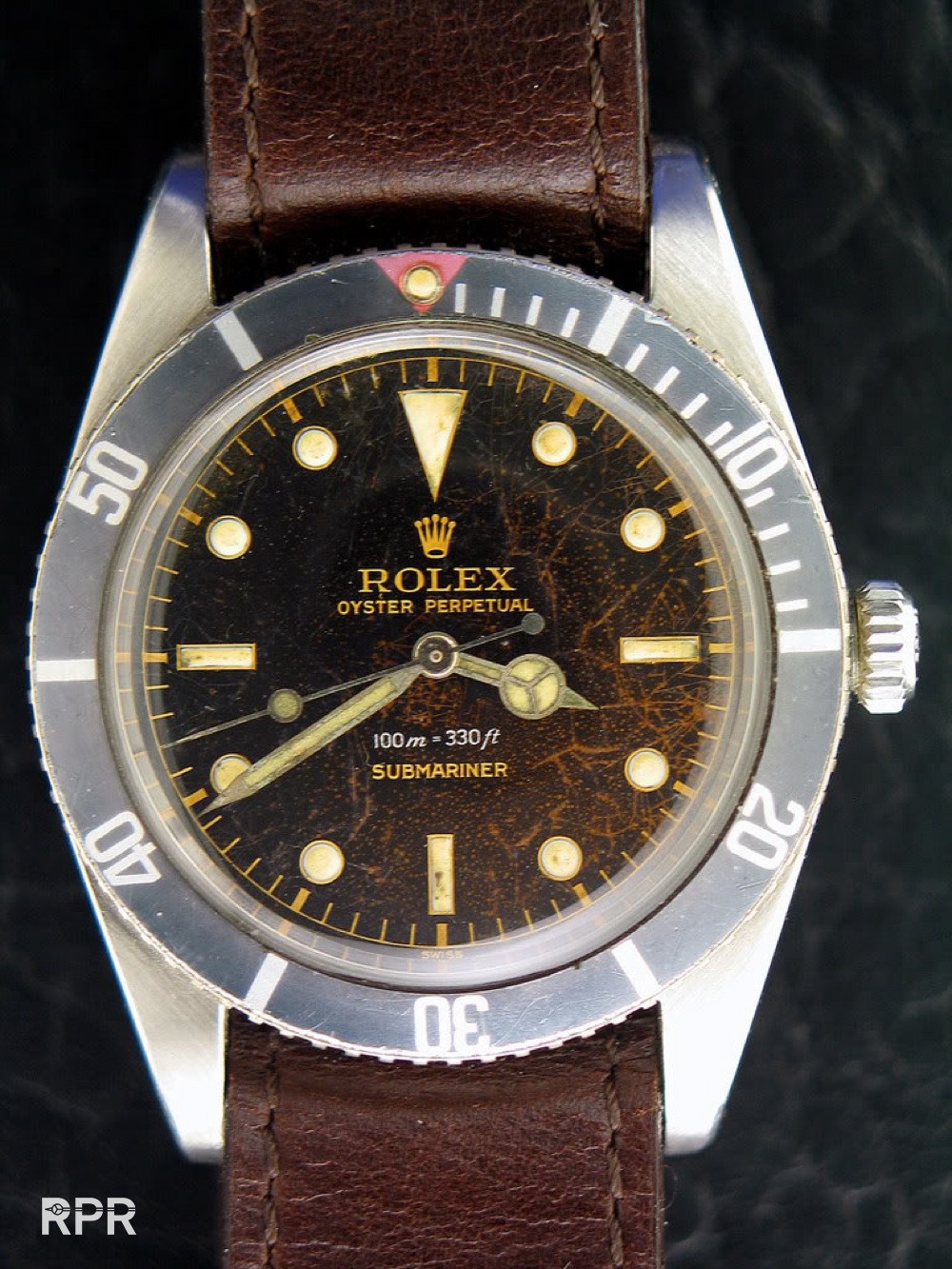
A ‘burned’ Big Crown dial that due to humidity, dry storage and lot’s of UV light chanced color and cracked in the surface.. 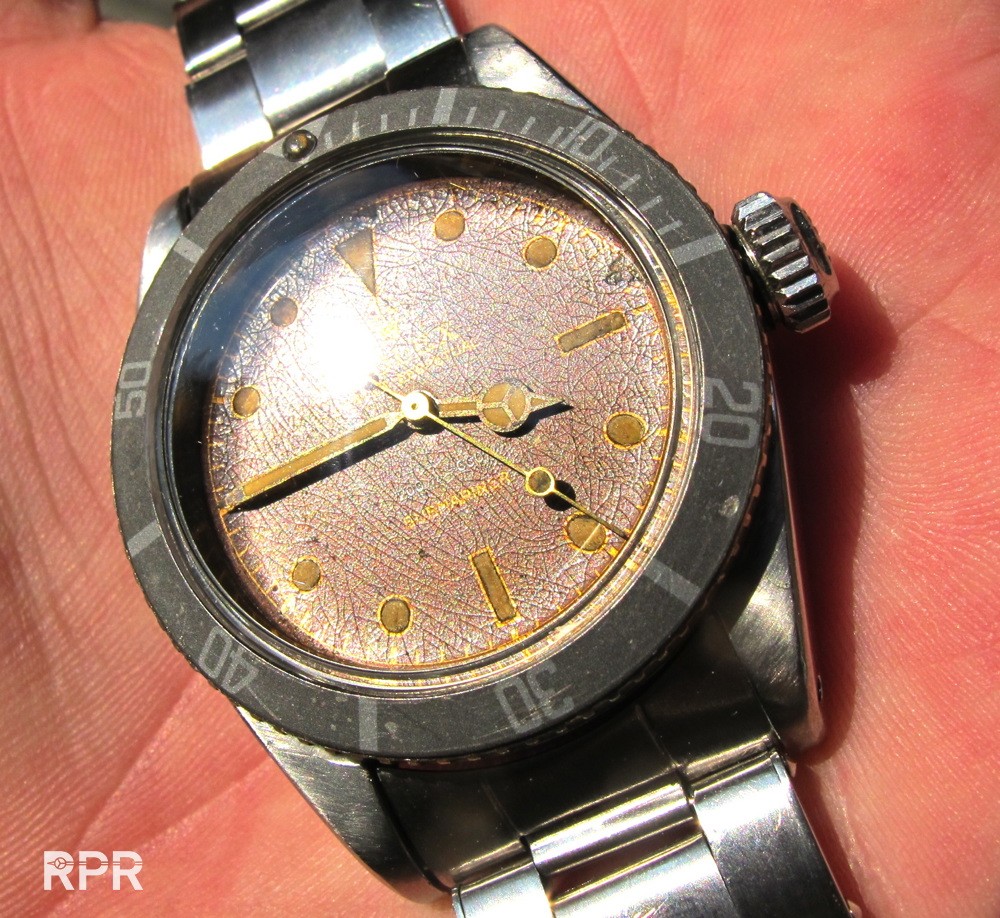 Below you see how the moisture the radium chanced to green spots around the luminous dots on the dial. Nobody would really care about this face unless you see the backside…
Below you see how the moisture the radium chanced to green spots around the luminous dots on the dial. Nobody would really care about this face unless you see the backside… 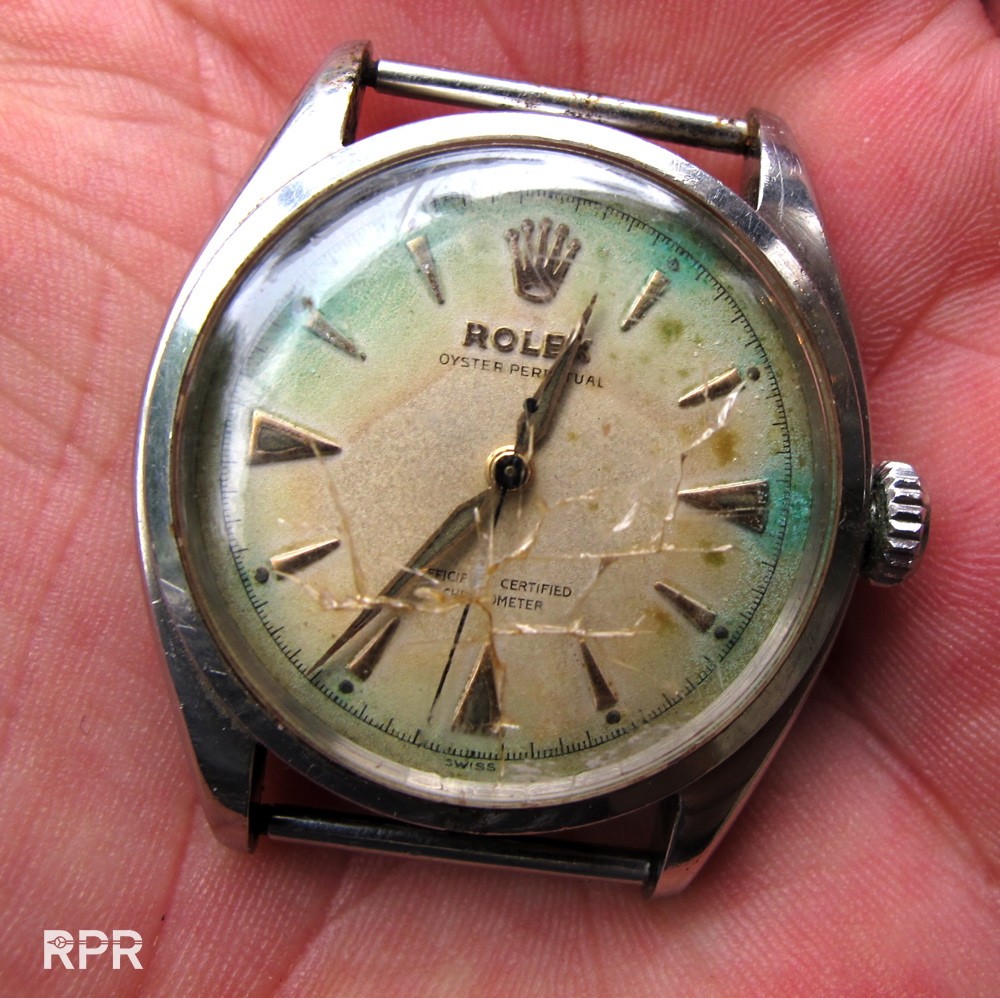 To Sir E. Hillary from Rolex Bosecks, Calcutta 😉
To Sir E. Hillary from Rolex Bosecks, Calcutta 😉 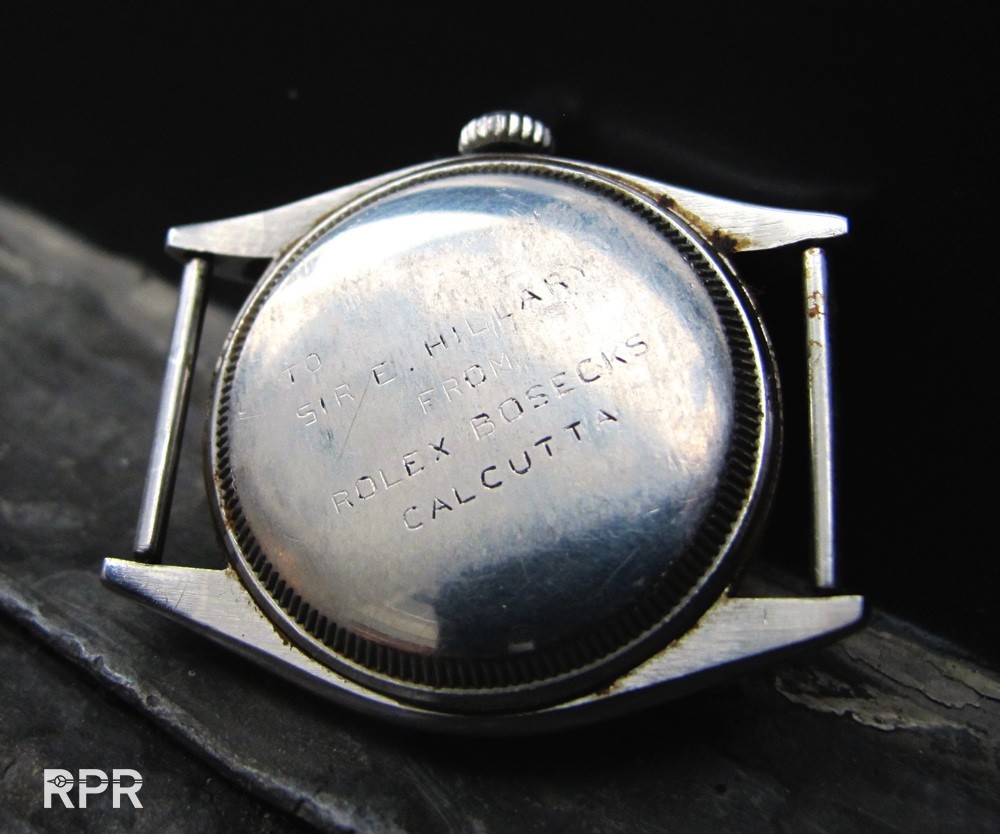 Last version of the Big Crown dial, the luminous becomes less aggressive and much brighter then we have seen before. Also the coronet is different then the typical small & big crown version we are used to. It’s more like the early 1959 Submariner 5512 ‘ thin fingers’ coronet..
Last version of the Big Crown dial, the luminous becomes less aggressive and much brighter then we have seen before. Also the coronet is different then the typical small & big crown version we are used to. It’s more like the early 1959 Submariner 5512 ‘ thin fingers’ coronet.. 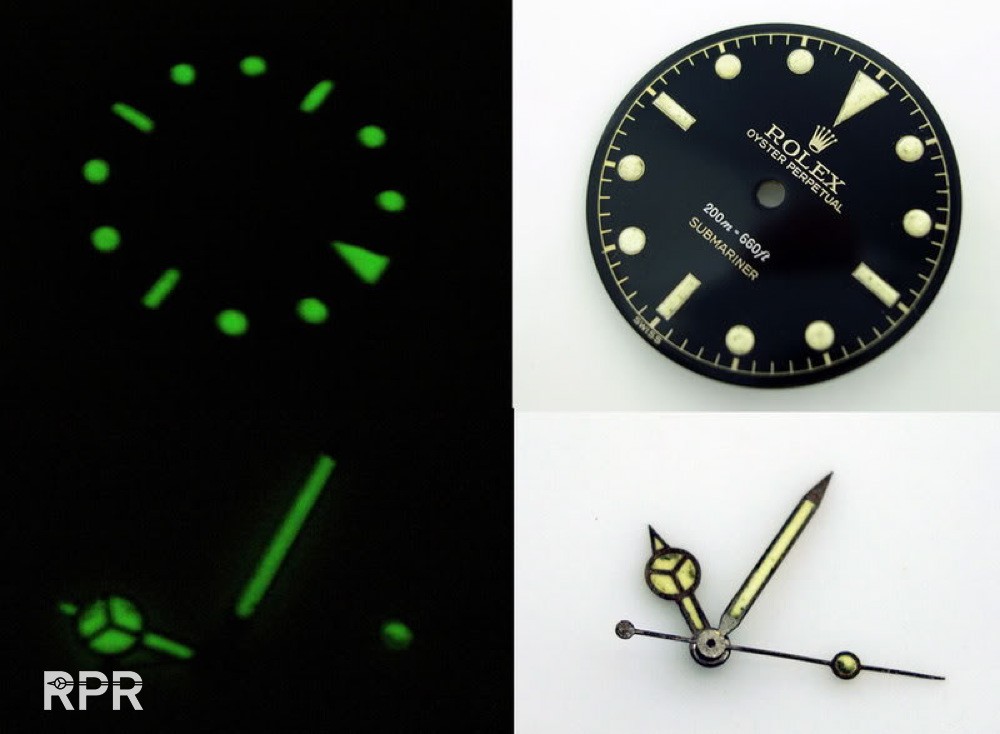 Same much brighter almost greenish colored luminous we see on the last version of the small crown, here below 5508 SCOC 4 liner…
Same much brighter almost greenish colored luminous we see on the last version of the small crown, here below 5508 SCOC 4 liner…  Around 1962 we see the exclamation mark, the little extra dot at 6 o’clock added on top of the dial is most probably a first sign of the dial maker to show Rolex (US – Canada?) clients that radiation has been adjusted to a lower degree..
Around 1962 we see the exclamation mark, the little extra dot at 6 o’clock added on top of the dial is most probably a first sign of the dial maker to show Rolex (US – Canada?) clients that radiation has been adjusted to a lower degree..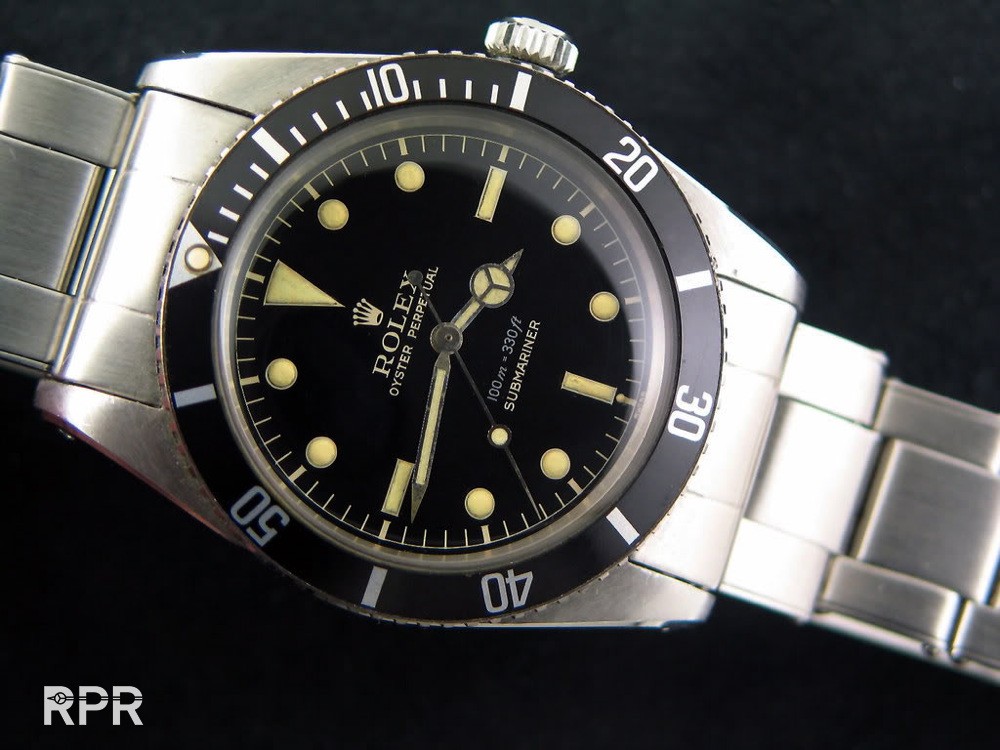 Below you see a comparison of first generation (1953-1956) first 2, second generation ( 1957-1960) and third generation ( 1960-1962) on the far left
Below you see a comparison of first generation (1953-1956) first 2, second generation ( 1957-1960) and third generation ( 1960-1962) on the far left 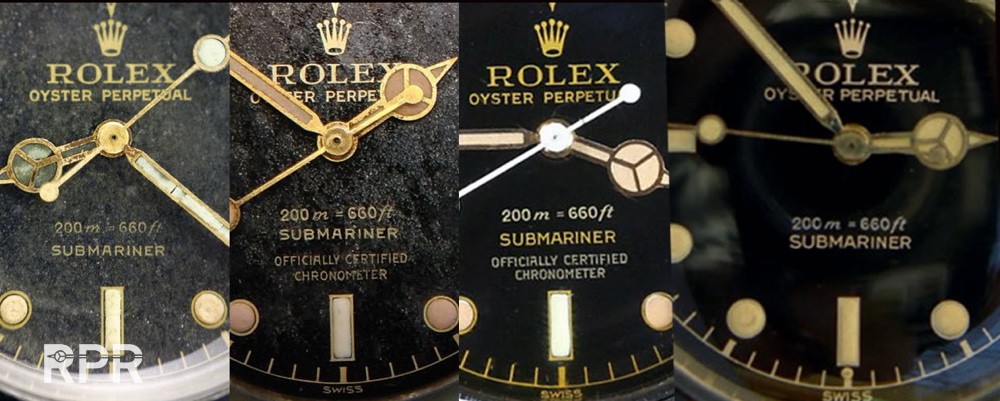 The pre transitional period shows us brighter luminous, this particular small crown Ref 5508 is having a “exclamation mark” we see around 1962 (follow the link to more vintage Rolex study)
The pre transitional period shows us brighter luminous, this particular small crown Ref 5508 is having a “exclamation mark” we see around 1962 (follow the link to more vintage Rolex study) 
Here a perfect example of 1959-1960 luminous on a tropical ref 5512 chapter ring…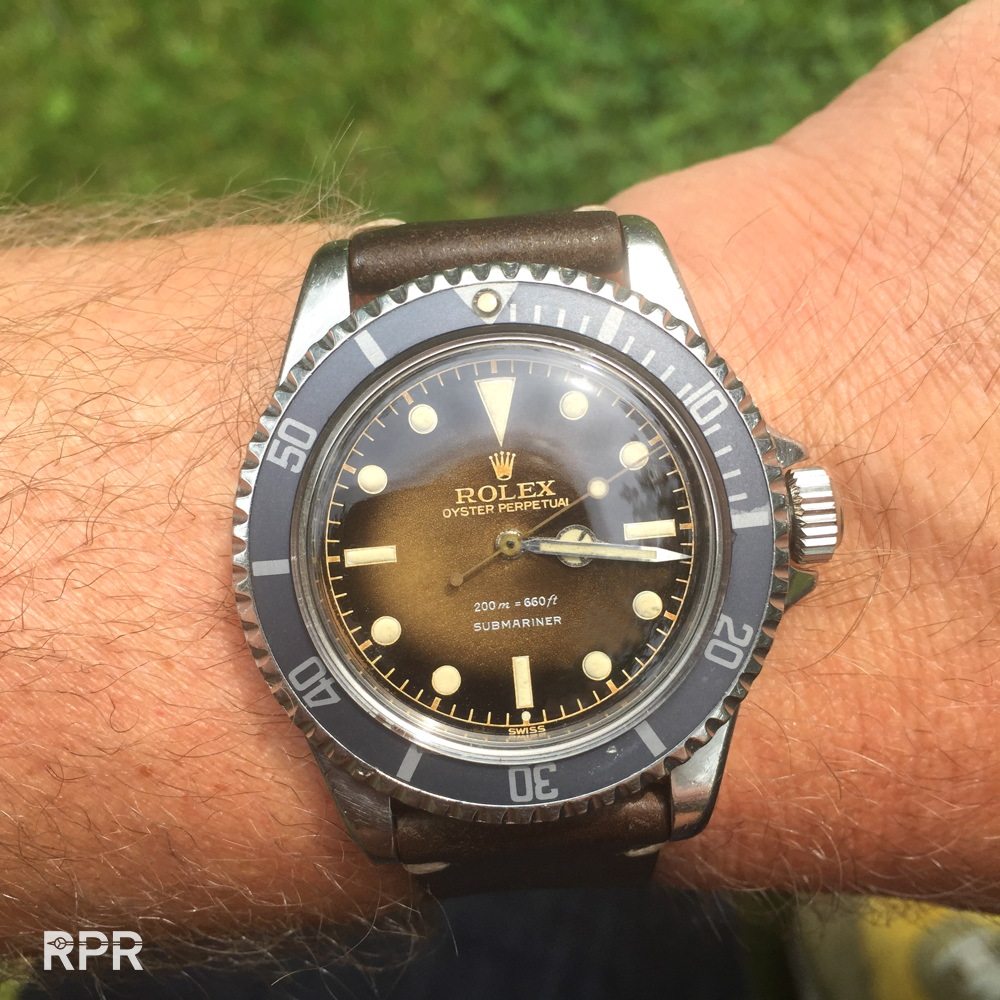
Close up of a late minute track Submariner ref. 5512 SCOC, again we bright luminous added on the glossy dial.. 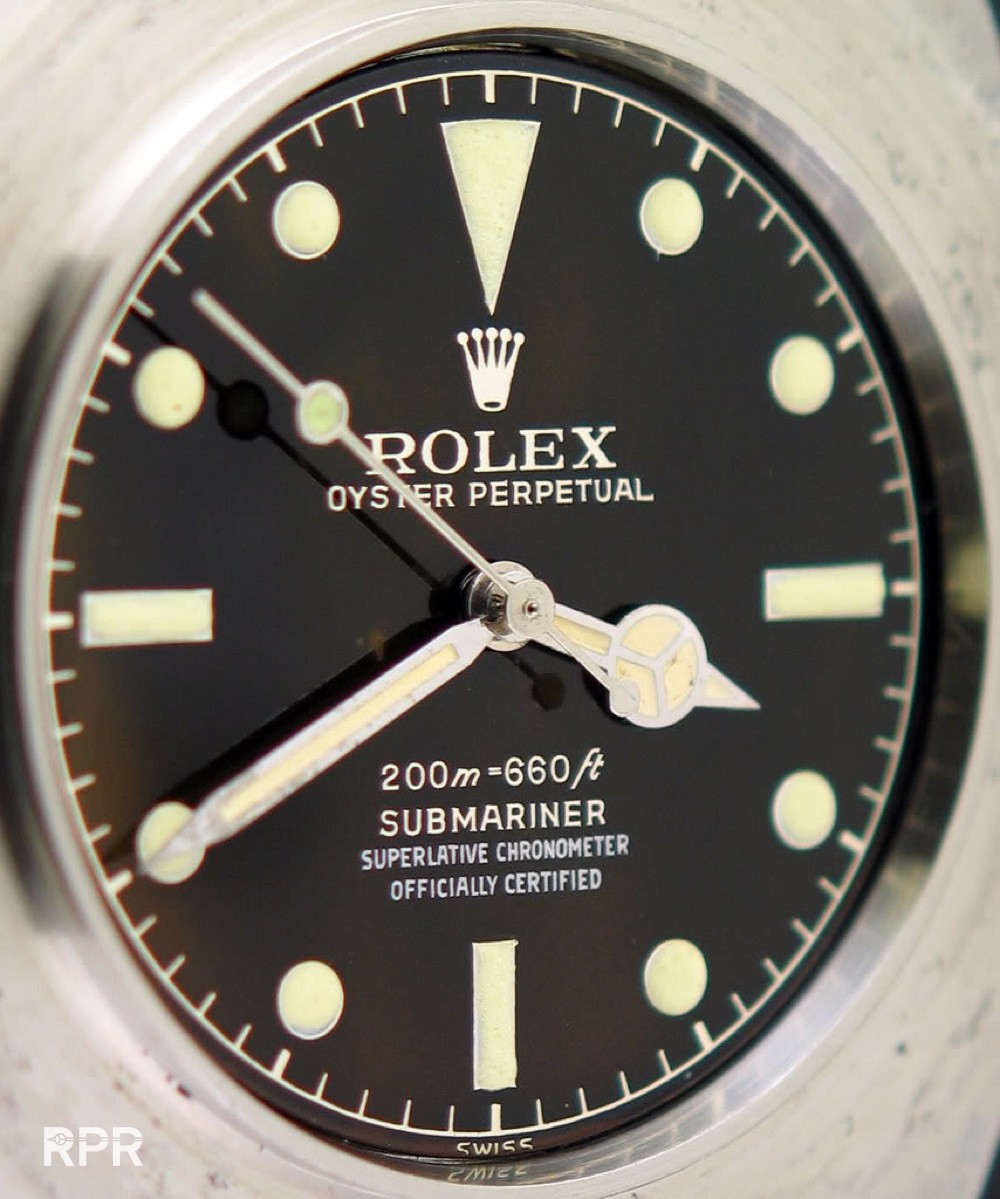 Transitional “Underline” Ref. 5512 on the left and slightly earlier minute track on the right…
Transitional “Underline” Ref. 5512 on the left and slightly earlier minute track on the right… 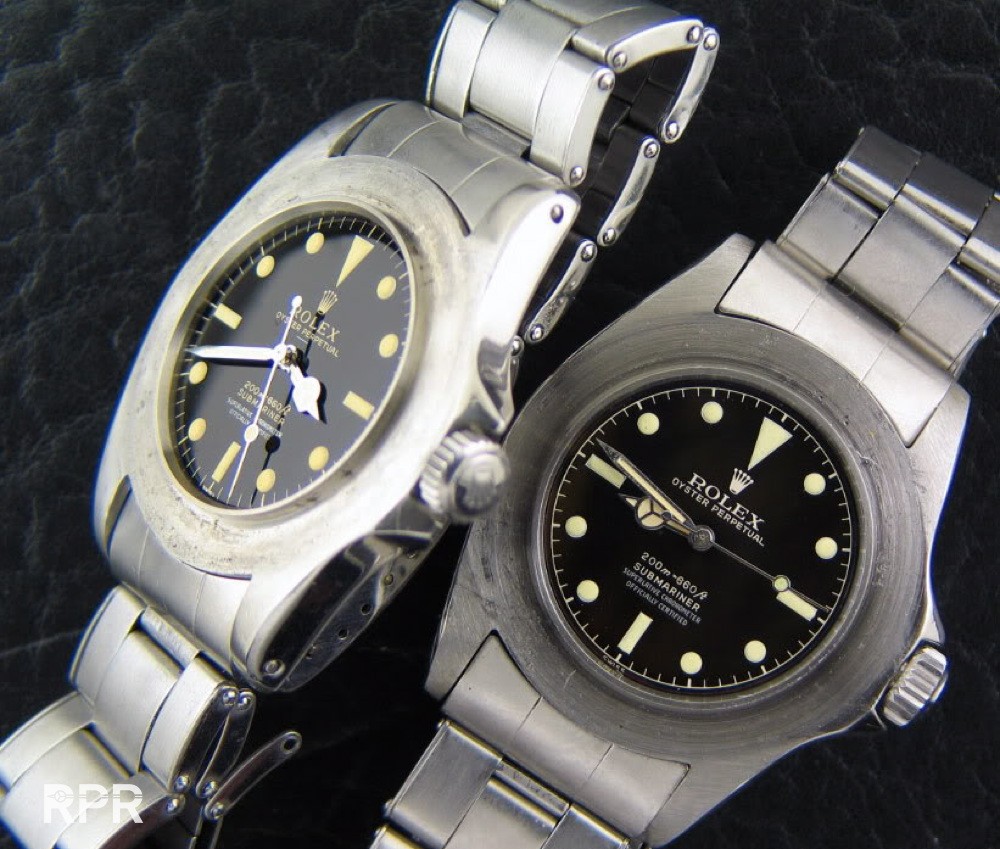
A transitional “Underline” which has been placed between Submariner & SCOC and a “White Swiss” added on top of the track. We see that the surface is slightly speckled, something thats more usual then unusual with these transitional dials. Seems like the quality was not perfect. A older dial plate used for a newer case design perhaps? 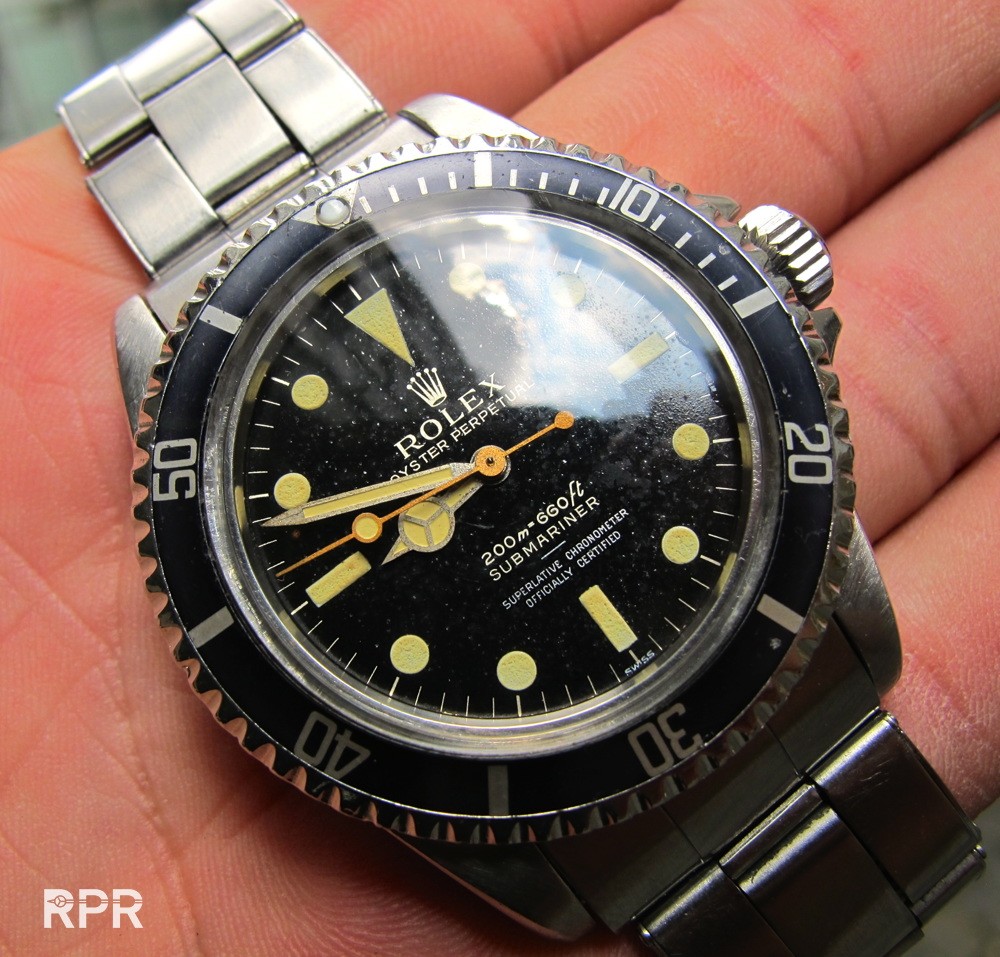 Close up of the “White Swiss” added on top of the track..(follow the link to more vintage Rolex study)
Close up of the “White Swiss” added on top of the track..(follow the link to more vintage Rolex study)  Fully gloss Ref 6234 chronograph dial where the “Underline” & “Anti-Magnetic” is added later. Obviously a old style dial design that got luminated with tritium.
Fully gloss Ref 6234 chronograph dial where the “Underline” & “Anti-Magnetic” is added later. Obviously a old style dial design that got luminated with tritium. 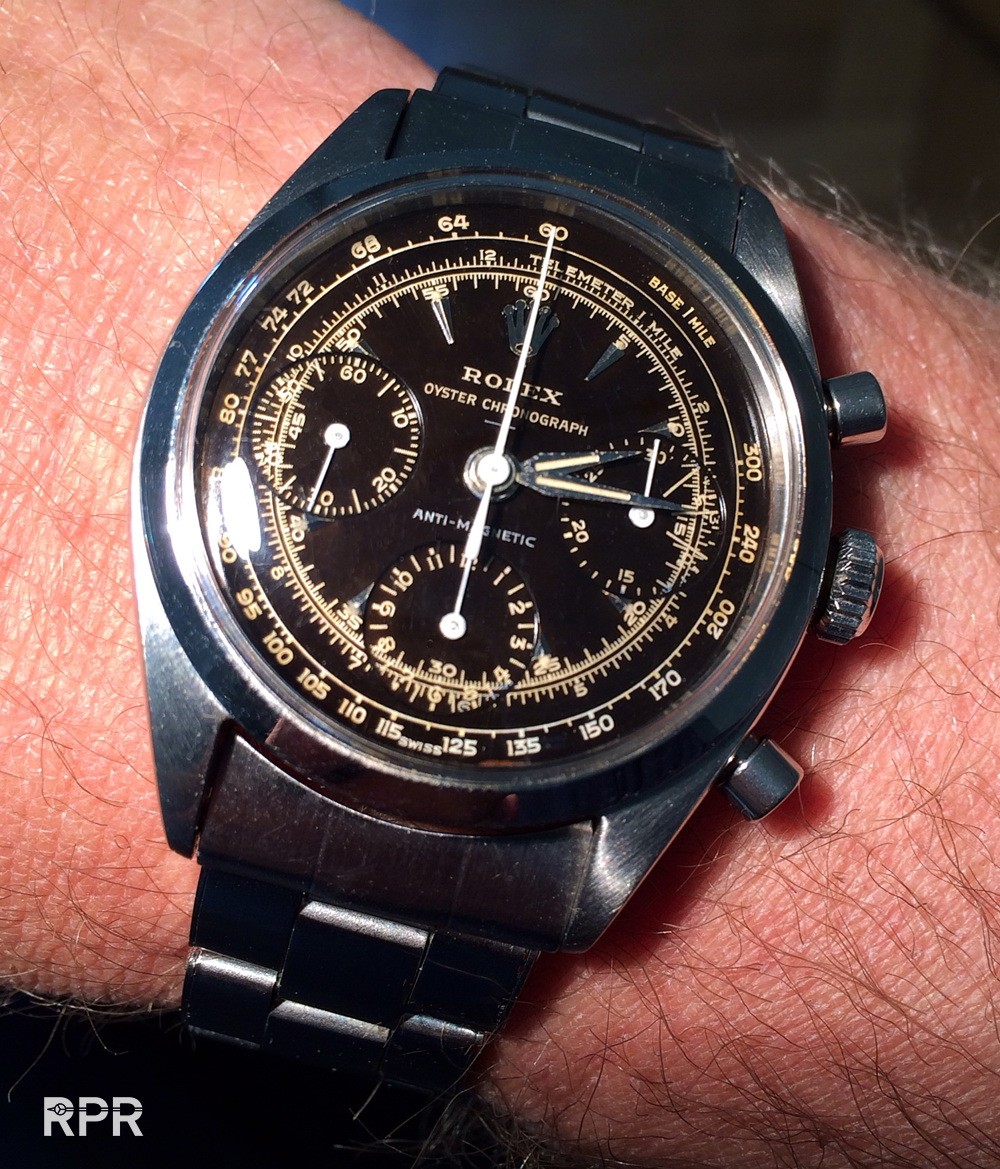 Side view of a 5512 SCOC “Underline dial with a close up of the tritium plots. We see they are puffy and also the white disc underneath are partly visible. The underline and SCOC text is added later on top of the lacquer, the rest of the print is punched into the dial, laying deeper..
Side view of a 5512 SCOC “Underline dial with a close up of the tritium plots. We see they are puffy and also the white disc underneath are partly visible. The underline and SCOC text is added later on top of the lacquer, the rest of the print is punched into the dial, laying deeper..  Yet another stunning transitional Sports Rolex, a 5512 minute track with underline, slightly earlier then the above example due to the close track.
Yet another stunning transitional Sports Rolex, a 5512 minute track with underline, slightly earlier then the above example due to the close track. 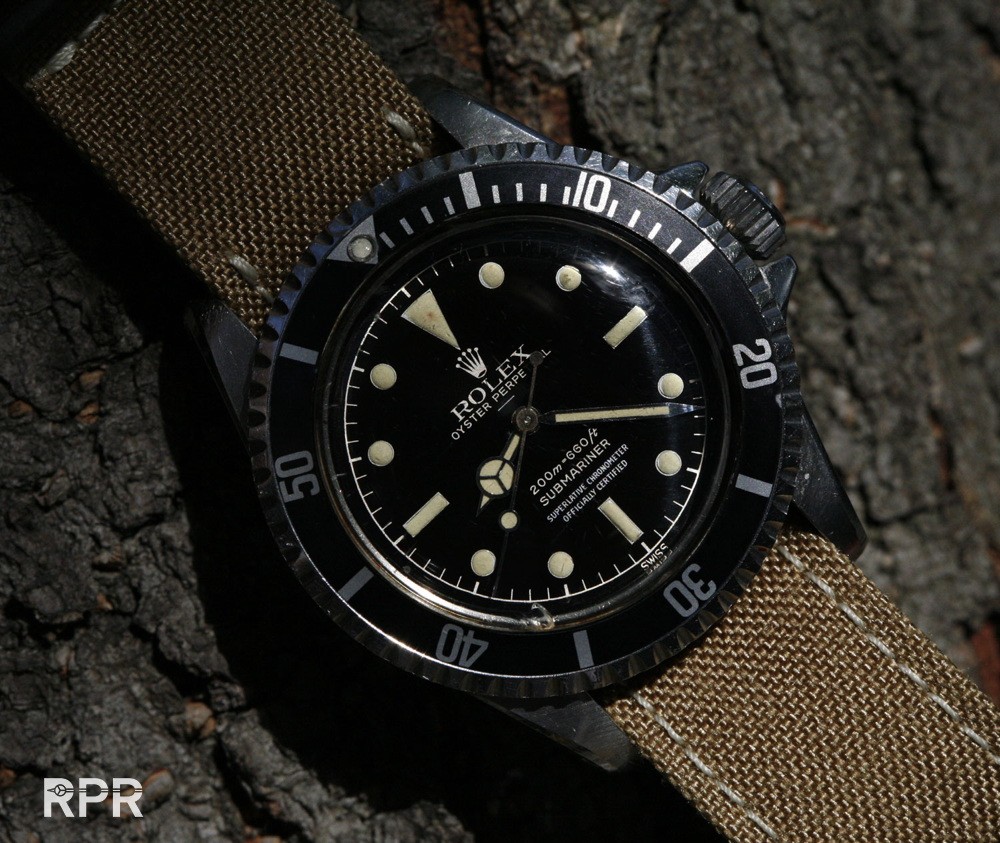
and here another late 4 line Chapter Ring ref 5512 with transitional “Underline”, probably one of the very last minute tracks..
Other watch manufactures used similar signing for the tritium mark, these below Tornek- Rayville US had also a “moisture meter” on the dial, chancing the upper half of the circle into the same color as under half once moisture entered into the watch case. VERY clever and innovative solution to protect your watch.  One of the very first Daytona’s Rolex delivered. A 922.xxx serial “Underline” with “Double Swiss” signing ( one swiss not visible as it’s located under the rehaut) The perfect voluminous tritium dots matches the color of the hands of this hardly worn exceptional rare Cosmograph..(follow the link to more vintage Rolex study)
One of the very first Daytona’s Rolex delivered. A 922.xxx serial “Underline” with “Double Swiss” signing ( one swiss not visible as it’s located under the rehaut) The perfect voluminous tritium dots matches the color of the hands of this hardly worn exceptional rare Cosmograph..(follow the link to more vintage Rolex study)  Explorer 1016 with of which we see the unique cracks in the glossy lacquer perfectly. You know also notice that the luminous on the markers and 3-6-9 are deeper in the dial located…
Explorer 1016 with of which we see the unique cracks in the glossy lacquer perfectly. You know also notice that the luminous on the markers and 3-6-9 are deeper in the dial located… 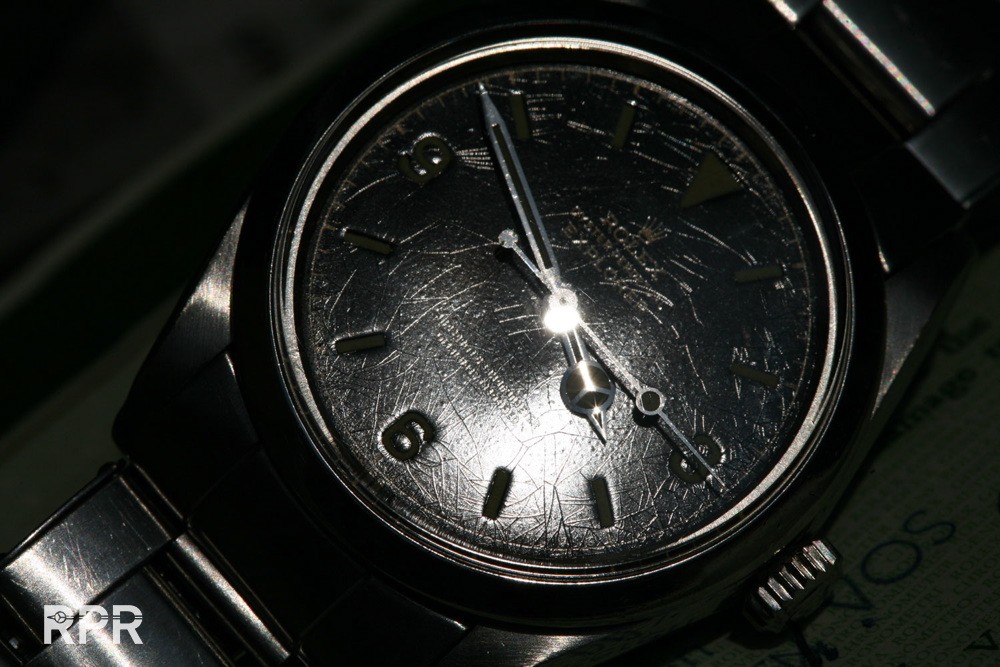 This “Underline Explorer 1016 has a tritium radiation, less the 0.25 Msv.
This “Underline Explorer 1016 has a tritium radiation, less the 0.25 Msv. 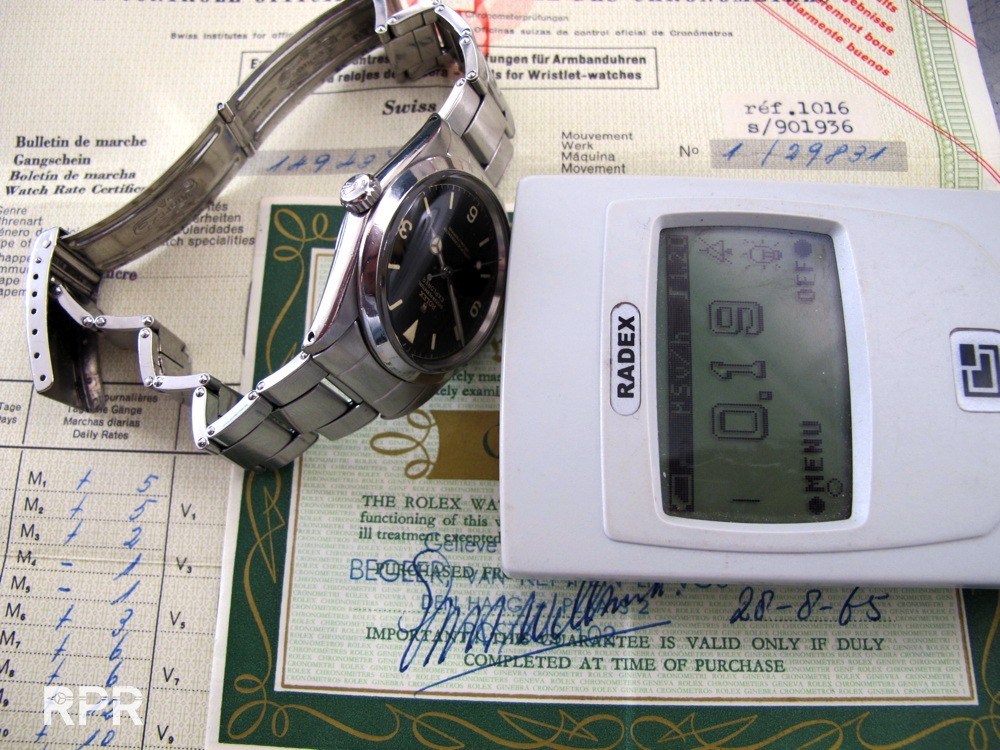 Close up of a rare service dial, one that only has a added “T” behind the radium SWISS, clearly added later and maybe a finished swiss dial that never got laminated and was used as service dial by adding the T and tritium. A Rolex service done after 1964 when international regulations forbid the use of radium.
Close up of a rare service dial, one that only has a added “T” behind the radium SWISS, clearly added later and maybe a finished swiss dial that never got laminated and was used as service dial by adding the T and tritium. A Rolex service done after 1964 when international regulations forbid the use of radium.  The “Swiss T<25” glossy tritium dial from 1964-1967…. showing some light “spiders” around the luminous plots…
The “Swiss T<25” glossy tritium dial from 1964-1967…. showing some light “spiders” around the luminous plots…
Next is a original owner Submariner sold by Bonhams in all the condition how the owner brought it in, untouched and some moisture stains on the glossy lacquer, something that can be cleaned of with ionized water…
The meaning of T SWISS T and its different versions.
- T = Tritium
- T SWISS T = Index in gold
- T Swiss Made T = Index in gold
- 0 T SWISS T 0 = Index in gold
- – TswissT – = Index in steel
- Swiss T < 25 = radiation lower then 25 Milli Curi Ci.
A overnieuw from one of the most successful references Rolex ever made, the Submariner ref 5512/3 from 1959 till mid 80-ies.. 
Below some NOS (New Old Stock) Rolex and Tudor dials that have a rich patina due to the fact they where stored in the dark and haven’t seen the light for many years…
The coming of the seventies chanced the dial surface from glossy to a modern matte surface, here a Ref 1016 Explorer with nicely aged tritium luminous. The with the previous glossy dials so matching gold print chanced with the matte dials to a modern white print… 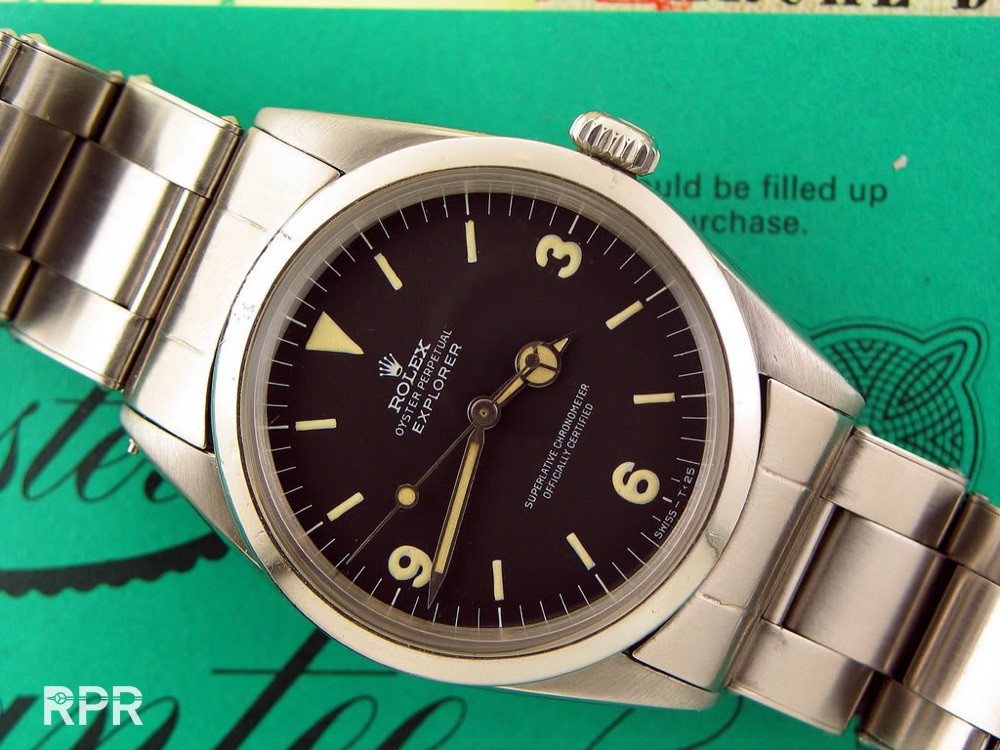 The more yellowish color of the tritium is cleverly visible in next experimental Rolex SeaDweller. The iconic “Single Red ref 1665”. Matt dial, white print, note also that the printed DATE behind oyster perpetual is much bigger in text. The red Sea Dweller text perfectly covers the white text underneath, first examples of this legendary reference had a 500m = 1650 Ft depth rate..
The more yellowish color of the tritium is cleverly visible in next experimental Rolex SeaDweller. The iconic “Single Red ref 1665”. Matt dial, white print, note also that the printed DATE behind oyster perpetual is much bigger in text. The red Sea Dweller text perfectly covers the white text underneath, first examples of this legendary reference had a 500m = 1650 Ft depth rate..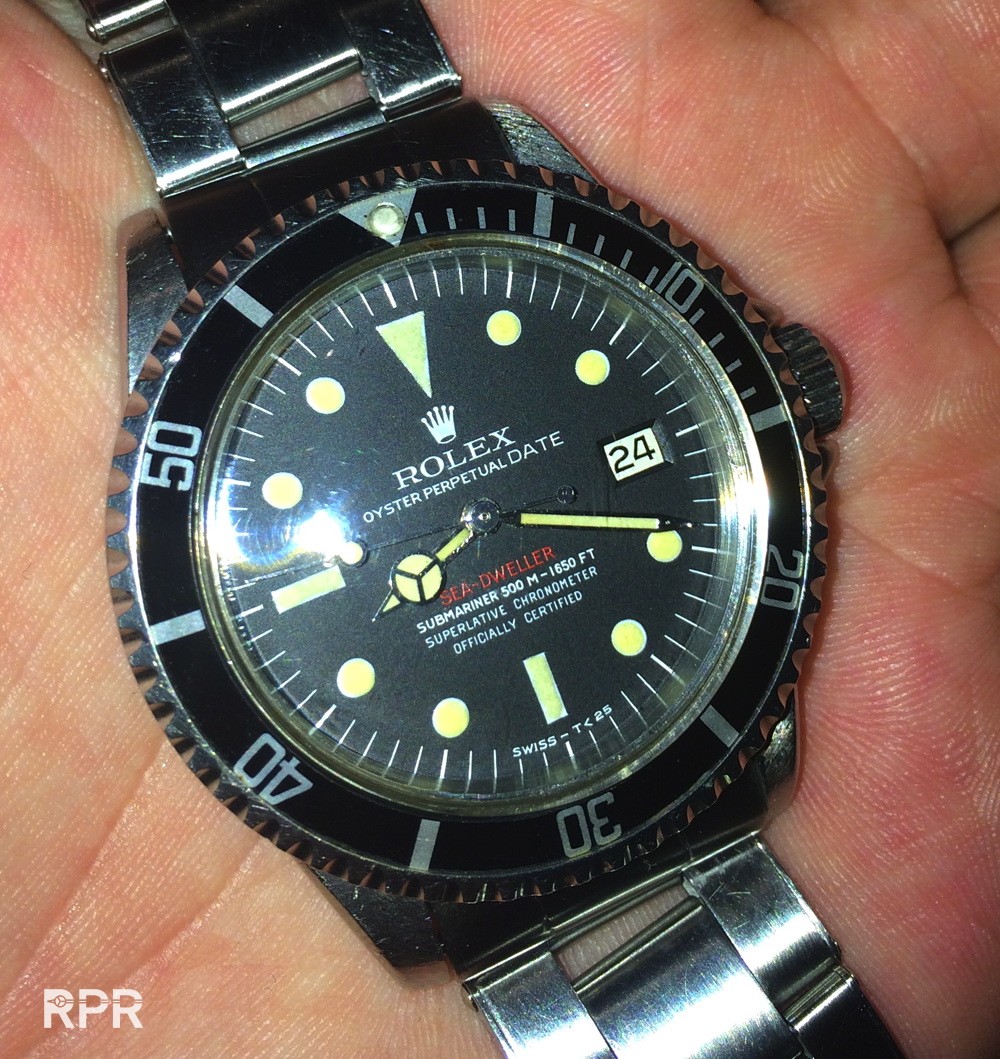 Shortly later, end 60ies, came the Red Submariner Ref 1680, of which many different version have been made.. (follow the link to more vintage Rolex study)
Shortly later, end 60ies, came the Red Submariner Ref 1680, of which many different version have been made.. (follow the link to more vintage Rolex study) 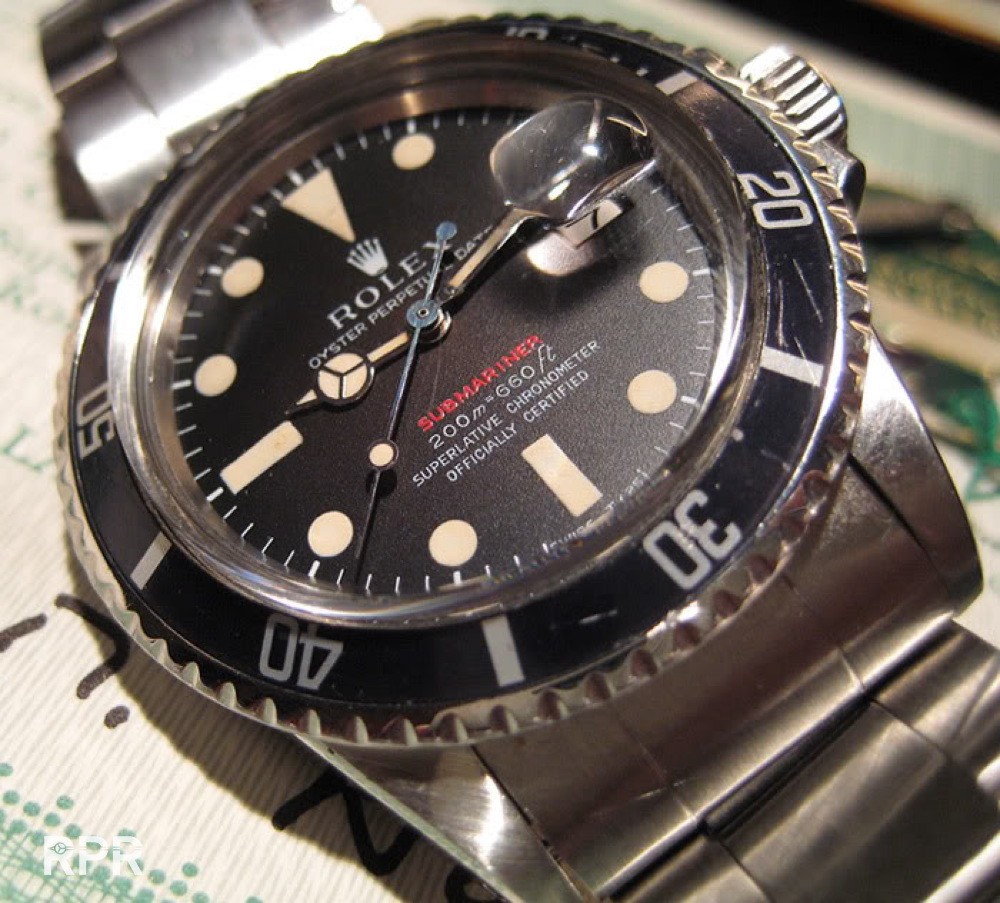
Heavy patinated Ref 1665 for Qaboos in like NOS condition…
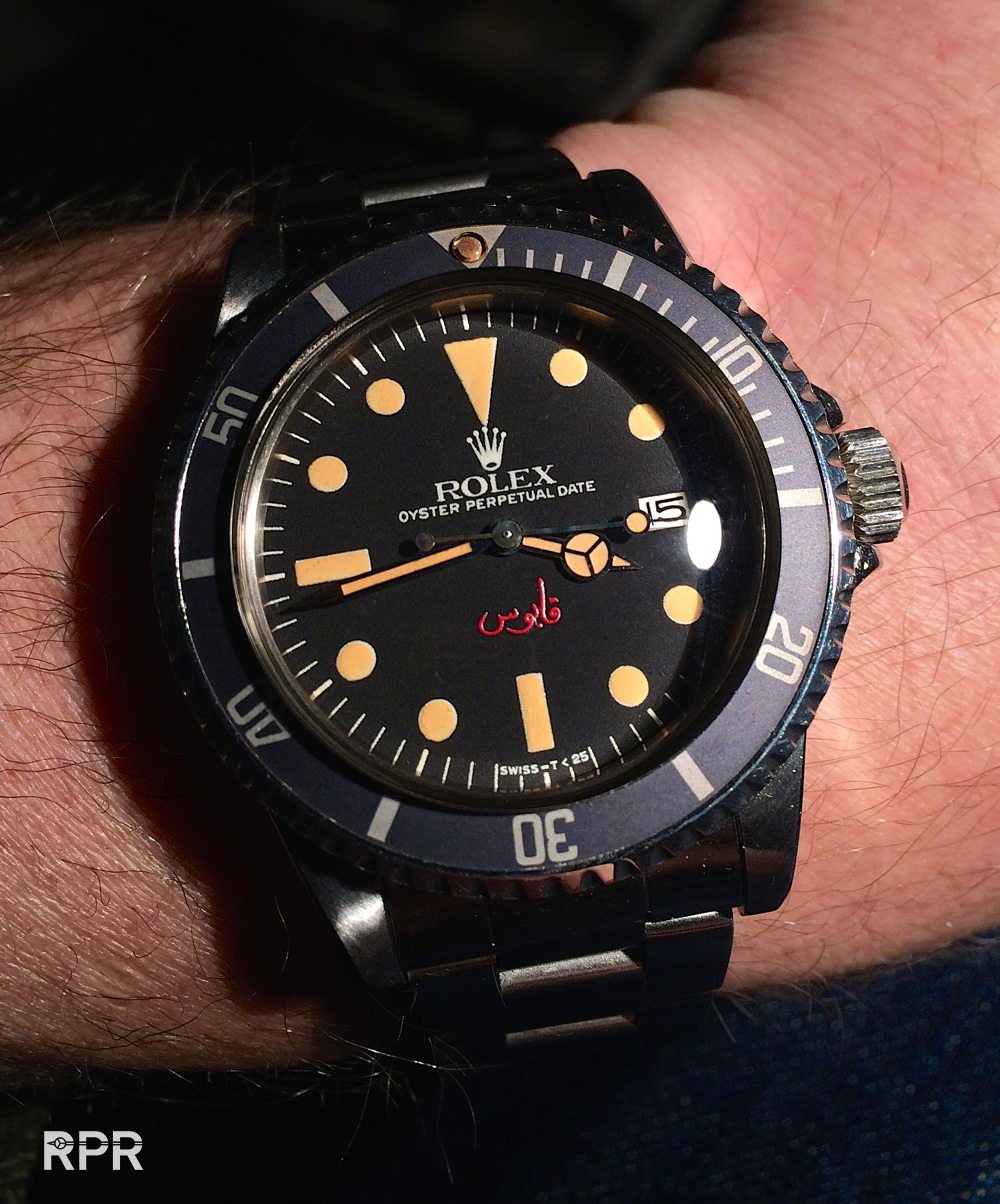 A “T Swiss T” Daytona ( having 1/3 of the tritium as a more luminated Submariner or GMT ) Nicely aged dots are matching the color of the hands.
A “T Swiss T” Daytona ( having 1/3 of the tritium as a more luminated Submariner or GMT ) Nicely aged dots are matching the color of the hands.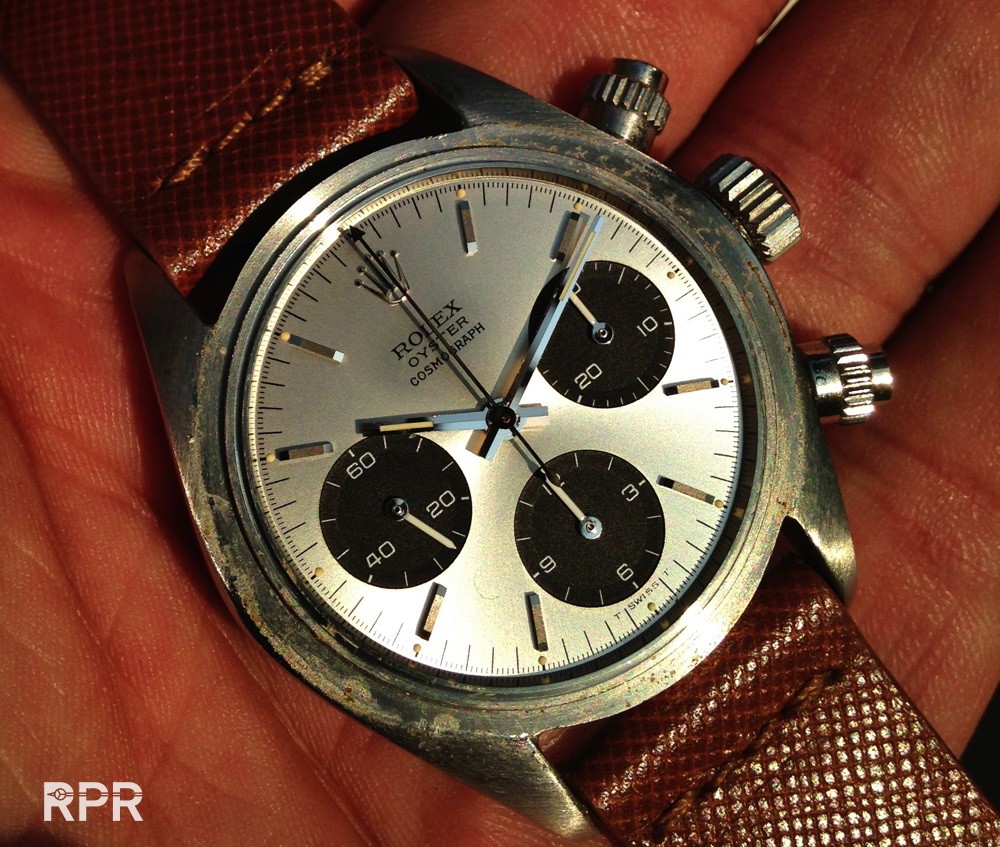
You see below the lume dots of the Newman dial are bit bigger due to the fact the where placed against the typical square newman index…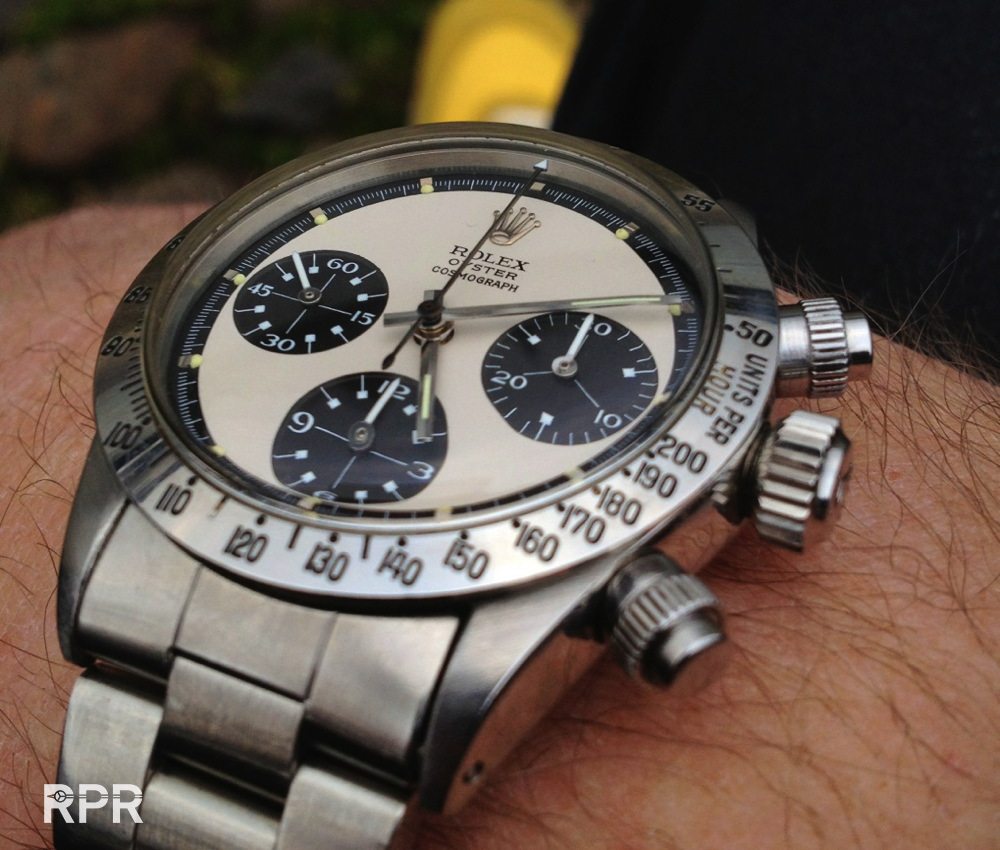
Here we see the tritium light up under ultra violet light, shortly after you did this, the bright color will fade away and stay visible in the dark for another minute or 2. 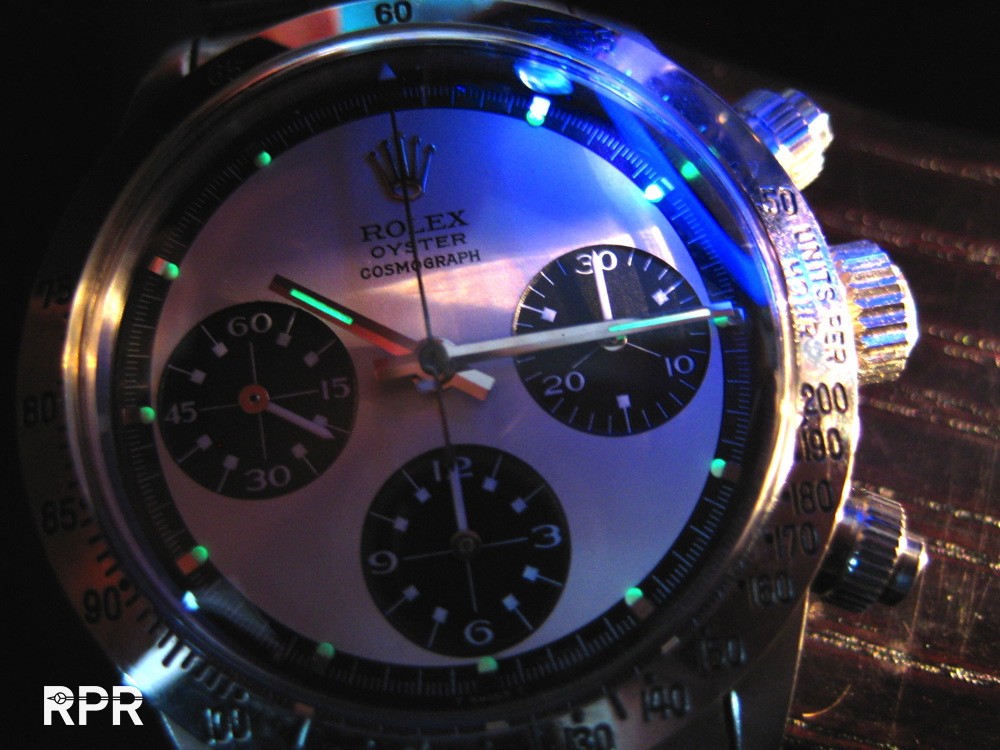 In daylight we see the luminous is creamy colored, once activated with UV light it become bright green.
In daylight we see the luminous is creamy colored, once activated with UV light it become bright green. 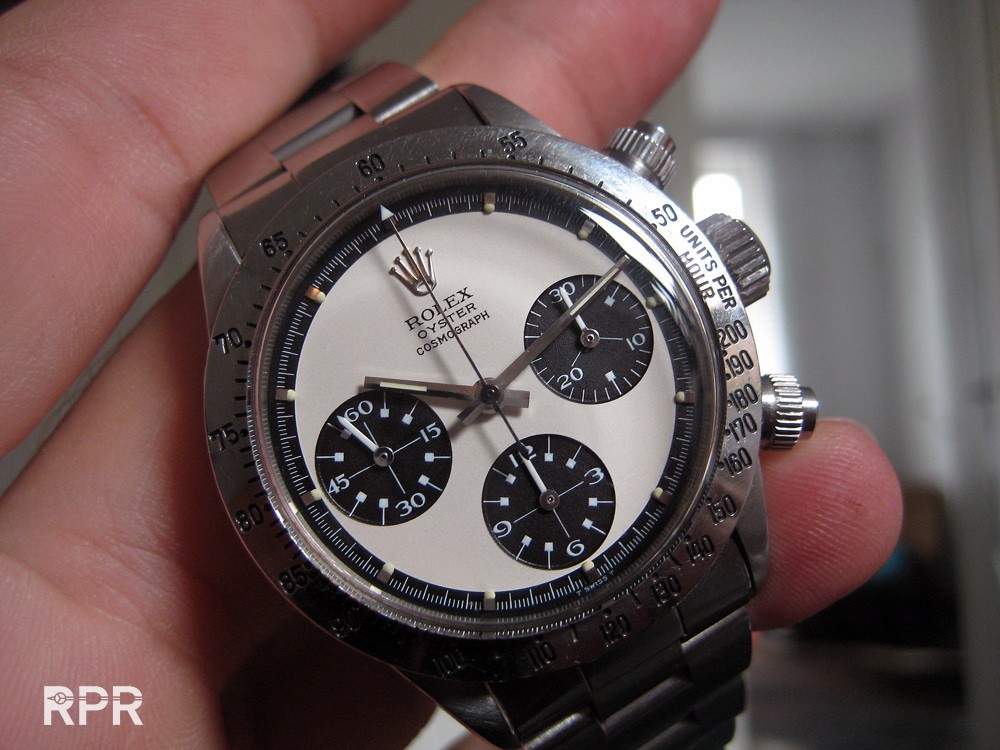
3 x perfectly aged and all intact Oyster Paul Newmans…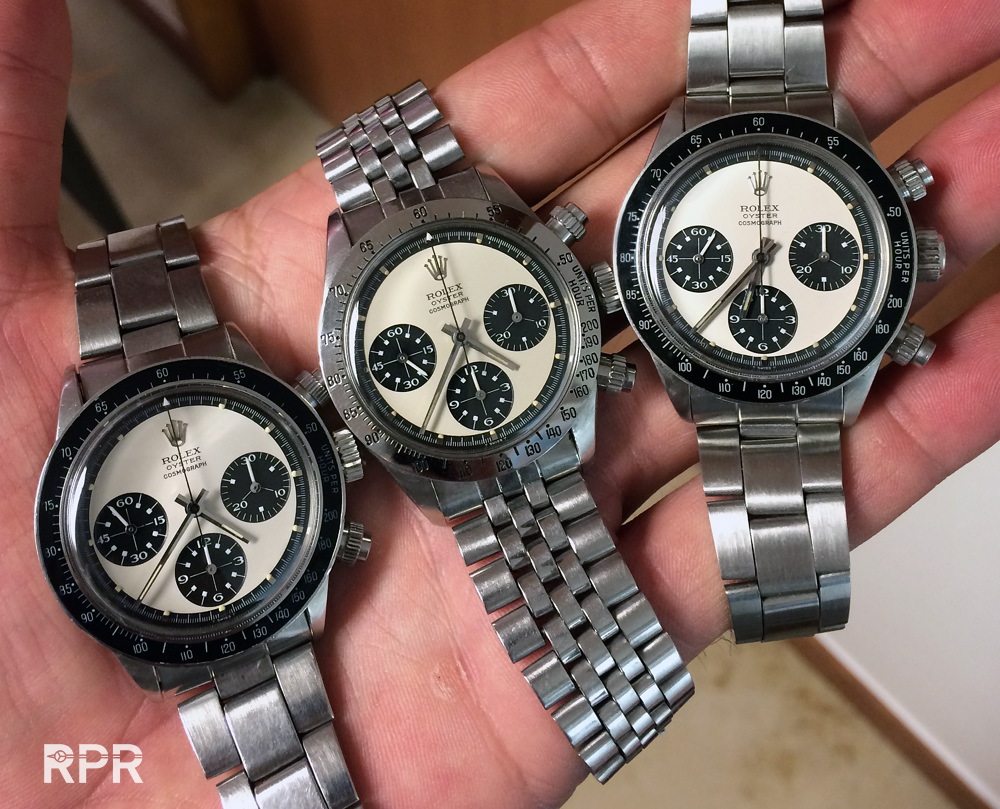
Up close a detail of the structure of how a original aged tritium dots looks like, spongy. 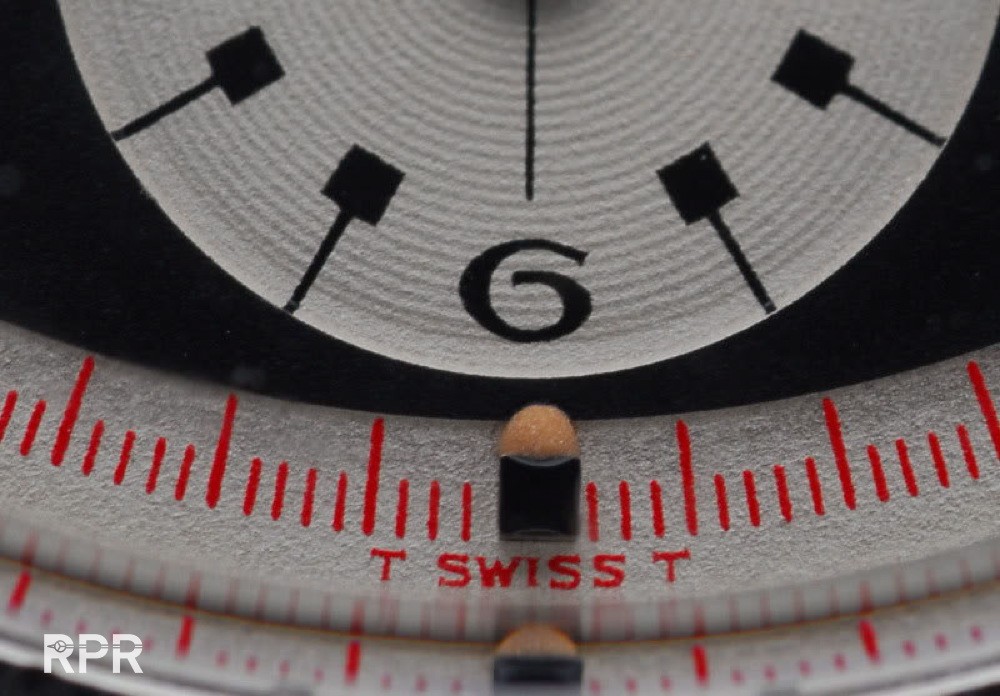
2 nicely aged unrestored Cosmograph’s with perfect matching tritium luminous.. 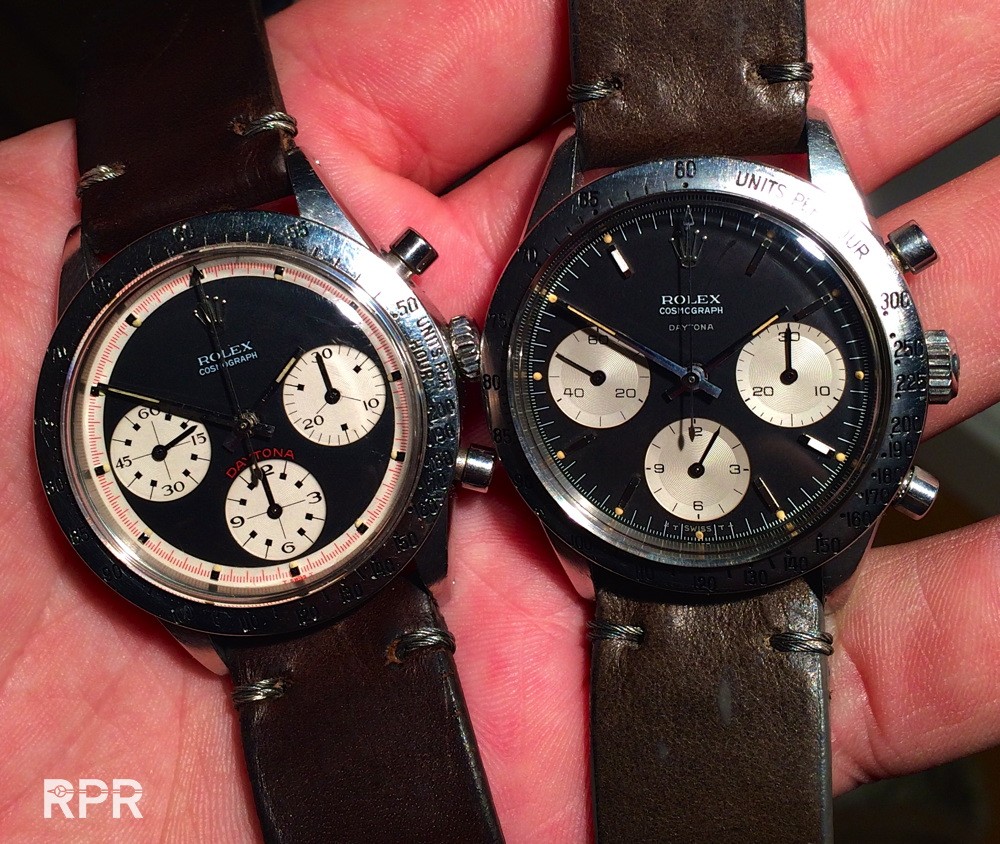
We see that sometimes the lume dot has been moved, most probably due to a hard hit like falling on the ground or so..
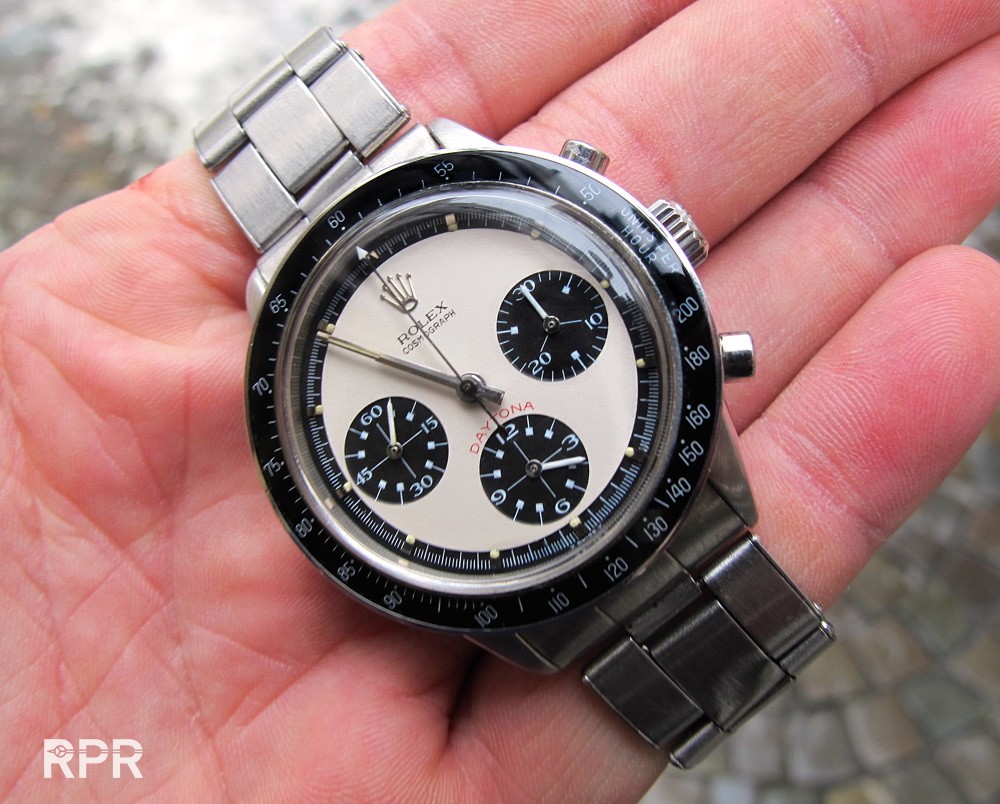 Around the beginning of the 70-ies we see on several Sports Rolex that the black paint of the dial changed during the years to a tropical brown tone. This was most probably due to the fact that the dial maker mixed his black color with plenty of red pigment and due to the exposure to the UV light, the black faded to brown. Something we particularly see on Meter first Red Sub’s, MK2 Seadweller’s and GMT Masters but also on regular 5513 Subs or Daytona’s from around 1968-1972.
Around the beginning of the 70-ies we see on several Sports Rolex that the black paint of the dial changed during the years to a tropical brown tone. This was most probably due to the fact that the dial maker mixed his black color with plenty of red pigment and due to the exposure to the UV light, the black faded to brown. Something we particularly see on Meter first Red Sub’s, MK2 Seadweller’s and GMT Masters but also on regular 5513 Subs or Daytona’s from around 1968-1972. 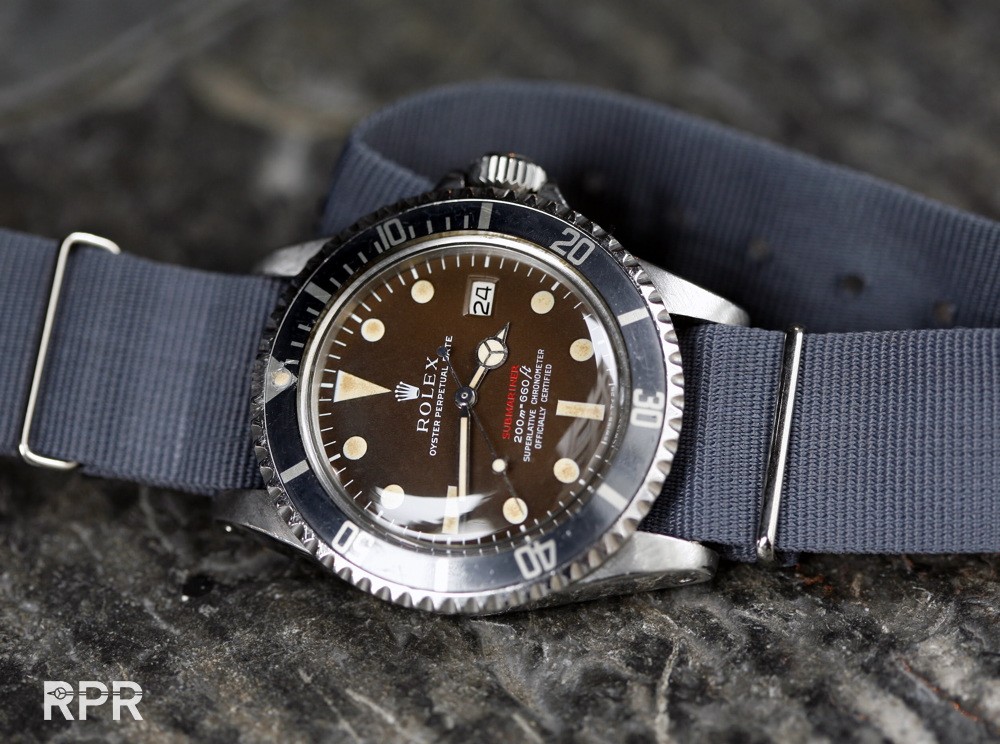 A MK2 thin case Double Red Seadweller with tropical dial. The red and white paint is as usual with matte dials added on top of the dial, without any lacquer over it. On single and double Red Rolex dials we often see that the tritium luminous is very thin, sometimes even more white then creamy colored.
A MK2 thin case Double Red Seadweller with tropical dial. The red and white paint is as usual with matte dials added on top of the dial, without any lacquer over it. On single and double Red Rolex dials we often see that the tritium luminous is very thin, sometimes even more white then creamy colored. 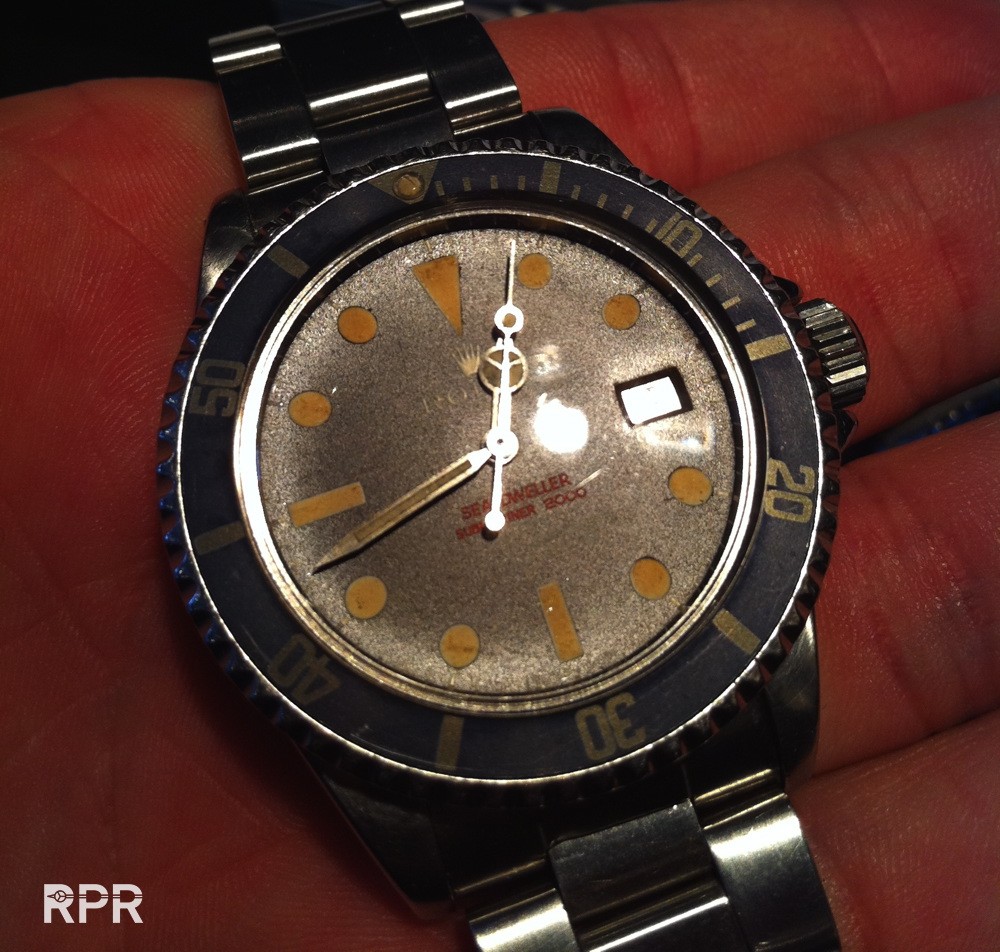
Dark chocolate ref 1680 from the first serie, with meter first…
 A Sigma ( white gold markers around 1970) T swiss T Daytona with faded tritium dots and tropical brown sub dials
A Sigma ( white gold markers around 1970) T swiss T Daytona with faded tritium dots and tropical brown sub dials 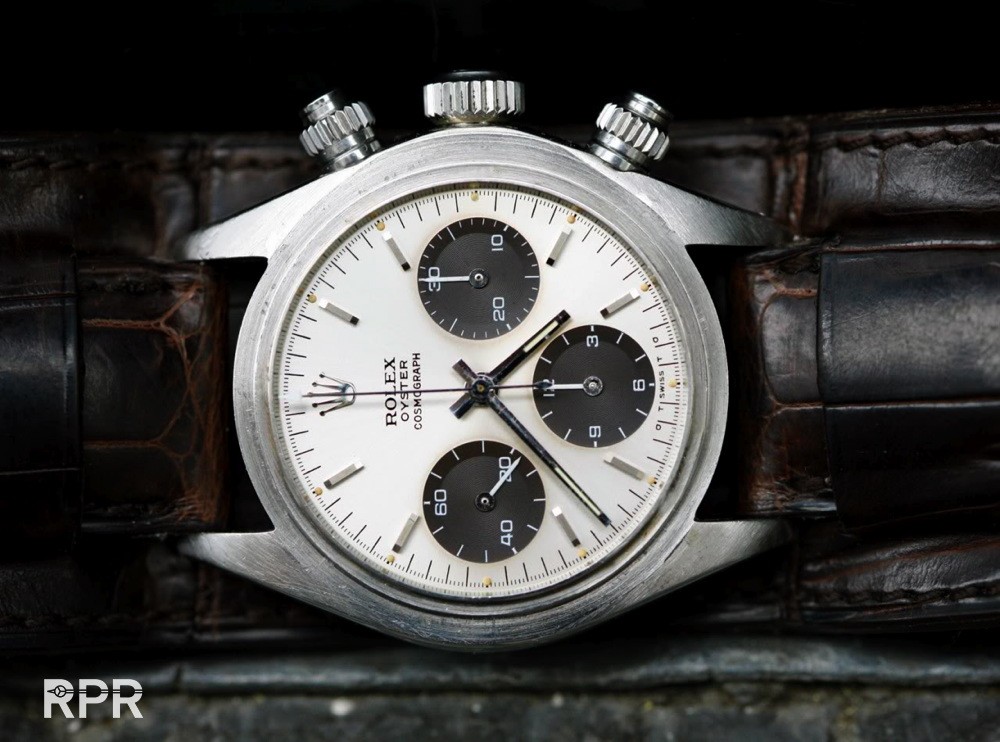 All black sigma Daytona from first owner in untouched original condition. Perfect matching luminous shows a perfect condition of the dial..
All black sigma Daytona from first owner in untouched original condition. Perfect matching luminous shows a perfect condition of the dial.. 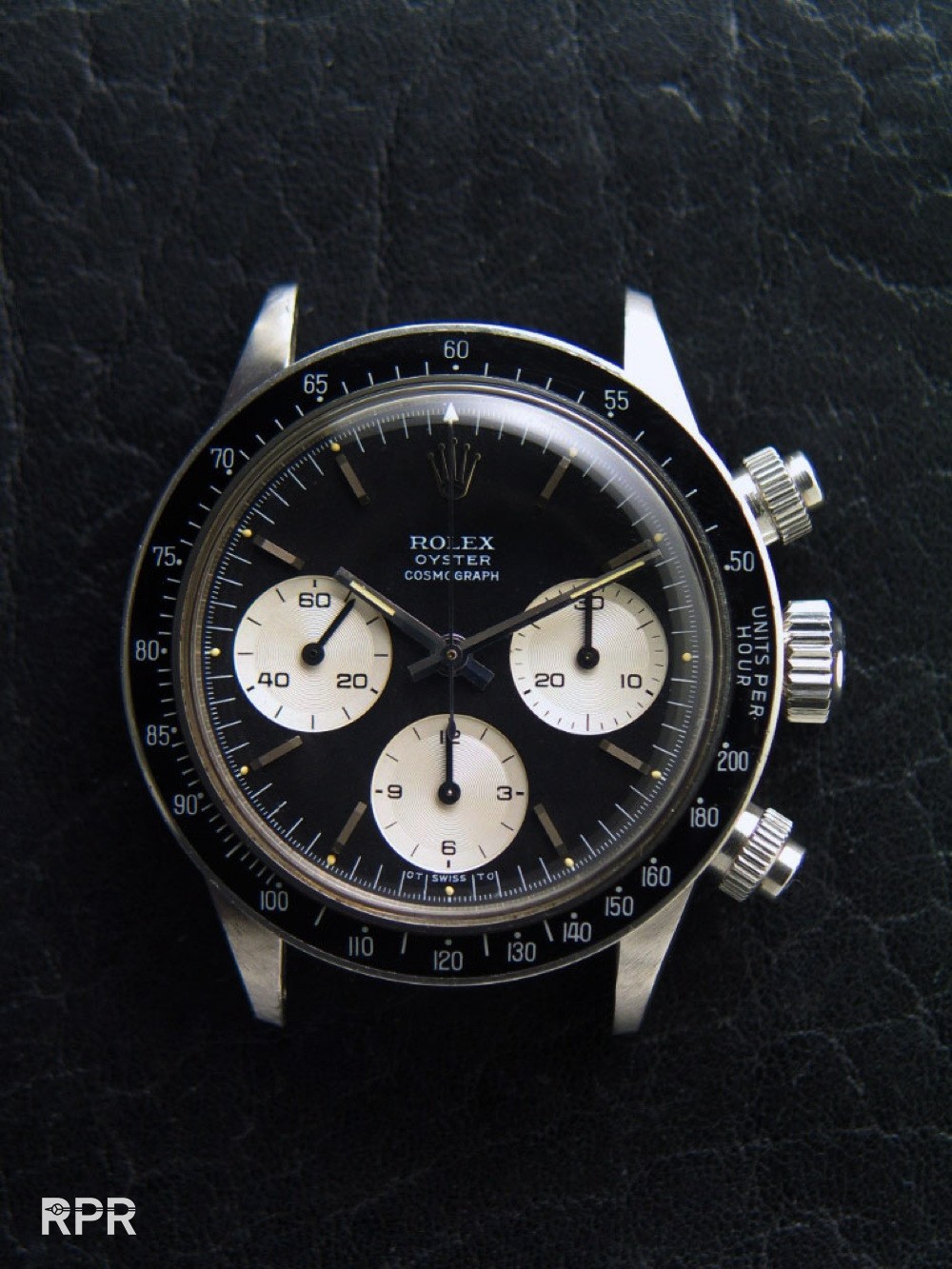
Here below we see a modern interpretation Rolex Geneva made for a client, gold print of a modern design, toned luminous…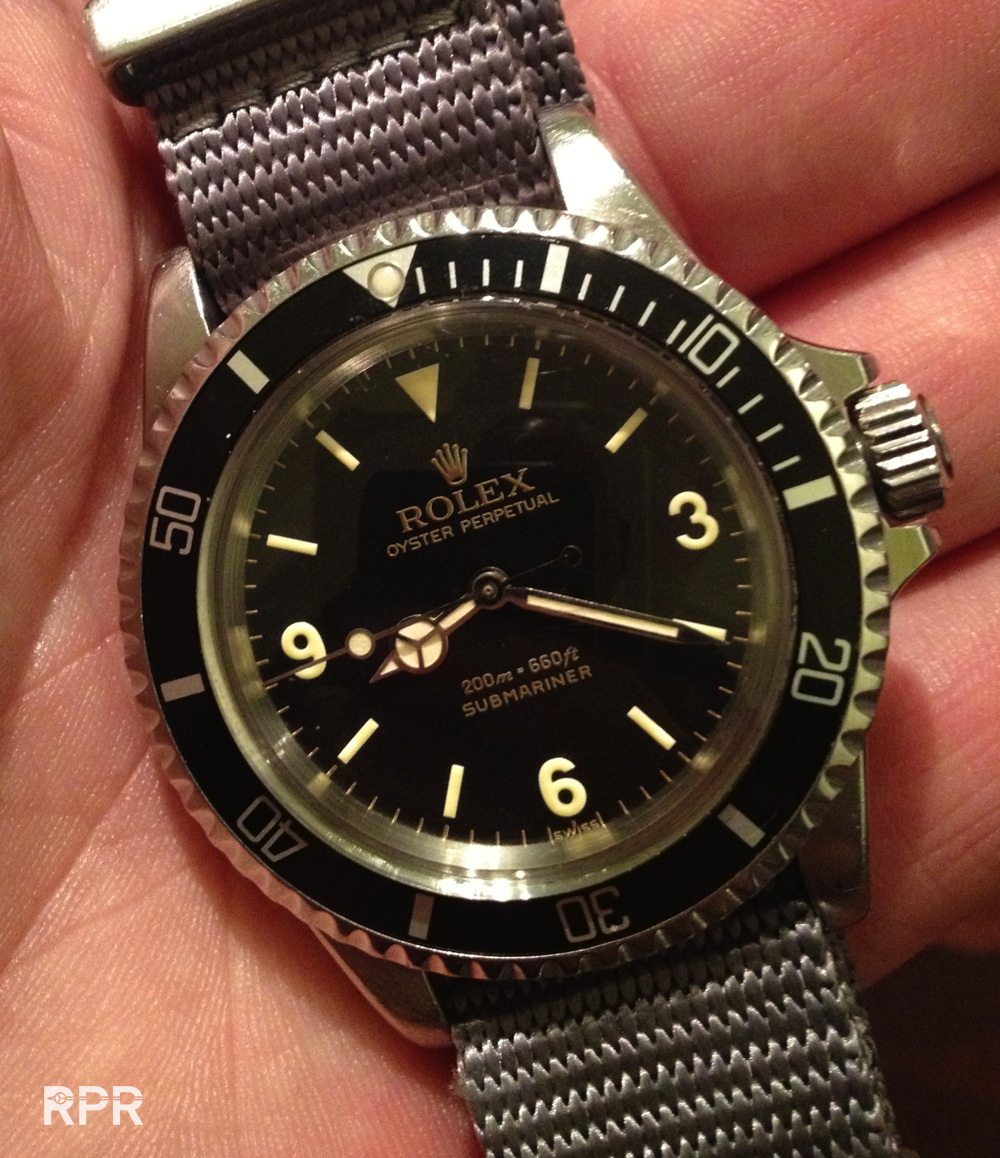
This has been offered for auction by the previous owner, clearly we see the matt dial making it a mixture of wrong decisions. Original 369 Explorer dials where printed in galvanic technique, making the text lay dieper, the surface was glossy, the typo was matching the date of 1962-1965 when these iconic beauties. I personally think it’s not ok and I heard they stopped doing this.
But then it looks like Rolex is using their heritage look at Tudor for a one-off modern interpretation of their ref 7923…
Yet another special Rolex lume we see with the Milgauss ref 1019, there where the dots are normally round, they are square now..
2 x creamy colored tritium Explorer’s, both untouched and still in their original condition. All 3 belonged to Sir Edmund Hillary… 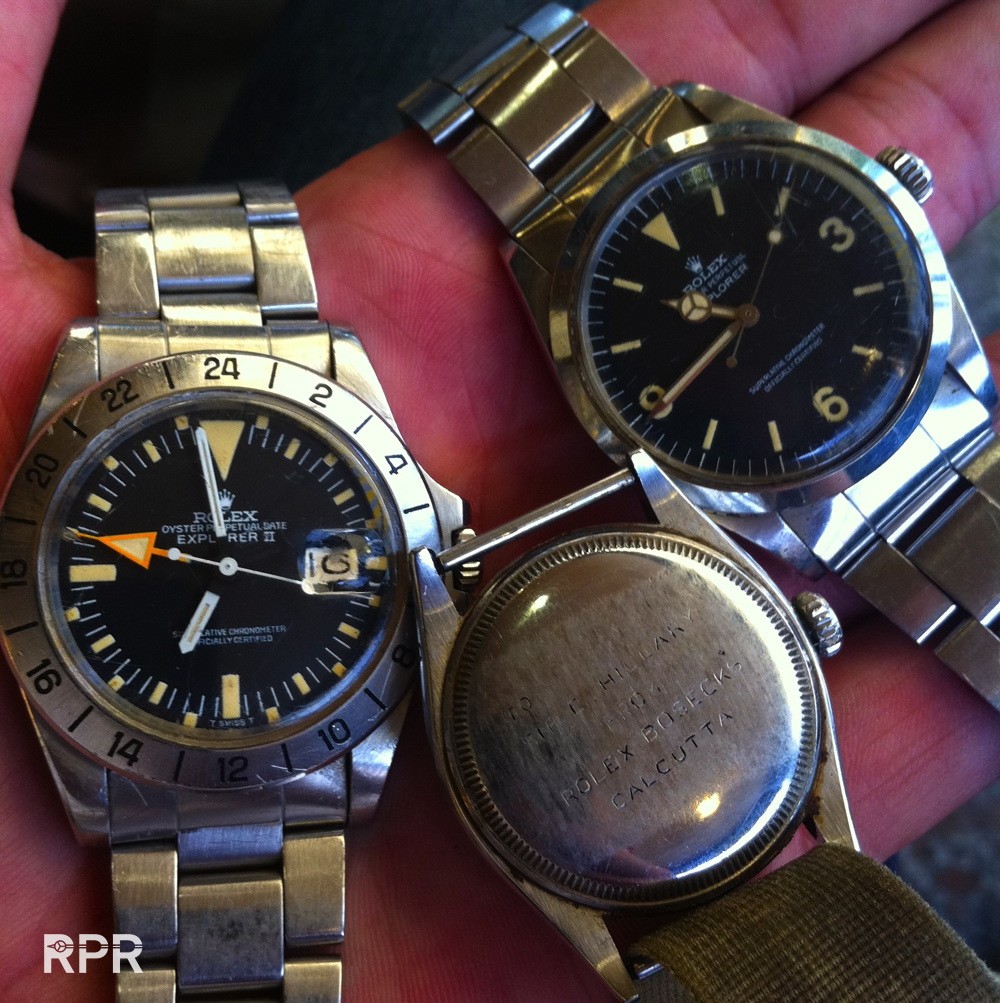
Fat Ref 5513 matte Submariner tritium plots that are so big they touch the track on the outside… 
Or no luminous at all on this blue Submariner prototype ref 5513 made by “Singer” for Rolex in 1967…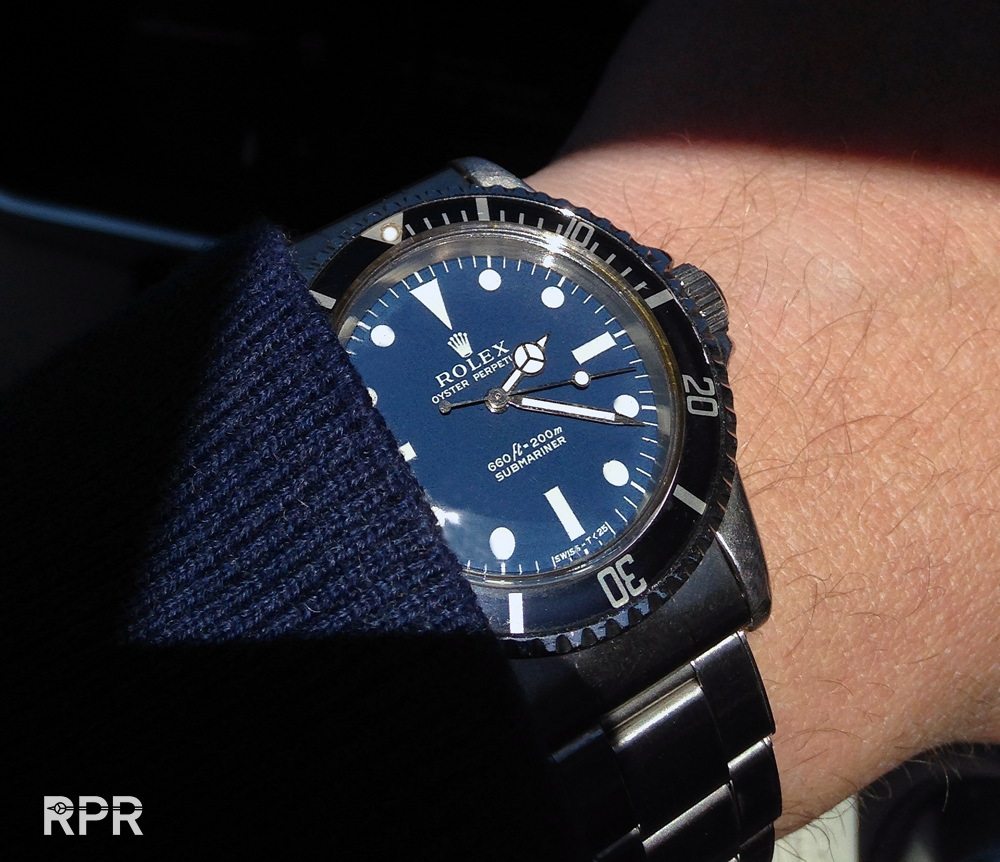 Ref 1665 as MK 3 DRSD on the left next to a little later by “Stern” manufactured “Rail Dial”…
Ref 1665 as MK 3 DRSD on the left next to a little later by “Stern” manufactured “Rail Dial”…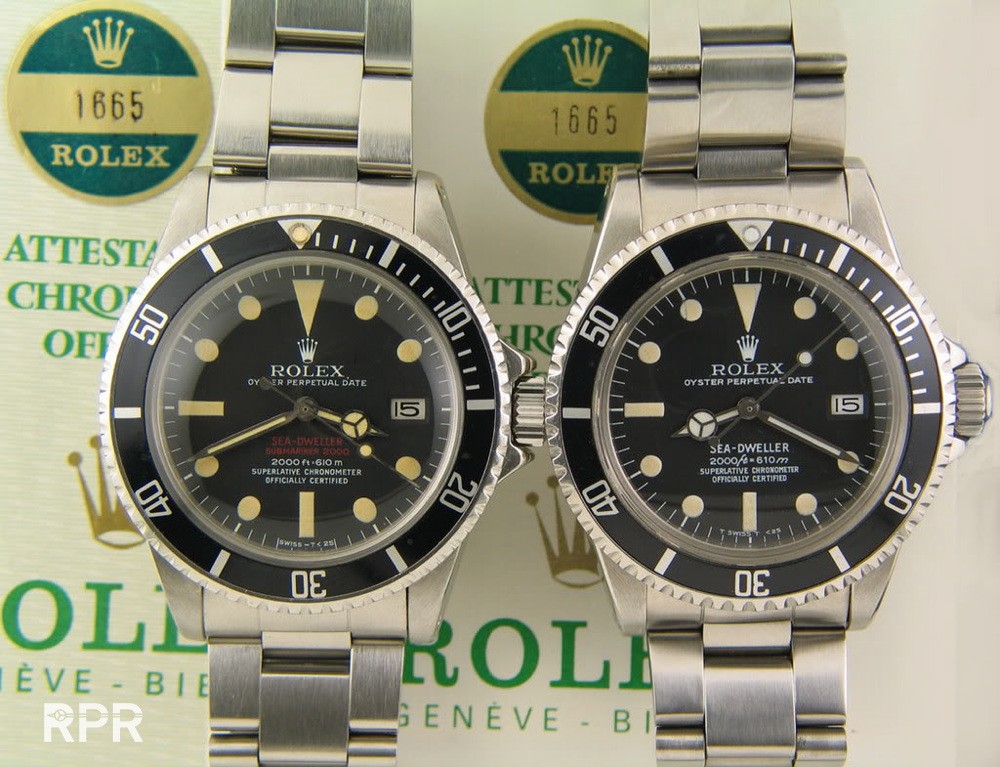
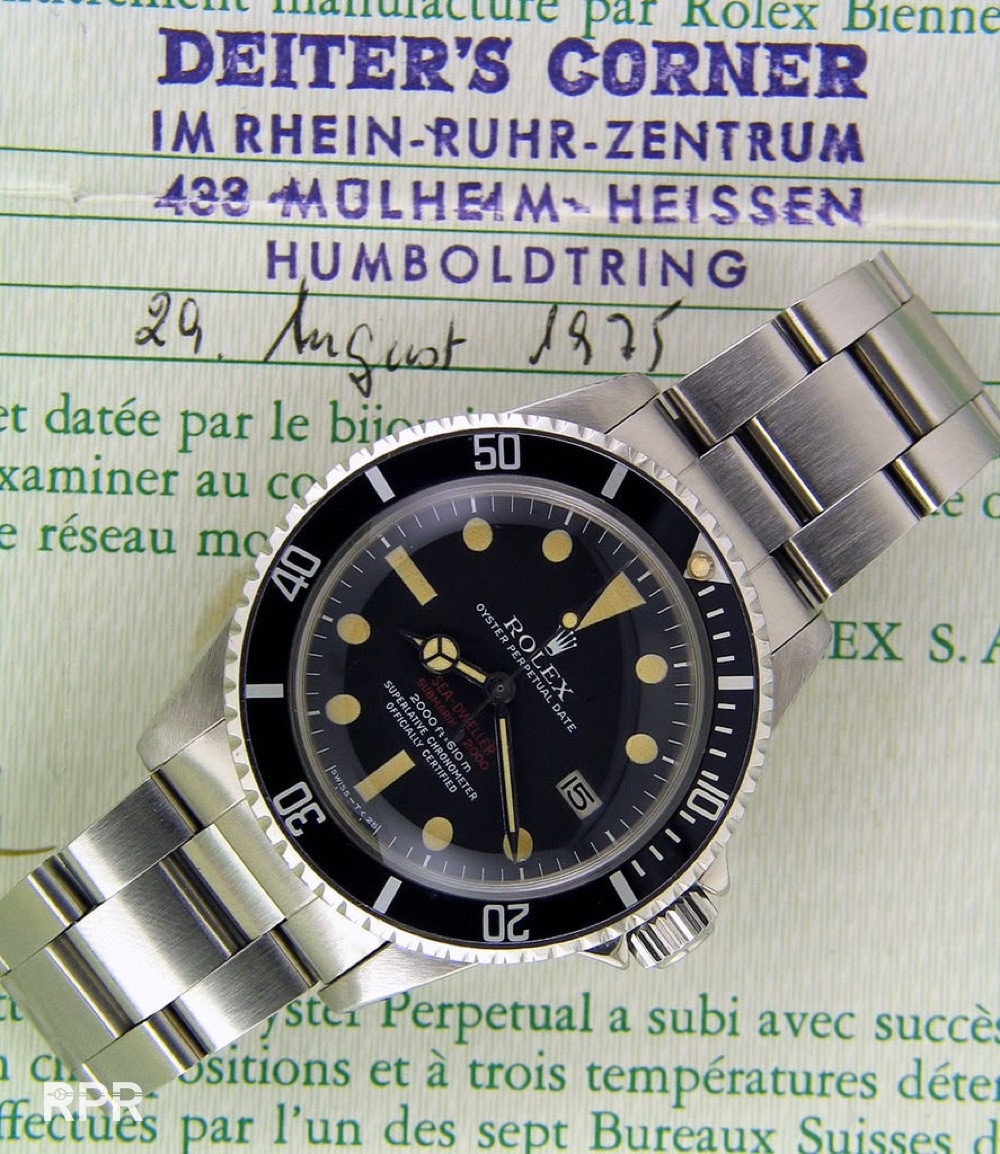 Deep Orange colored NOS dial and hands that chanced to this brilliant tone after being stored for a long time in the dark.
Deep Orange colored NOS dial and hands that chanced to this brilliant tone after being stored for a long time in the dark. 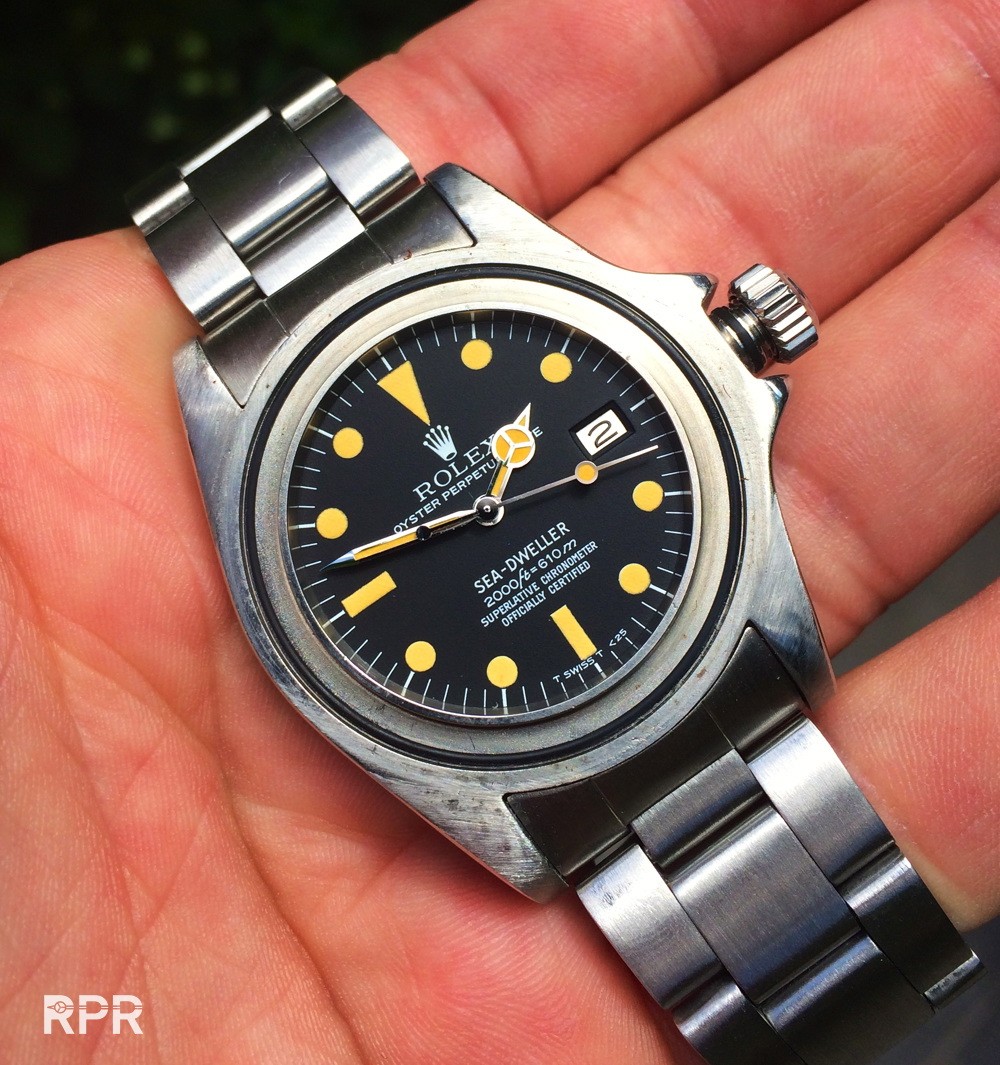 2 x Rail Dial on the top, followed by a Mk2 with tropical brown dial and a Mk 4 with matt black dial…
2 x Rail Dial on the top, followed by a Mk2 with tropical brown dial and a Mk 4 with matt black dial… 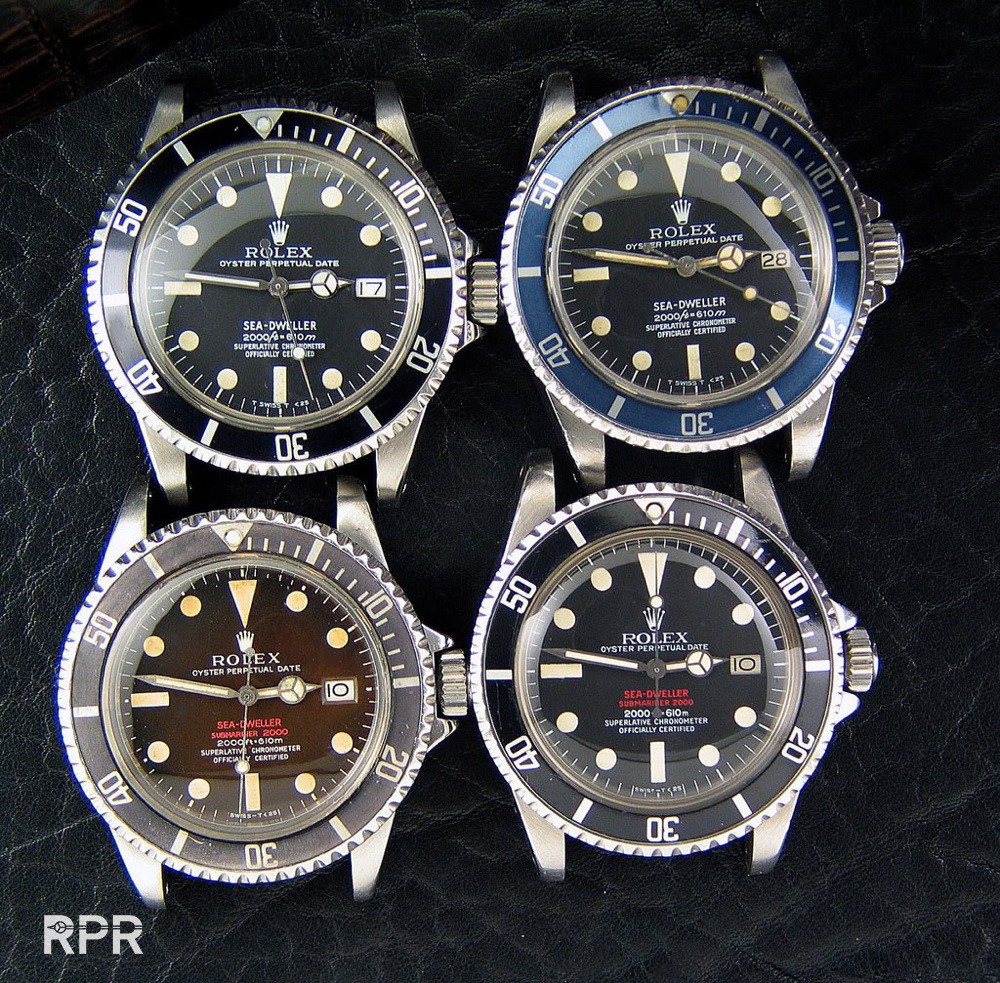 Close up of a naked Comex Seadweller ref 1665…
Close up of a naked Comex Seadweller ref 1665… 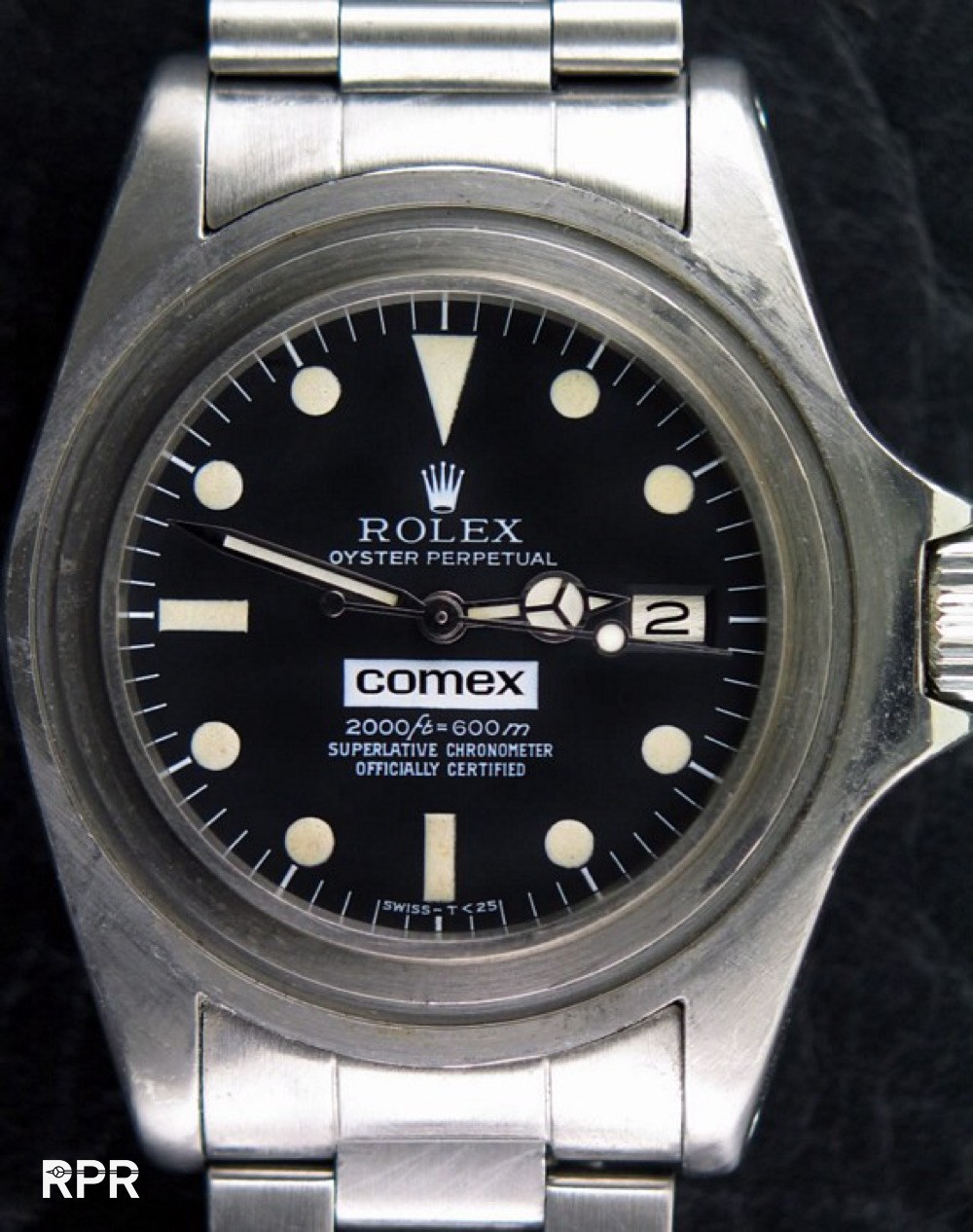 A later ref 1680 with feet first Red Submariner with very light colored tritium…
A later ref 1680 with feet first Red Submariner with very light colored tritium… 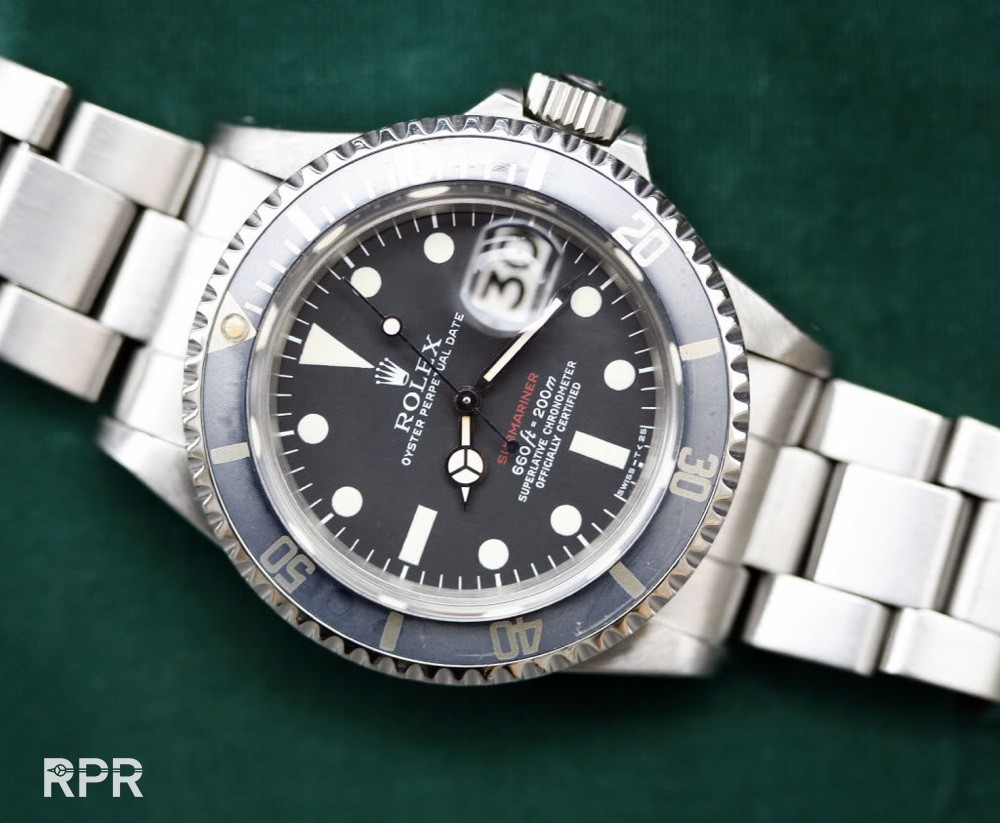 A Big Red Daytona Cosmograph with nicely voluminous tritium dots..
A Big Red Daytona Cosmograph with nicely voluminous tritium dots.. 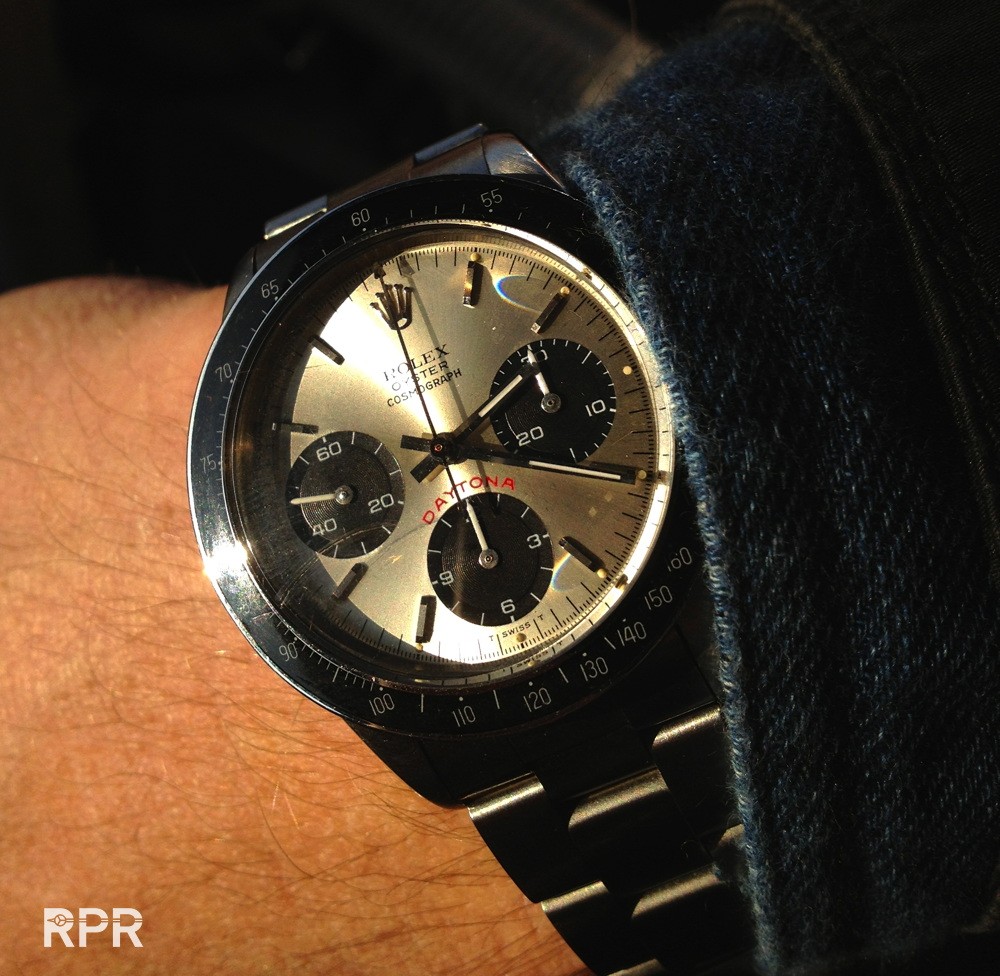 The transitional Submariner from plexi to sapphire crystal, ref 16800 & 168000. Matt dials in modern case, with anti scratch crystal was the way forward..
The transitional Submariner from plexi to sapphire crystal, ref 16800 & 168000. Matt dials in modern case, with anti scratch crystal was the way forward.. 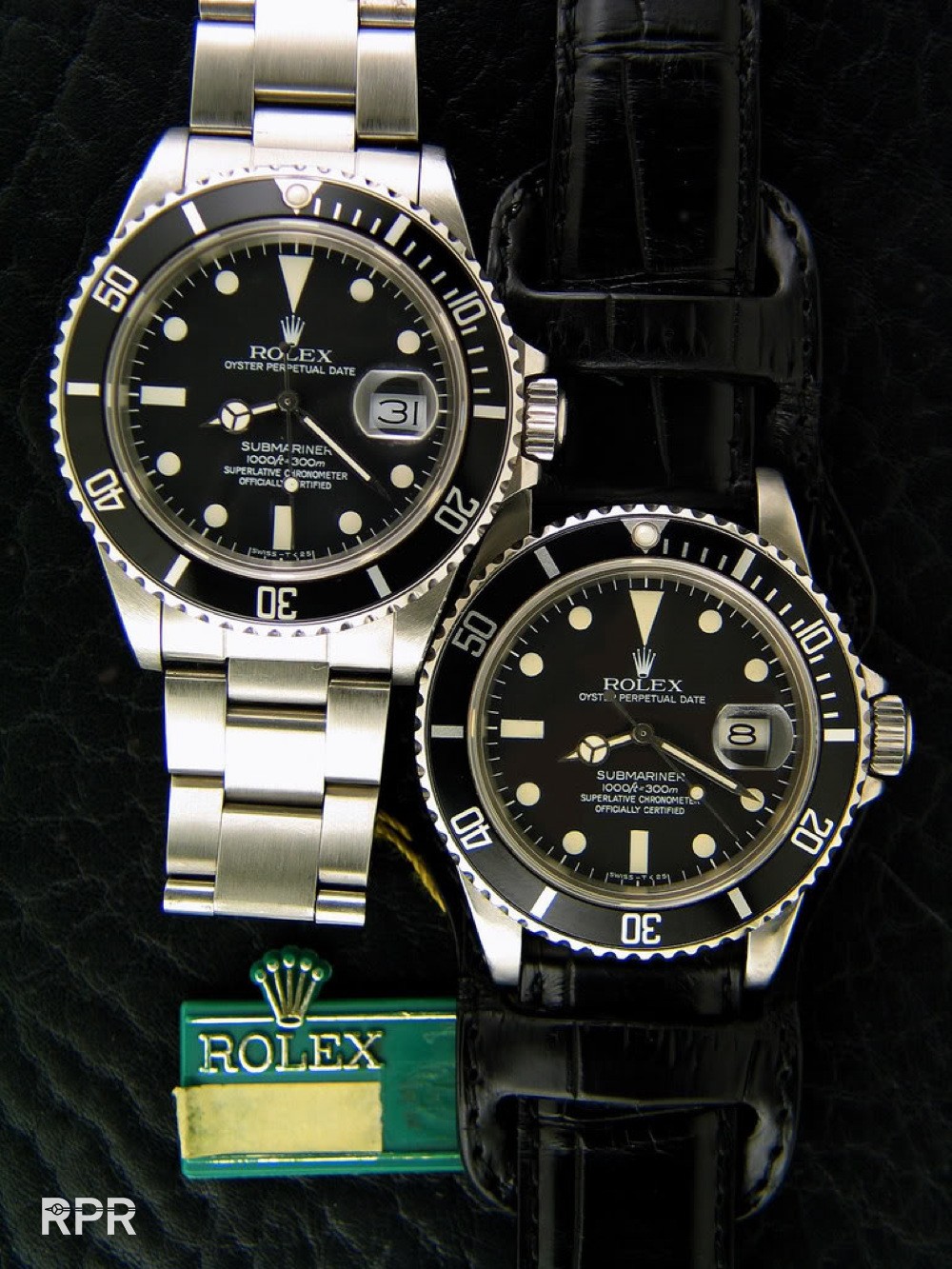 A safe queen ref 16800 that spend it’s life in the dark. Note the heavy patina on the dial and tritium dot of the bezel, there where the hands typically for this reference, chanced muchness in color tone..
A safe queen ref 16800 that spend it’s life in the dark. Note the heavy patina on the dial and tritium dot of the bezel, there where the hands typically for this reference, chanced muchness in color tone..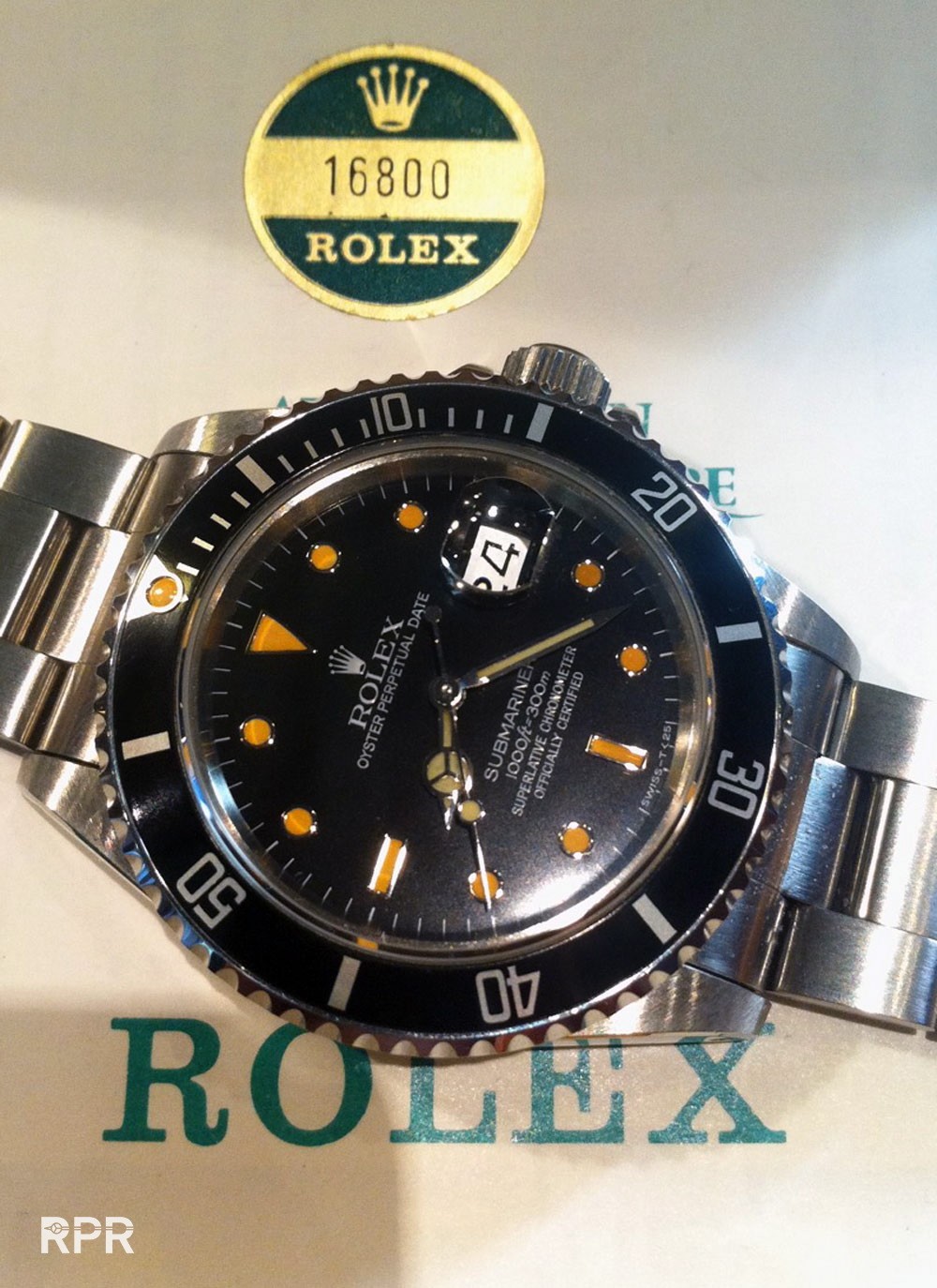 I hope you’ve enjoyed my “The Evolution of Vintage Rolex Luminous and Dial Production”. In the near future I will add more detailed information as collecting vintage Rolex is a never ending story. If you have any questions, please feel free to contact me directly: info@RolexPassionReport.com
I hope you’ve enjoyed my “The Evolution of Vintage Rolex Luminous and Dial Production”. In the near future I will add more detailed information as collecting vintage Rolex is a never ending story. If you have any questions, please feel free to contact me directly: info@RolexPassionReport.com
